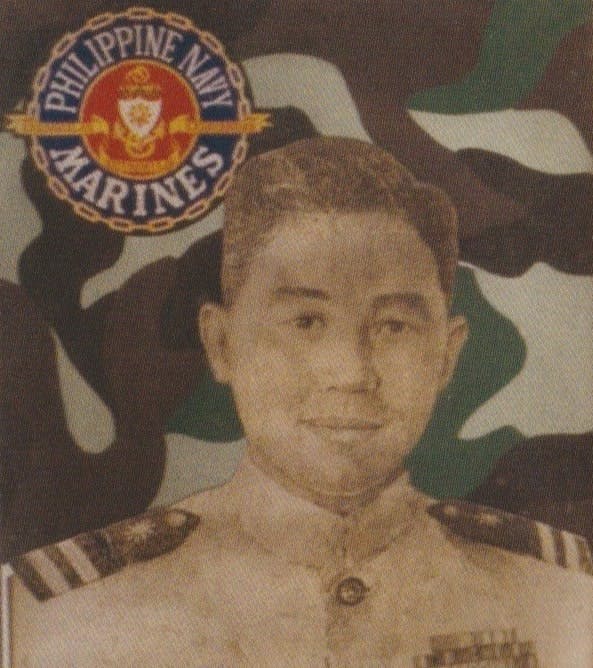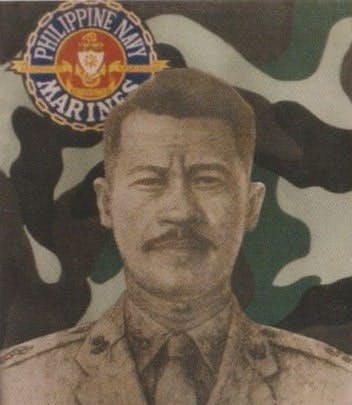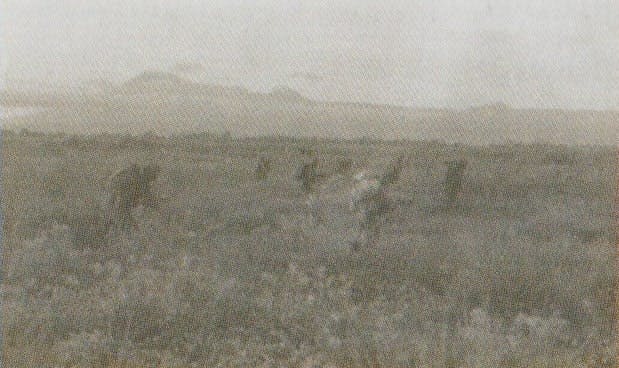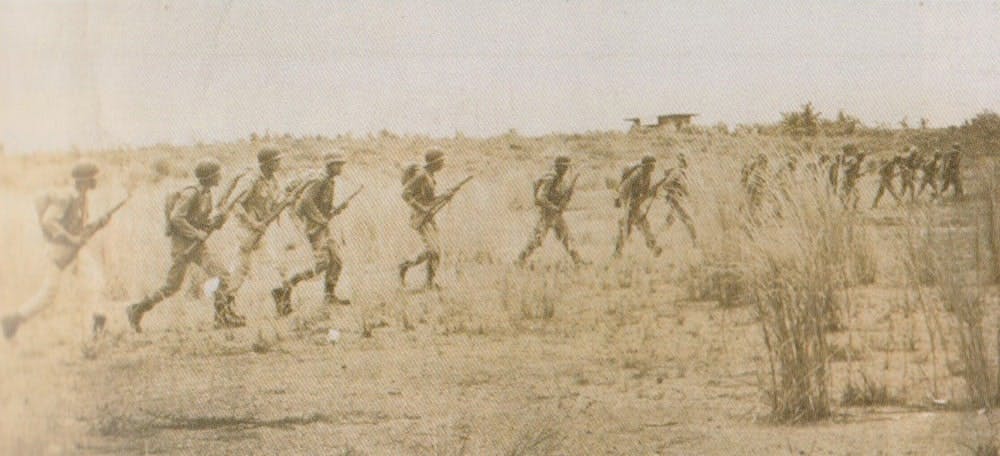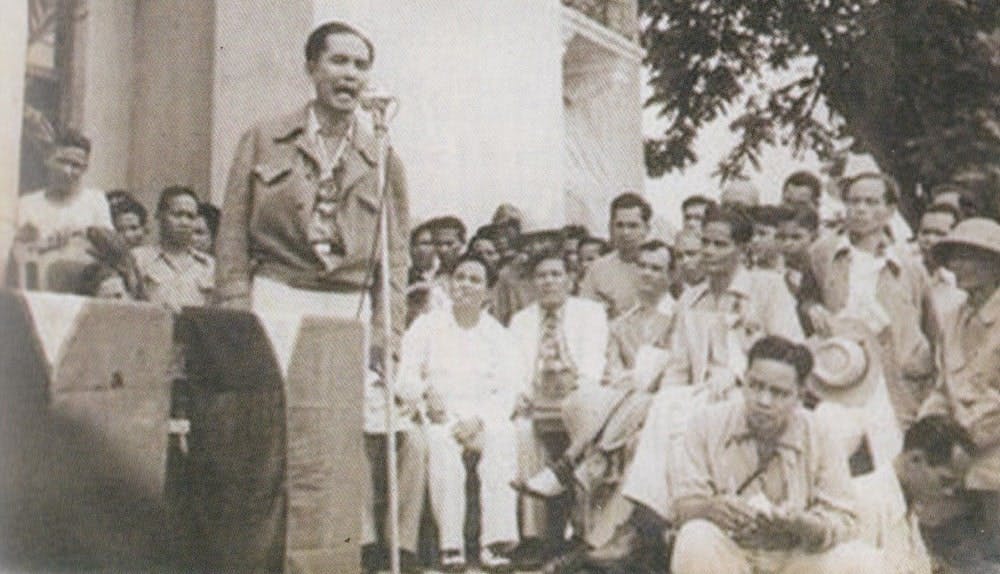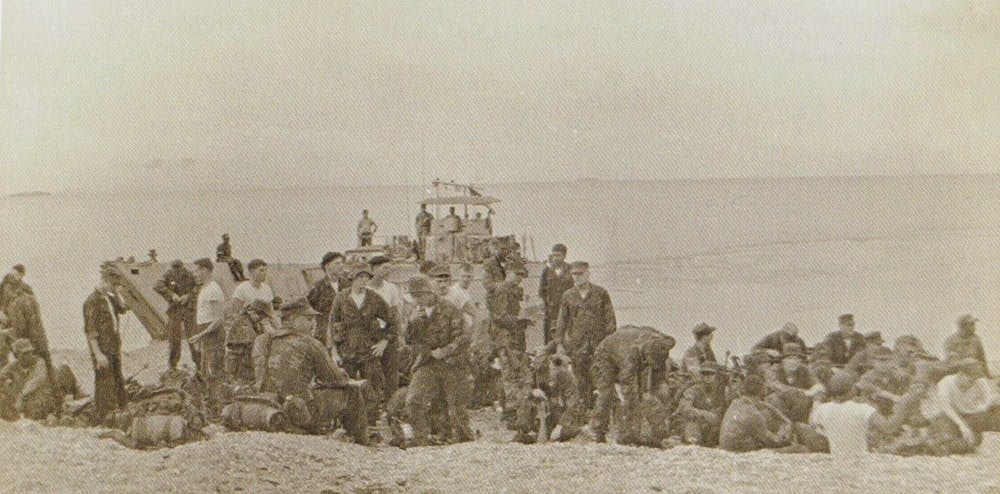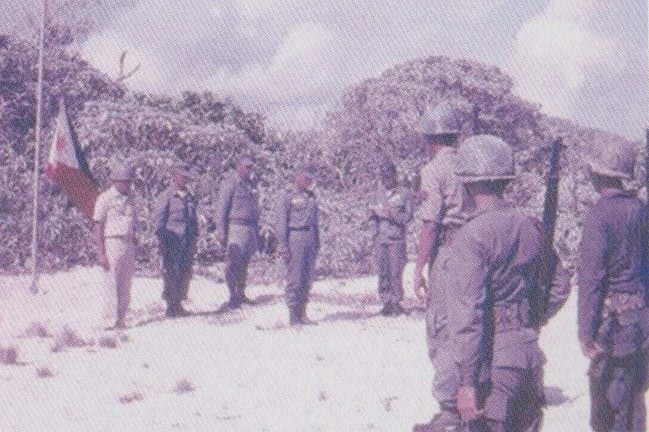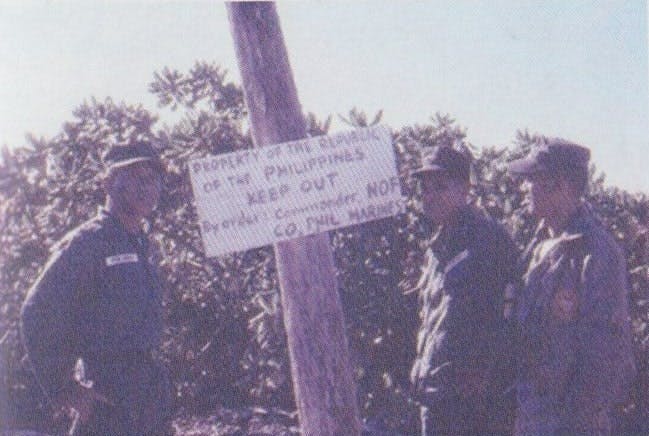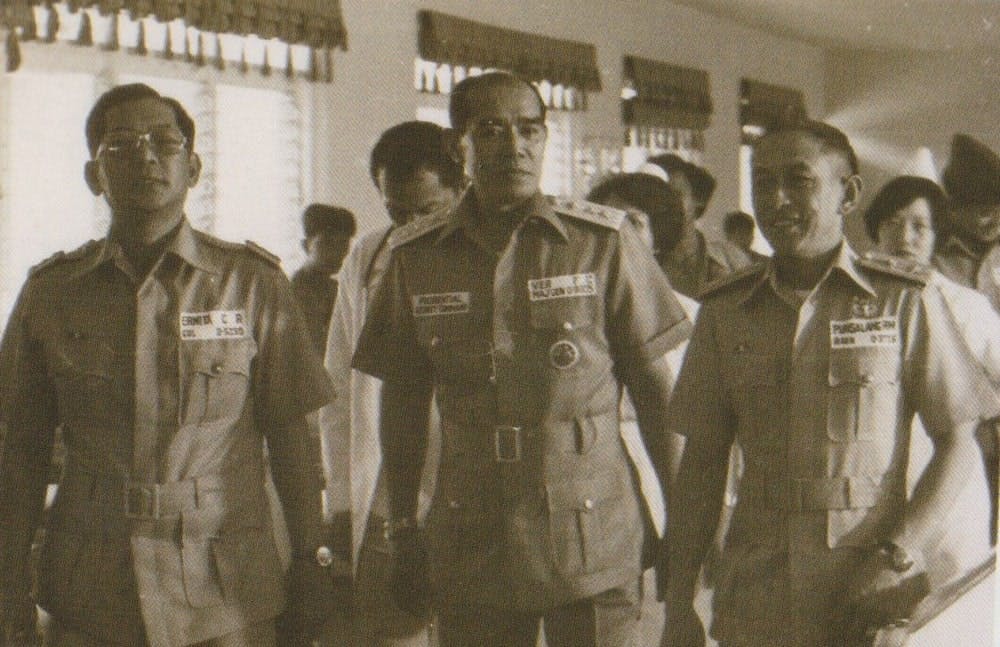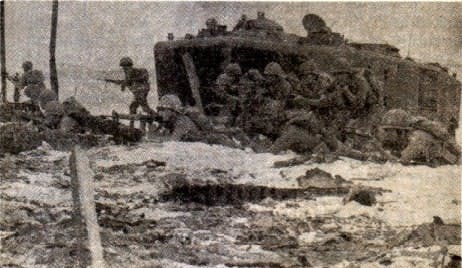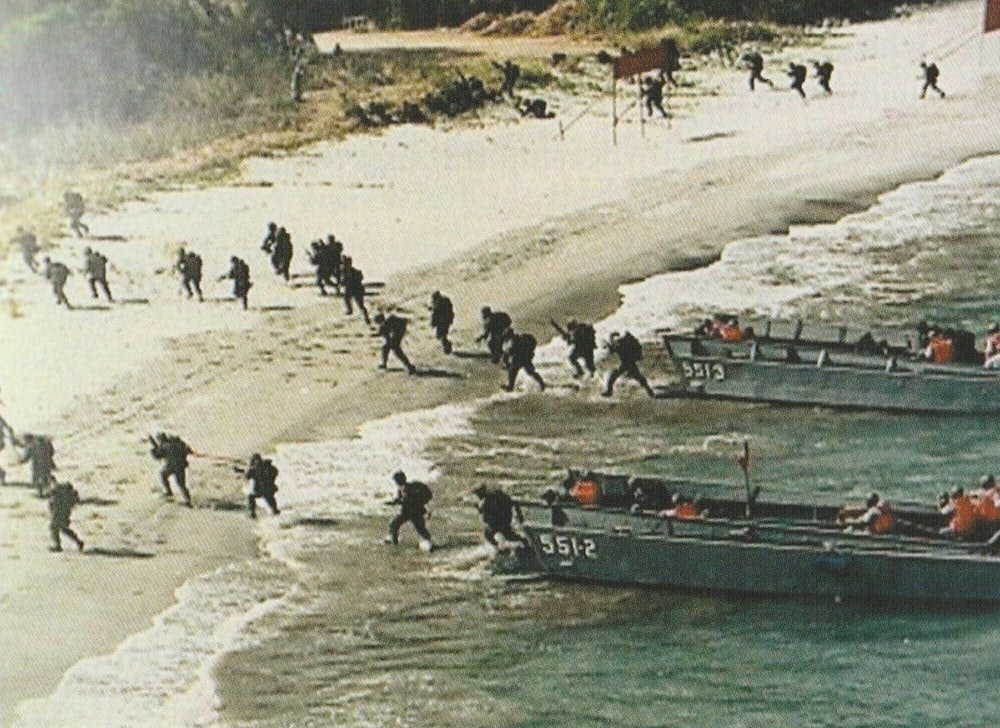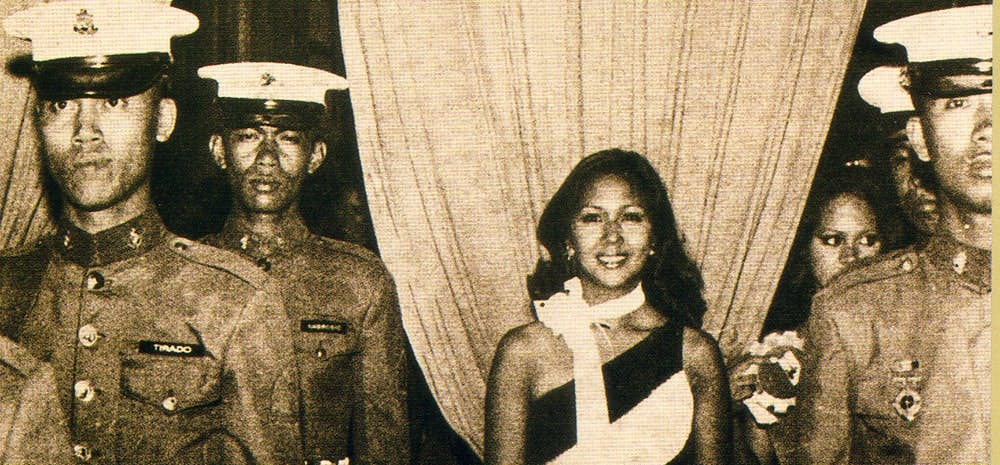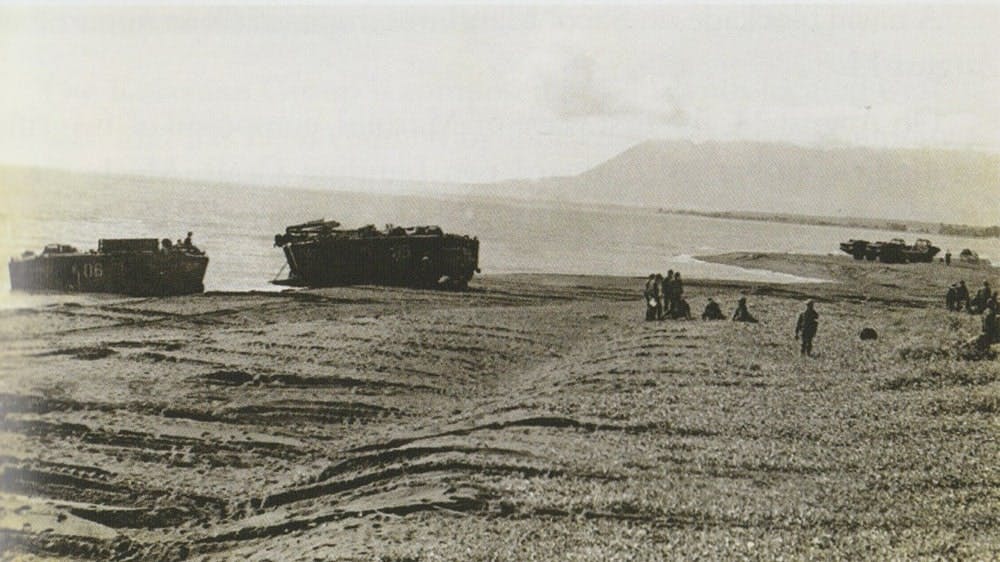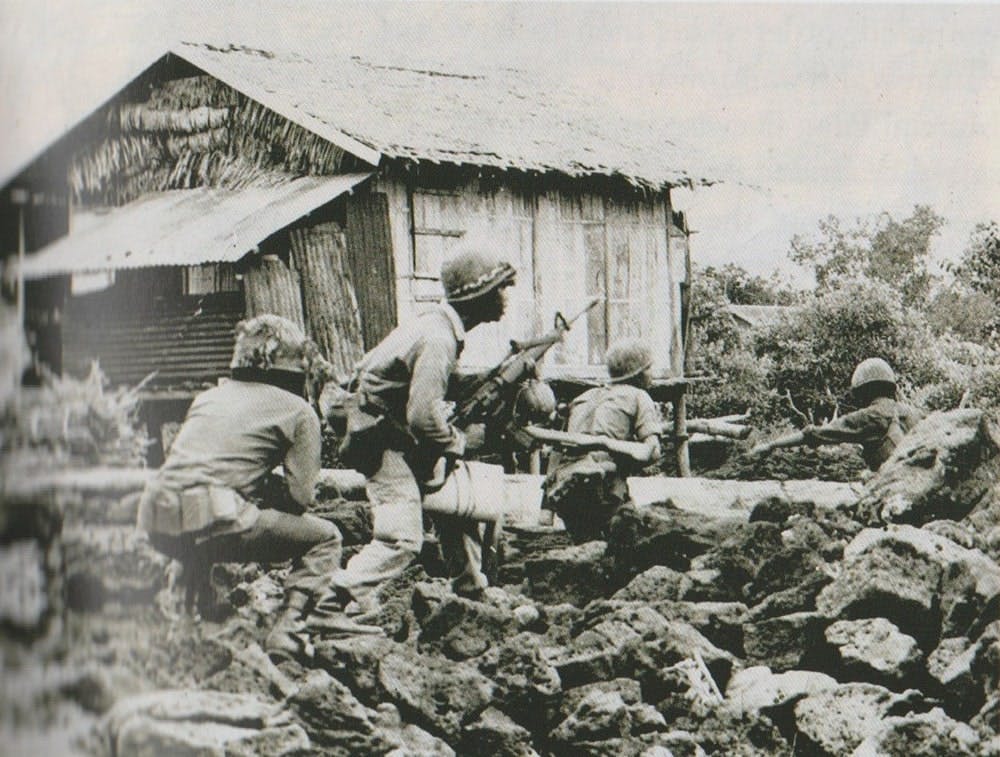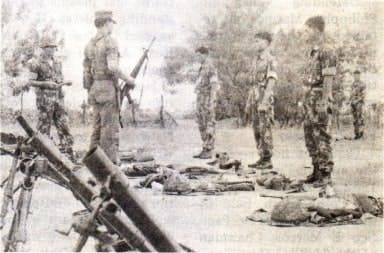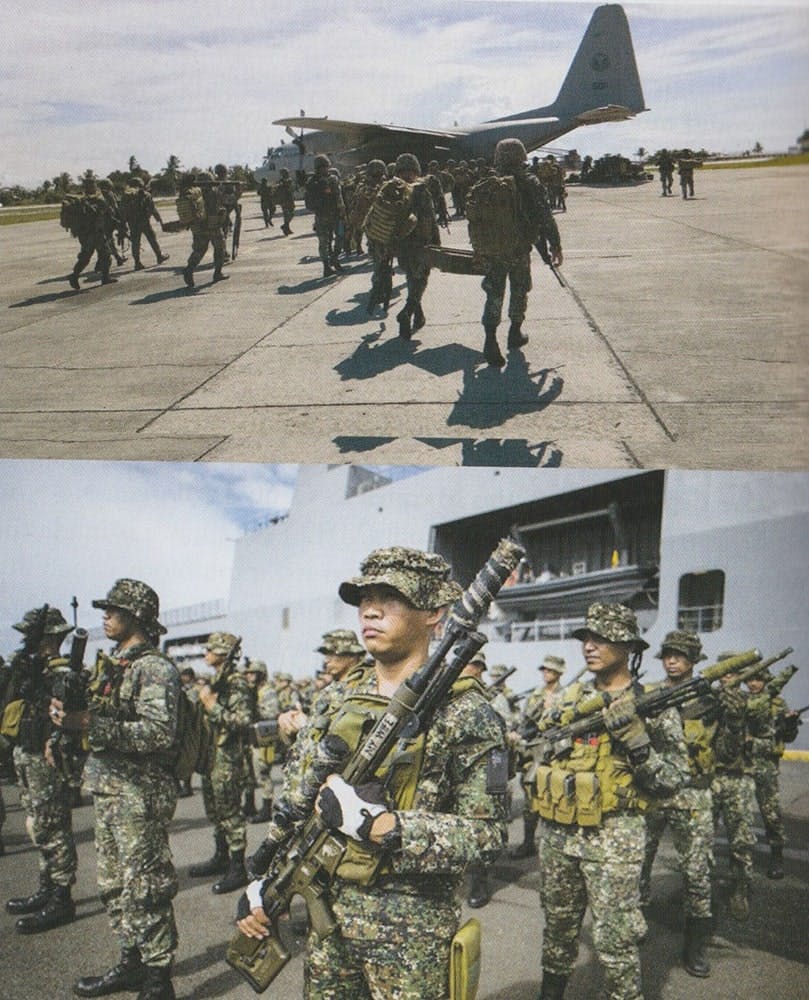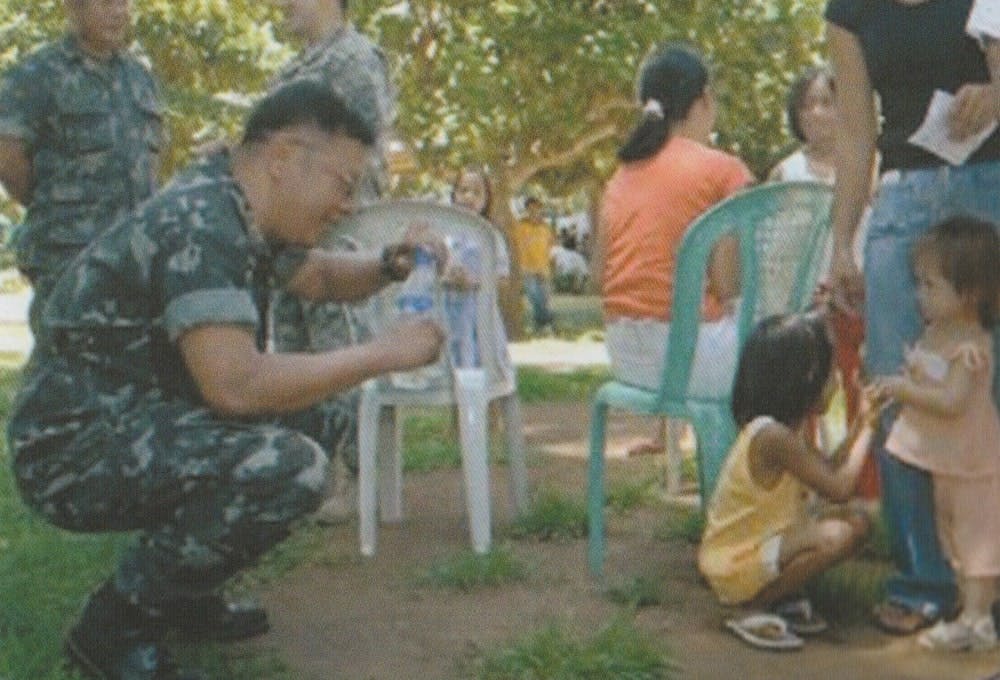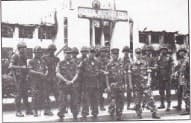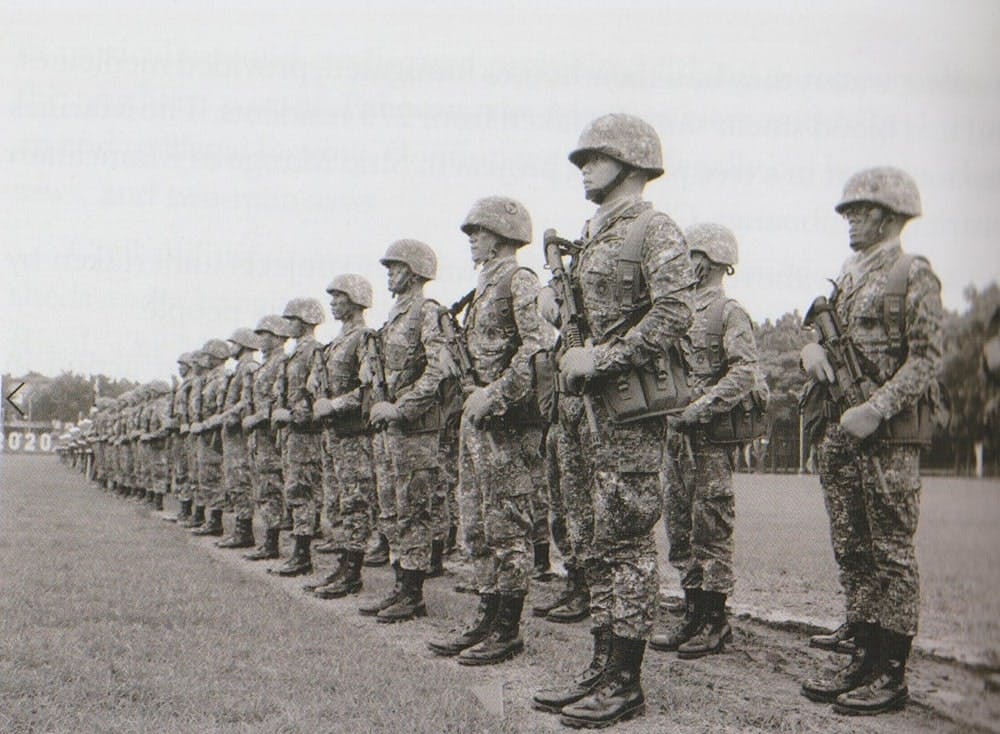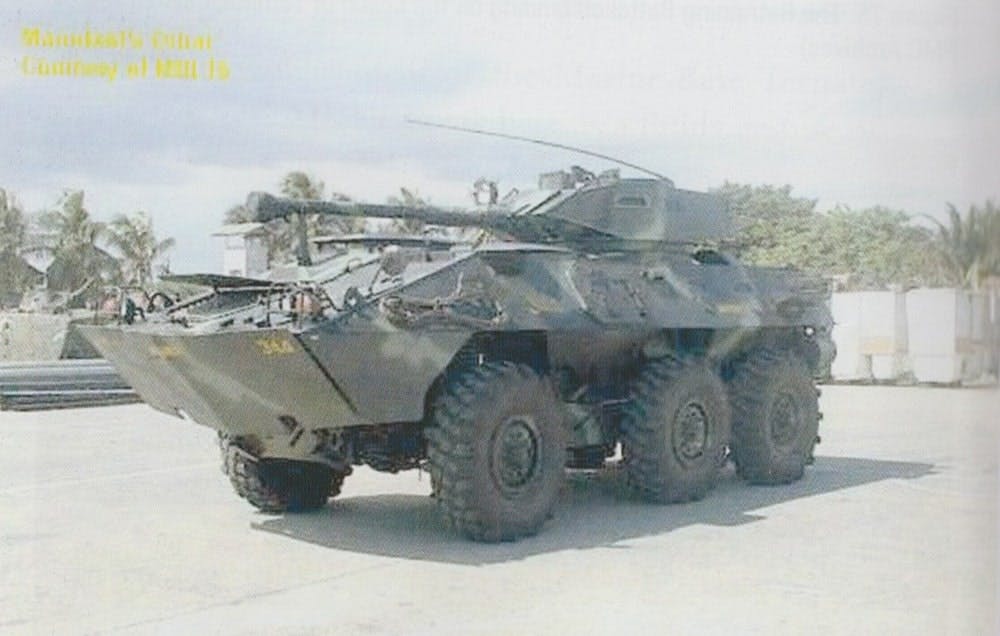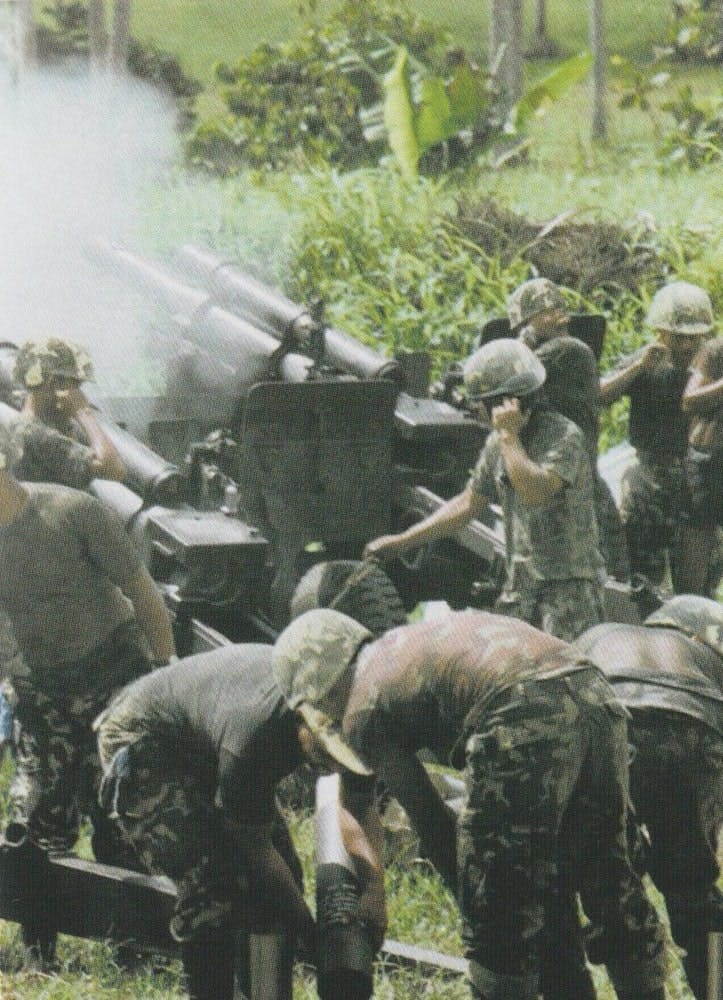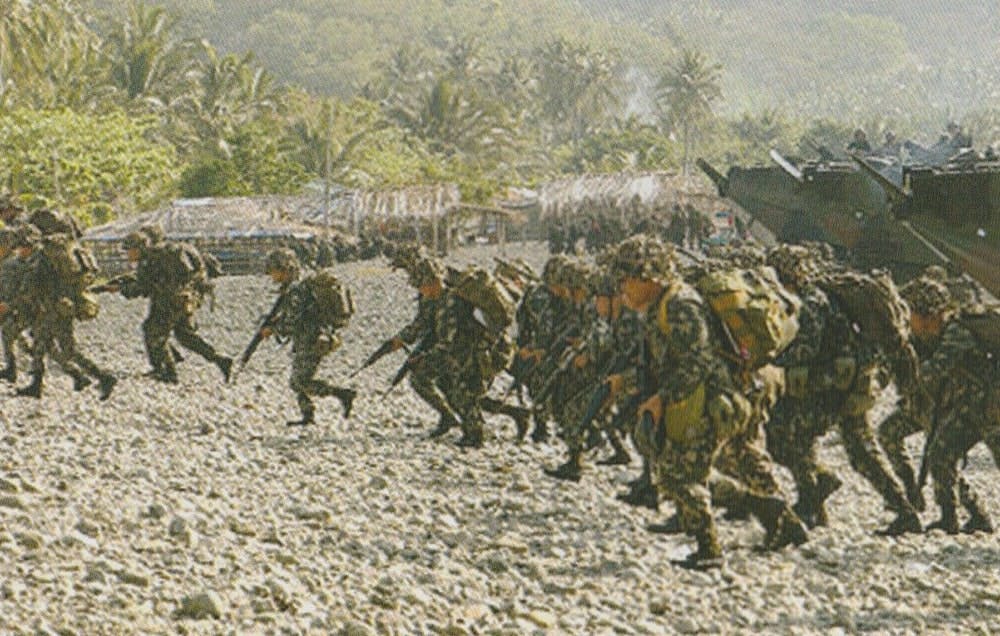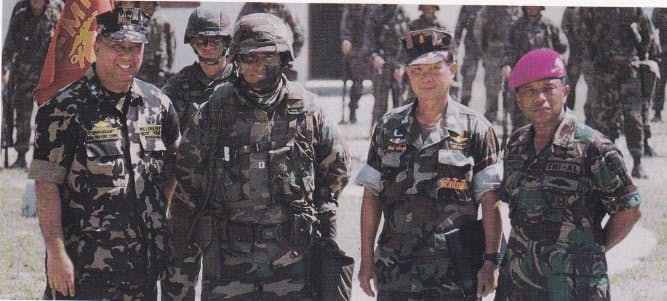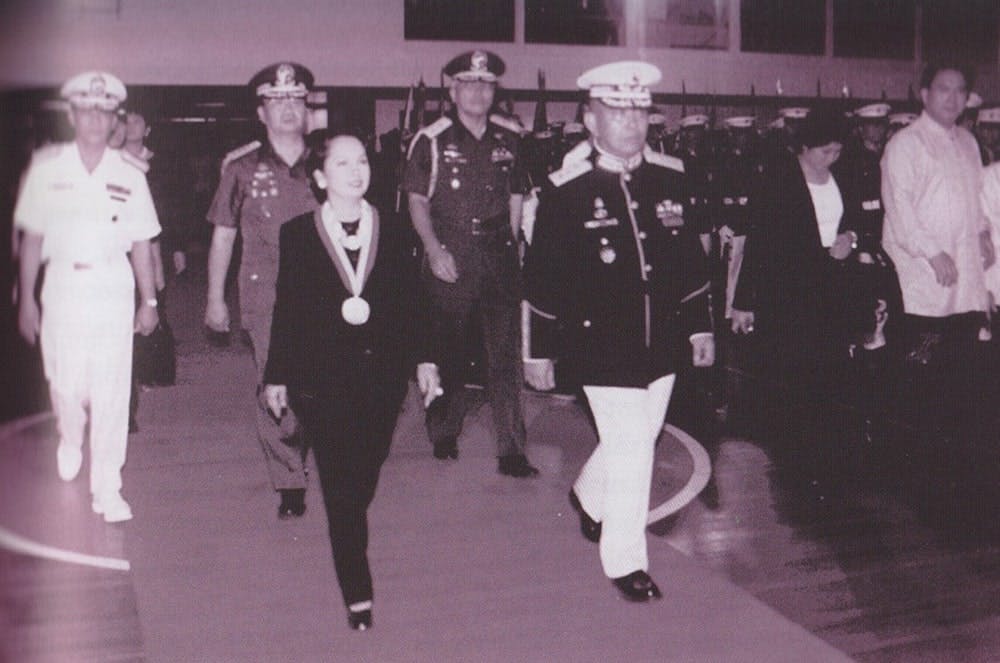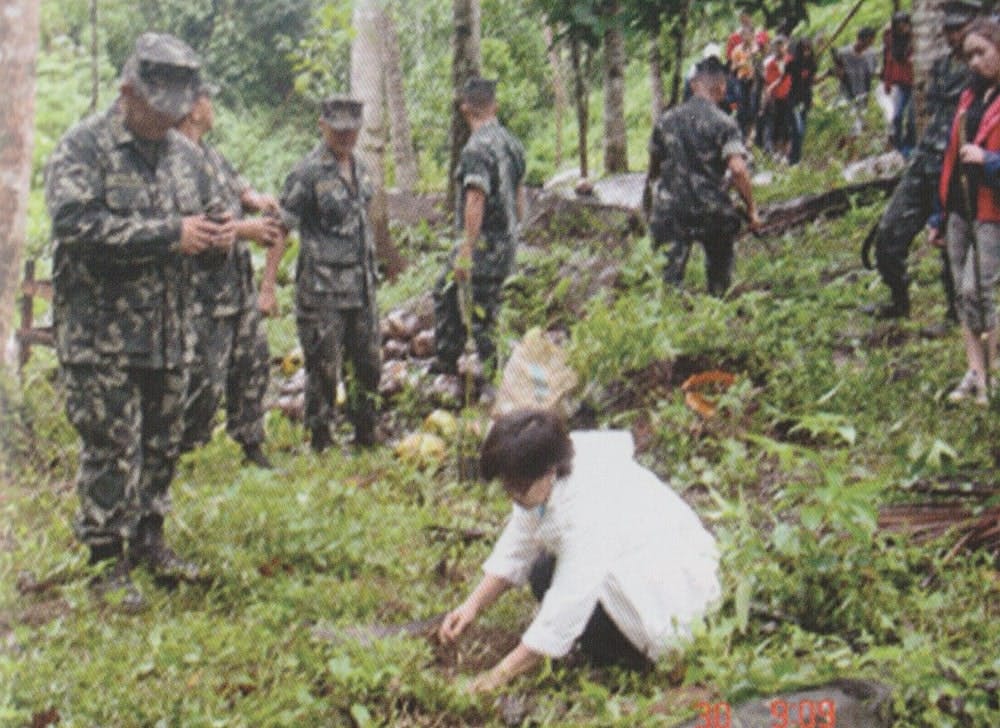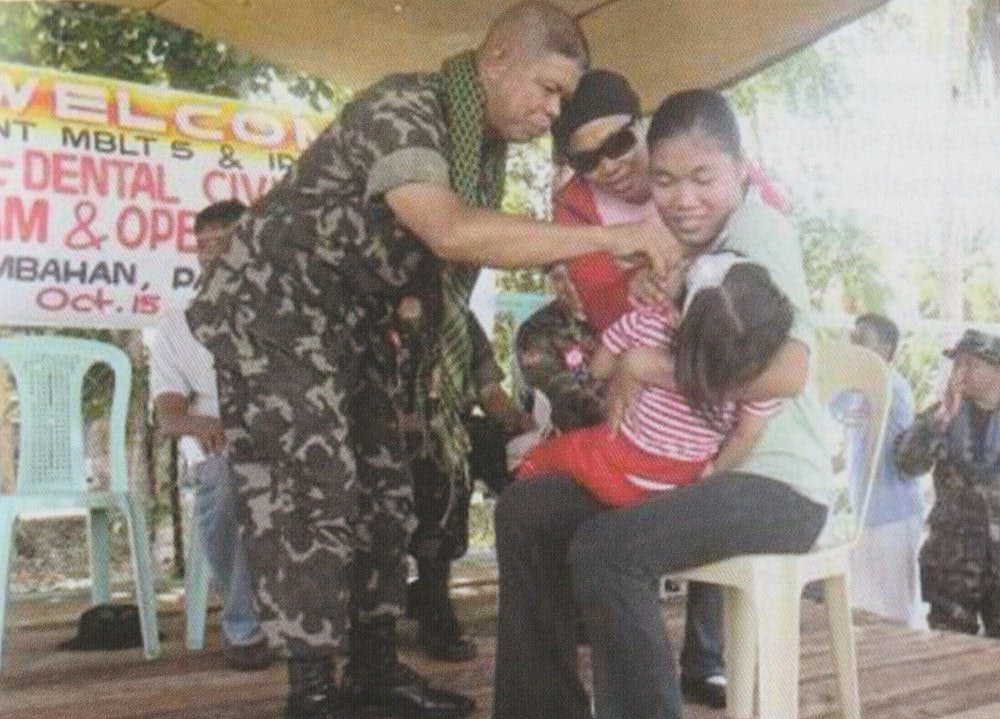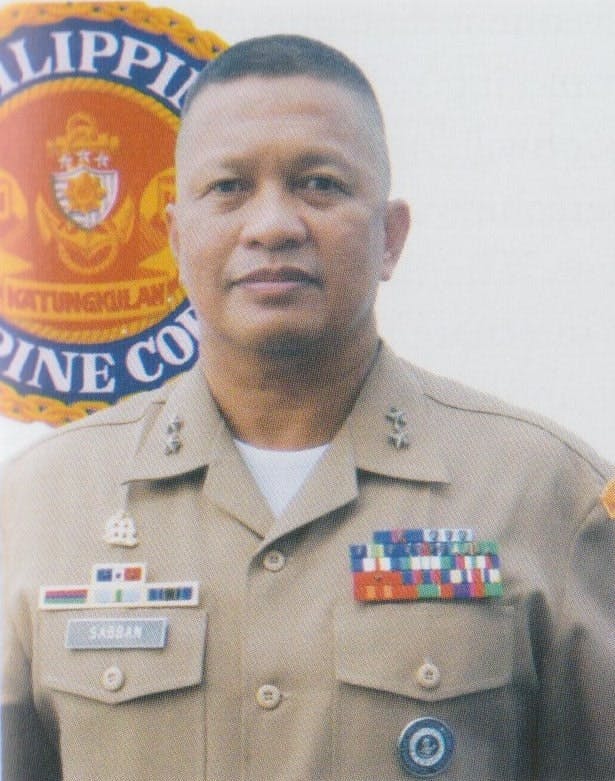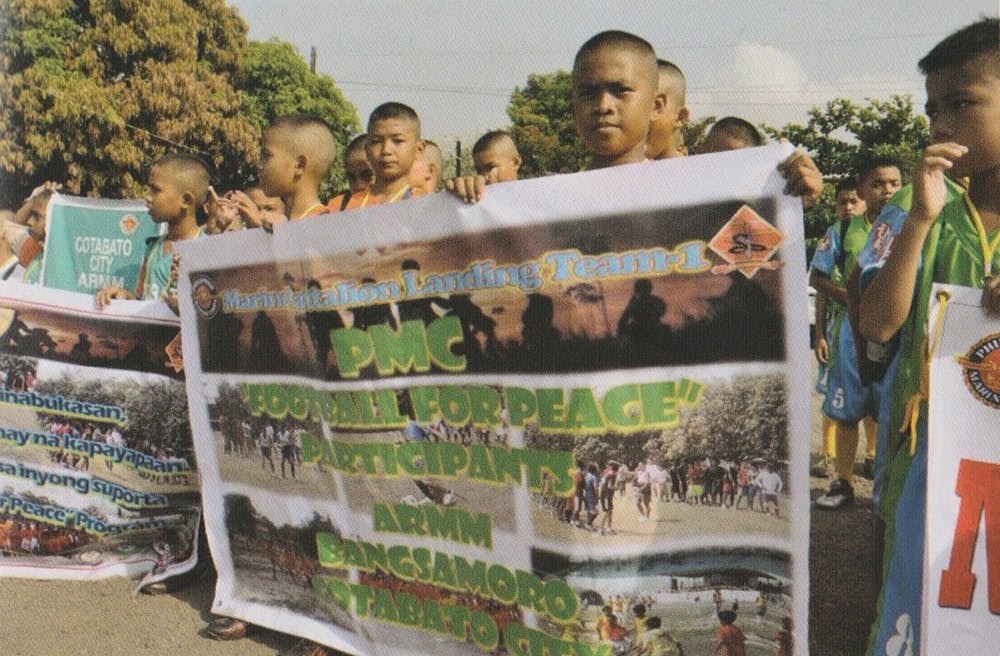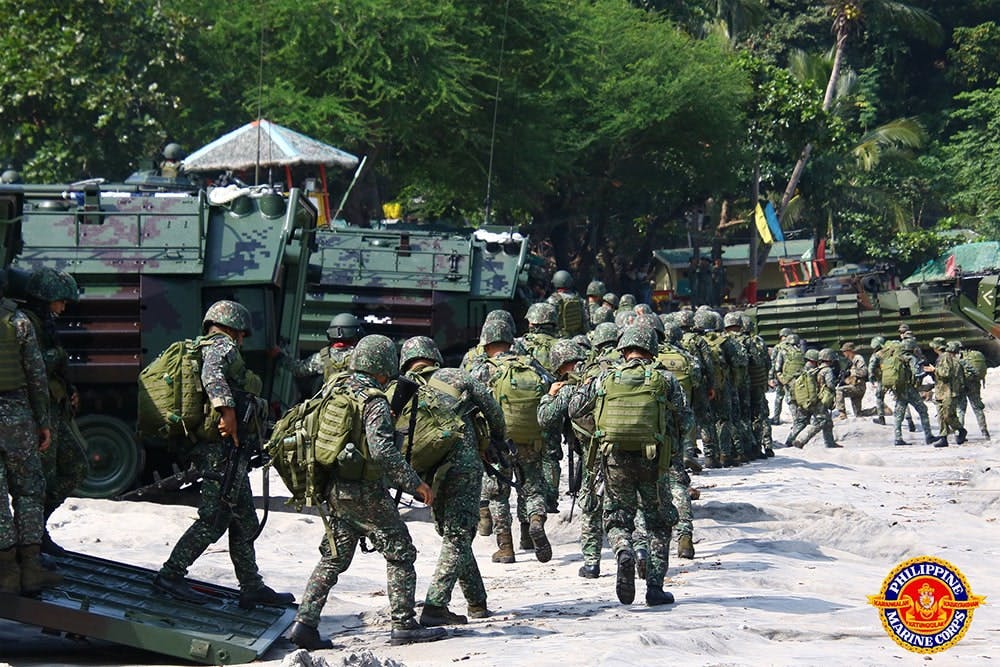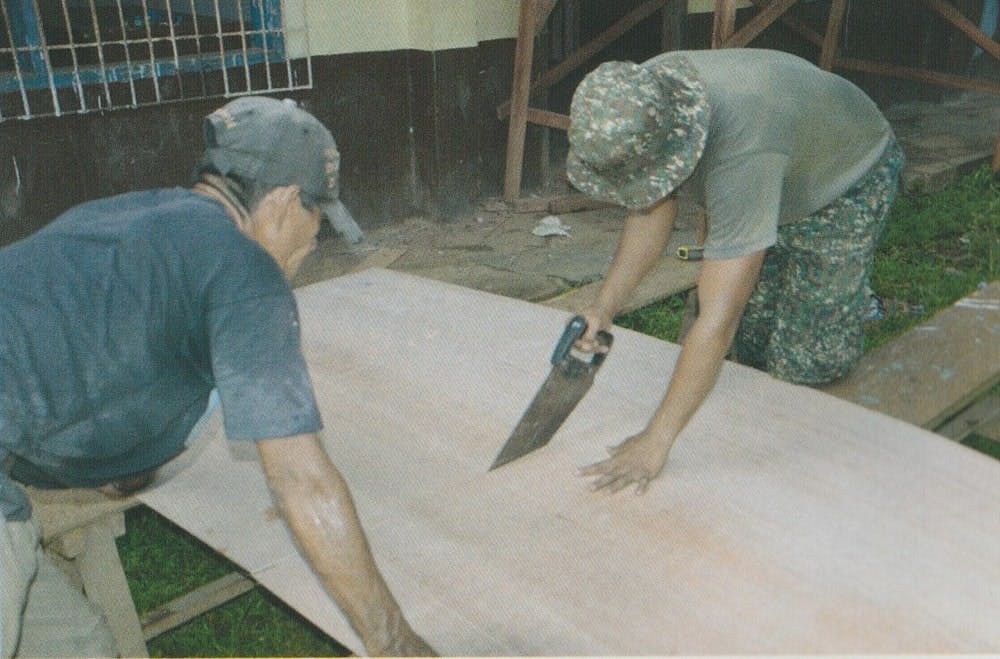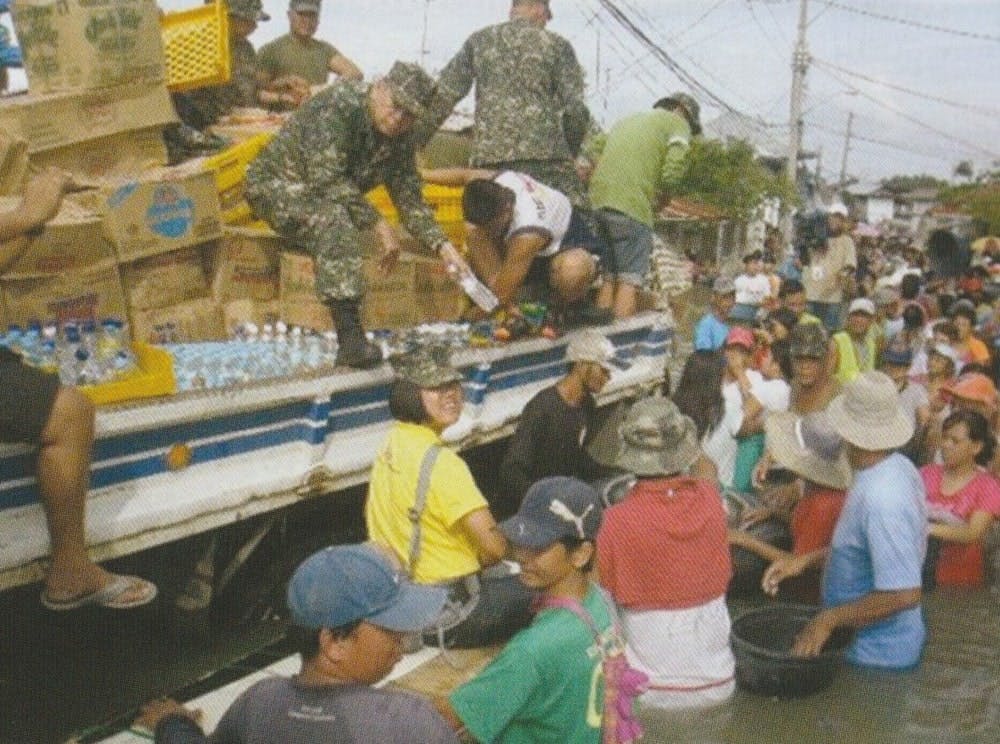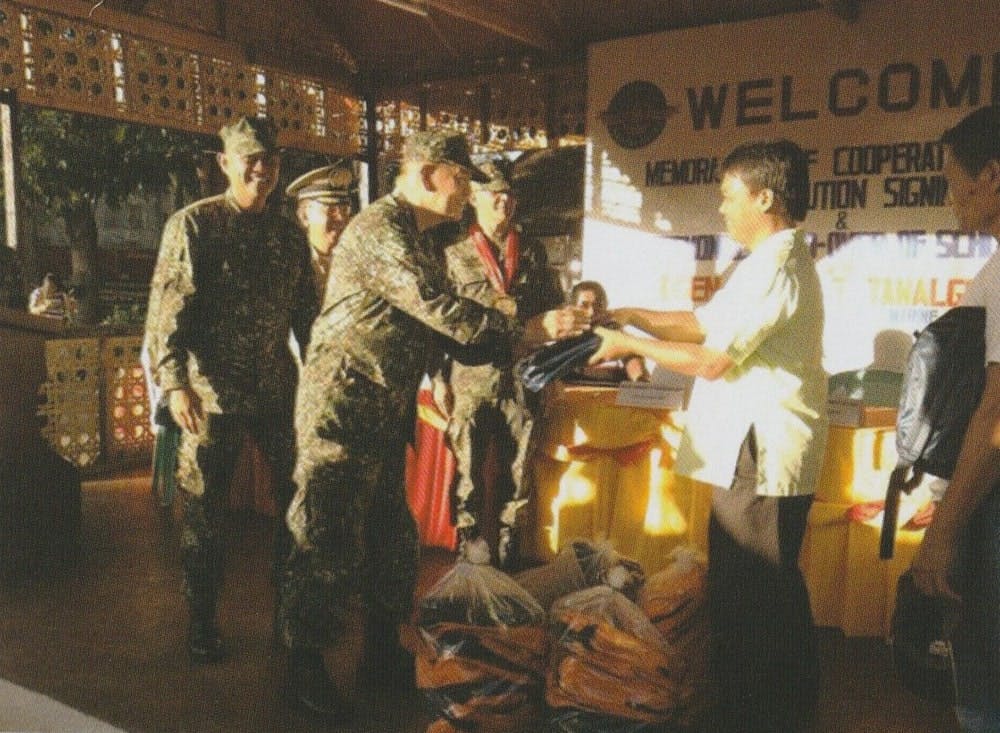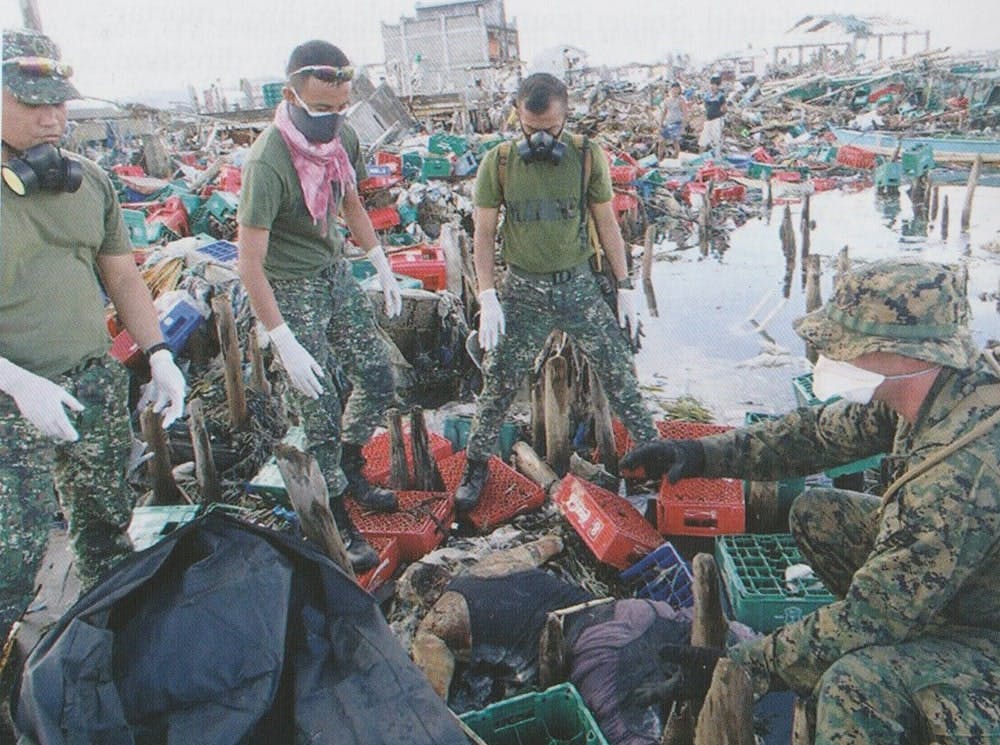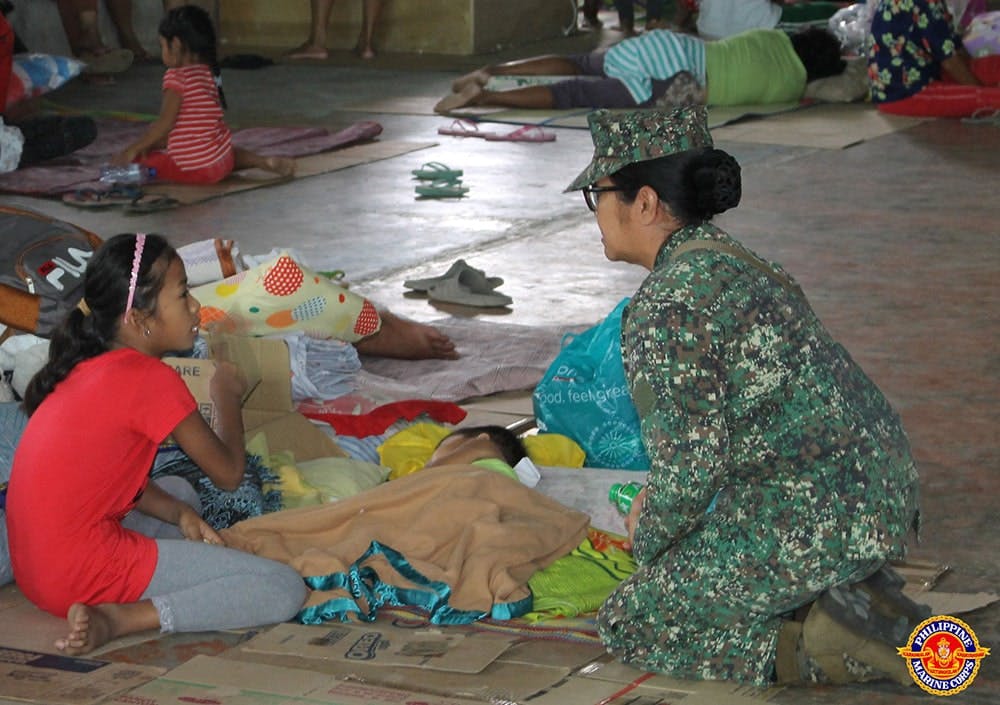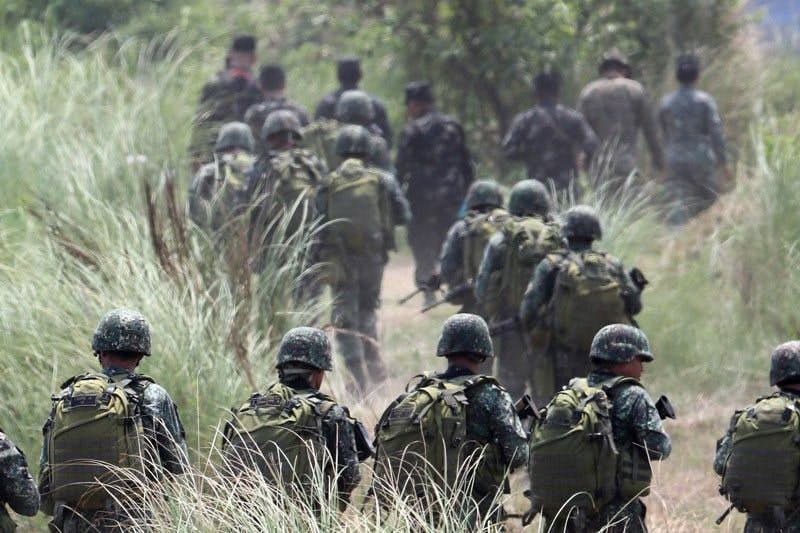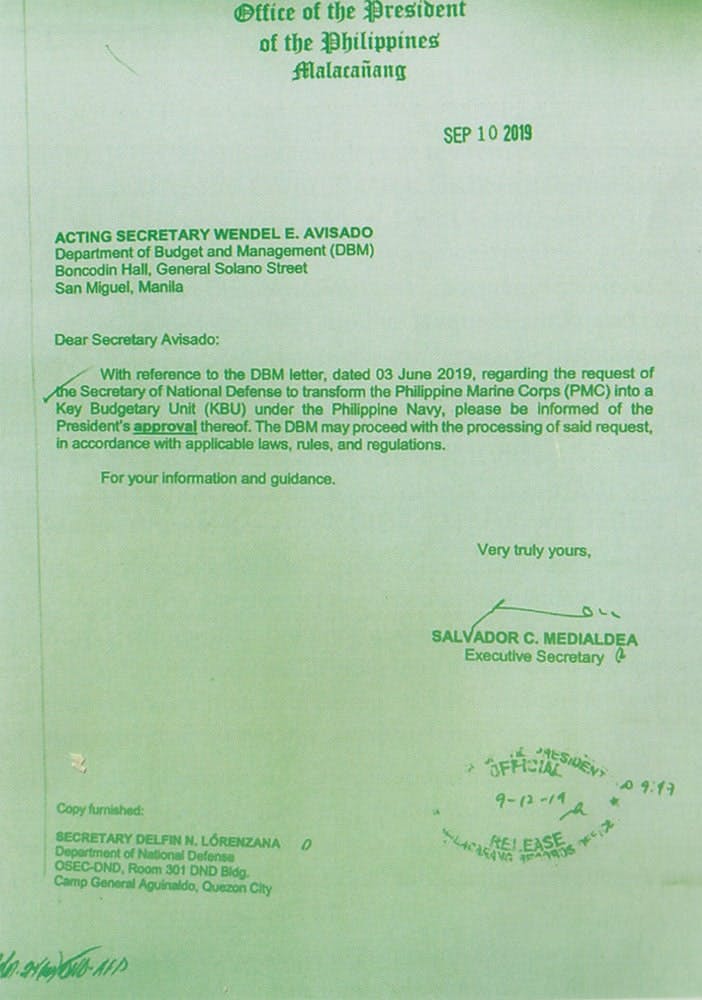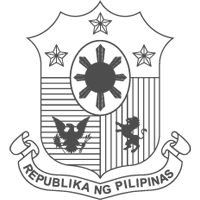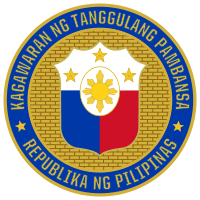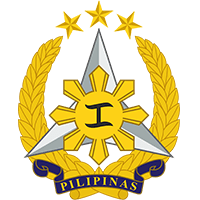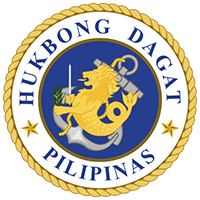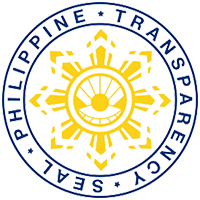Explore Marines
Join the Marine Corps
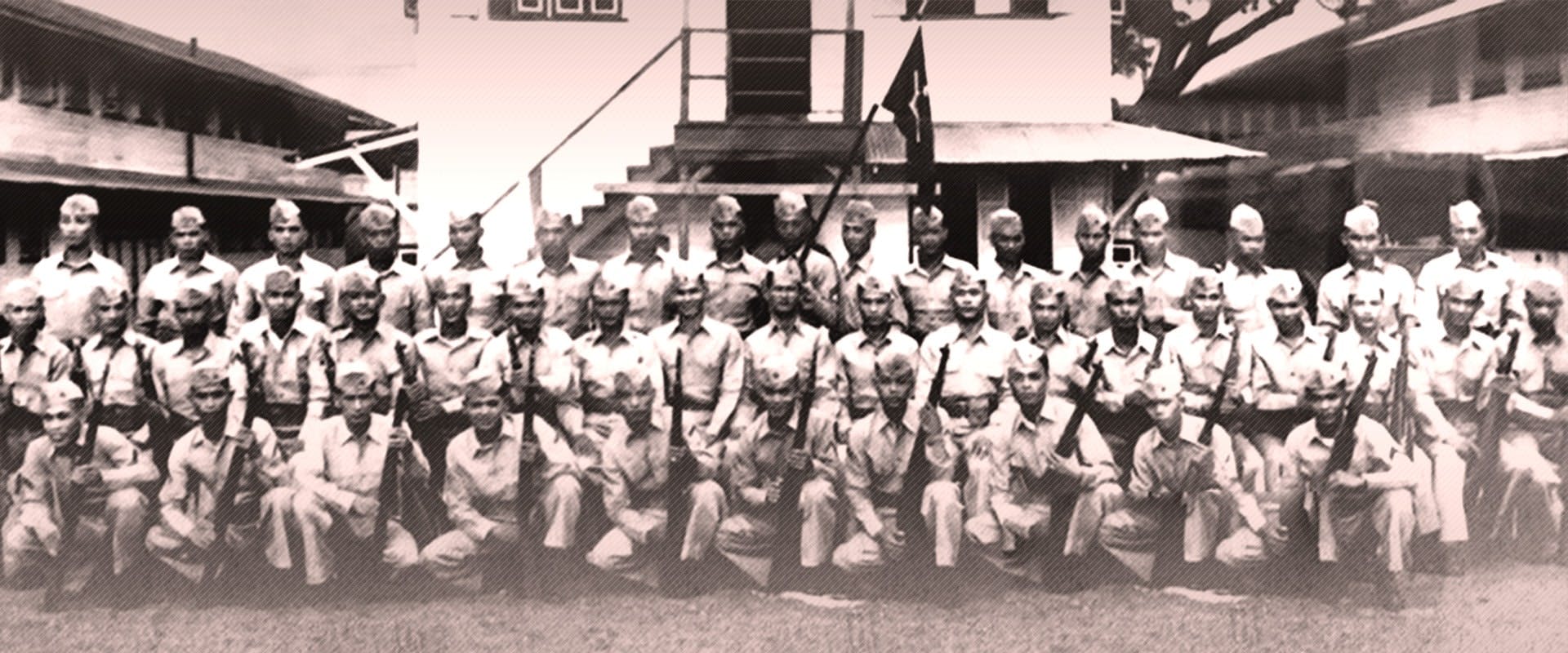
Marine Corps History
1950 - The Beginning
November 1950
Establishment of Alpha Company
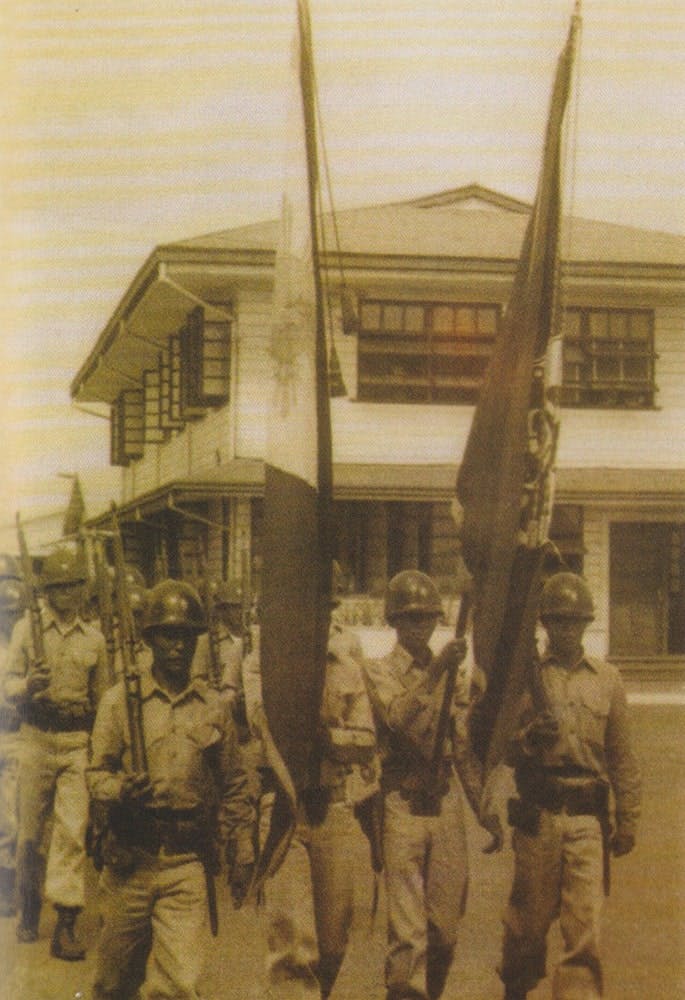 Alpha Company with USMC instructor during training activities
Alpha Company with USMC instructor during training activities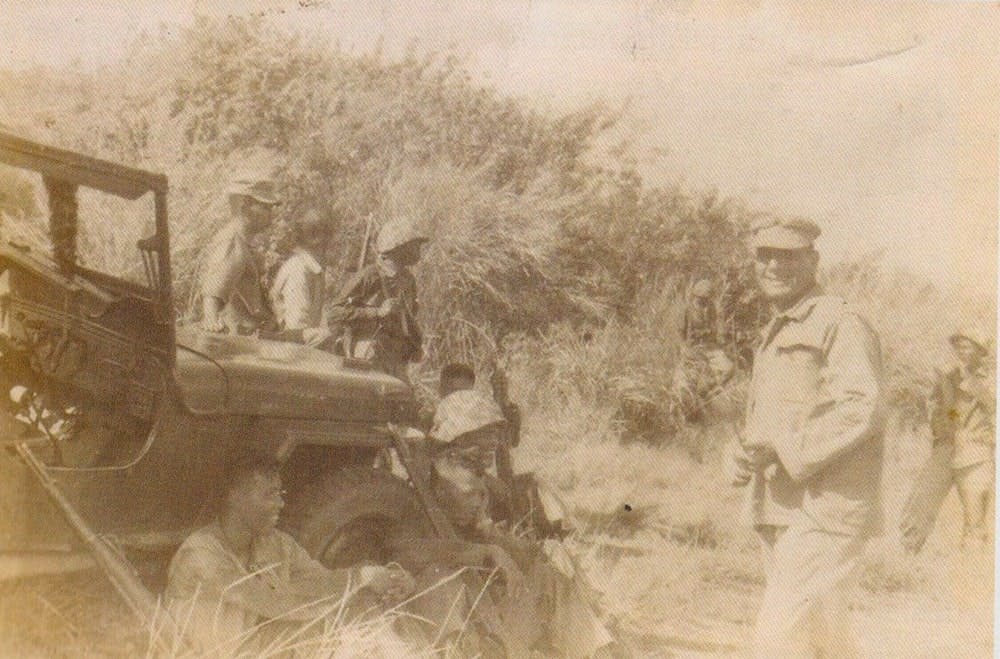 Applicants whose height are being measured. A recruit must be atleast 5_6 in height to qualify in Marine Alpha Company
Applicants whose height are being measured. A recruit must be atleast 5_6 in height to qualify in Marine Alpha Company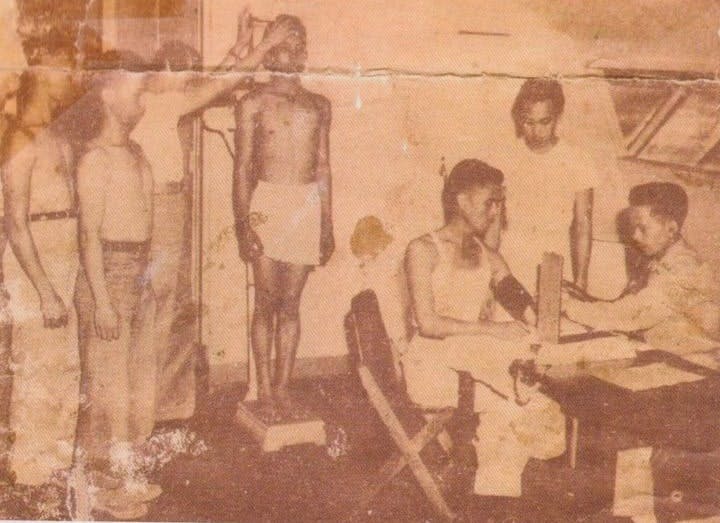 Classroom Lecture
Classroom Lecture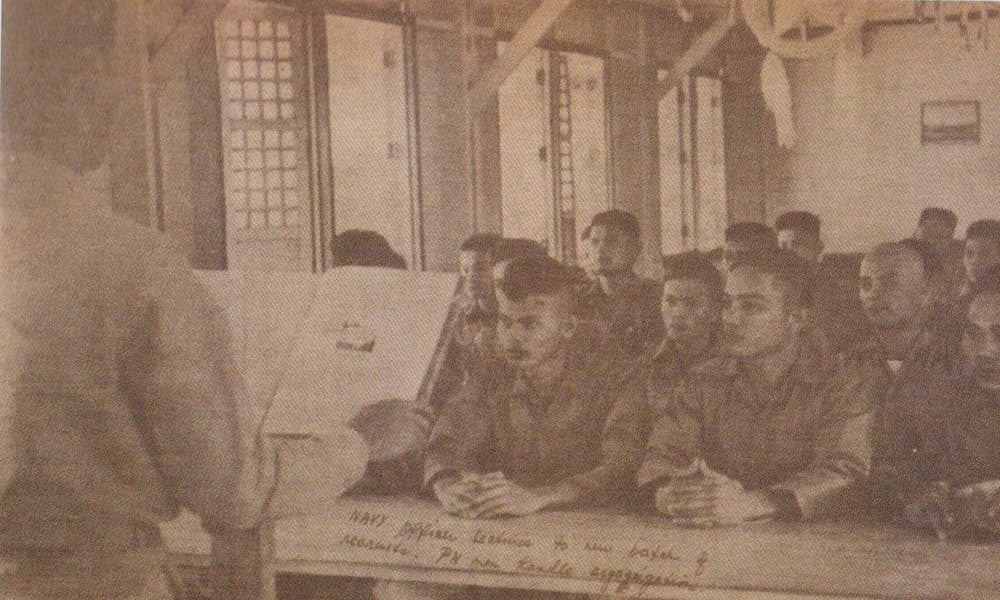
During President Elpidio Quirino's administration, the Philippine Marine Corps became a prominent political and military institution. The Philippine Marines were established on AFP General Orders no. 319 effective on November 2, 1950. It authorized the creation of Alpha Company of the 1st marine battalion as a unit of the Philippine Naval Patrol (later known as Philippine Navy) whose aim is to create a light and hard-hitting seaborne force that strikes lawless elements along the vast coastline of the archipelago.
First Commanding Officer
Due to the probable hazards of its operation, only volunteers were selected to this special unit. Then LT Senior Grade Manuel Gomez, a graduate of Philippine Military Academy Class ‘41 and a graduate of Armor Tactics in Fort Knox Kentucky was appointed as the first commanding officer. He laid the direct task of training, equipping and organizing the newly established unit.
Father of Philippine Marines
Meanwhile, LT Junior Grade Gregorio Lim was designated as the executive officer. He became the 'Father of the Philippine Marines" as he organized the first marine company, composed of six navy officers and 230 enlisted personnel, largely World War II veterans, who were trained to conduct amphibious and ground combat operations. Eventually, this later became the cutting edge of the Armed Forces of the Philippines.
Official Activation of Alpha Company
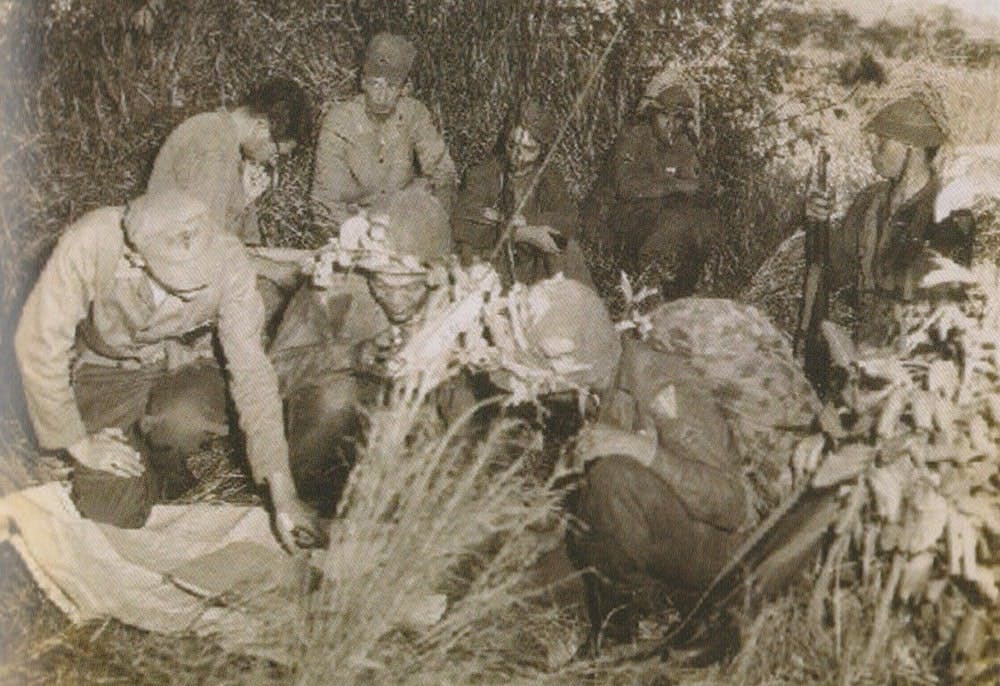 New recruits being sworn in. photo taken estimated months after July with wet raincoats
New recruits being sworn in. photo taken estimated months after July with wet raincoats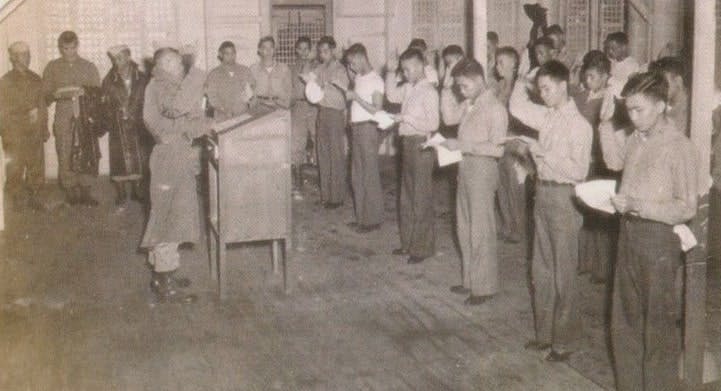 Obstacle training
Obstacle training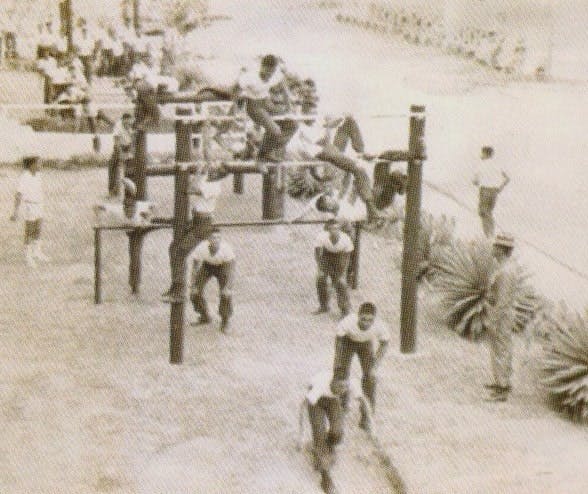 Reciting the Marine Corps Oath
Reciting the Marine Corps Oath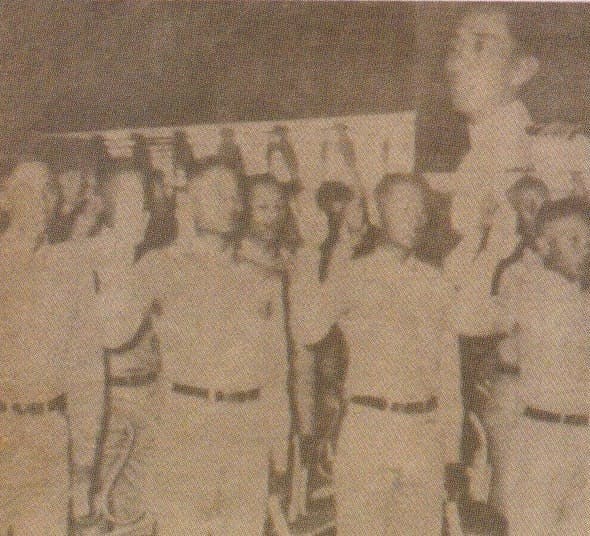
Even so, Alpha Company was officially activated on November 7, 1950, at the Naval Operating Base in Cavite due to orders from then-Secretary of National Defense Ramon Magsaysay.
1951
APRIL 1951
First Amphibious Attack
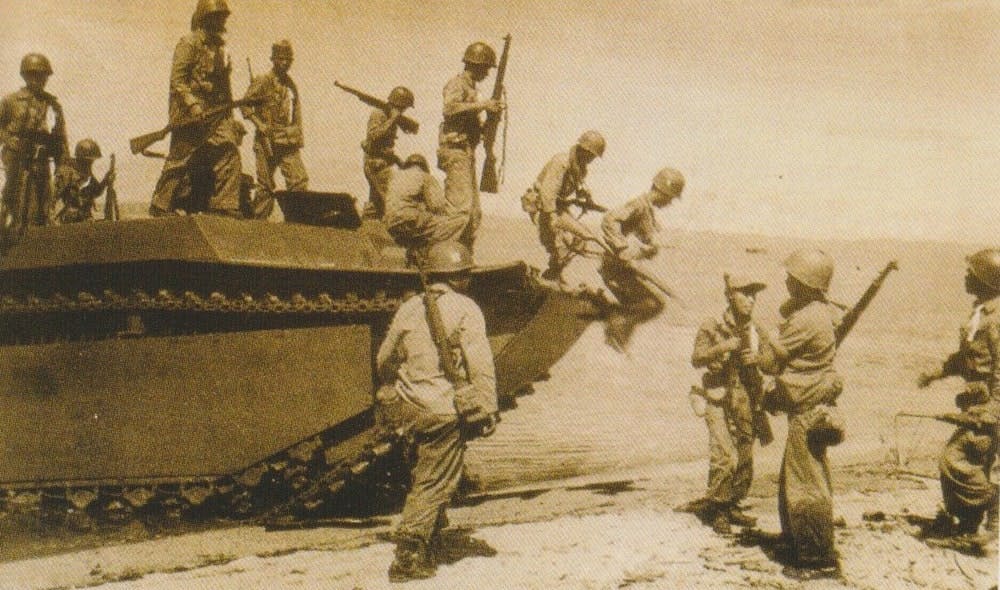 Image needs caption
Image needs caption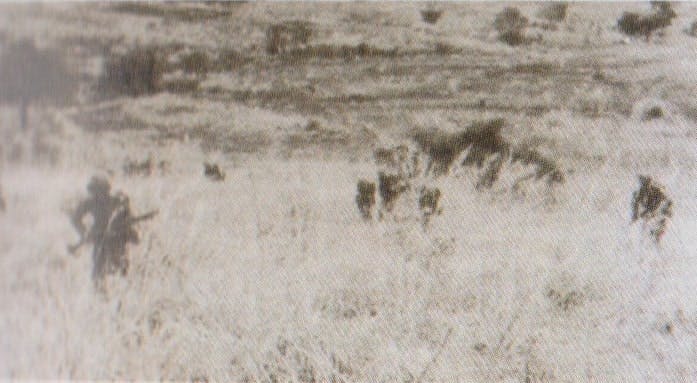
After only five months of training, the unit's first amphibious attack occurred on April 19, 1951 in Umiray, Quezon. But to their dismay, they took their first beachhead without any opposition.
JUNE 1951
First Baptism of Fire
On June 4, 1951, these brave soldiers were put through a baptism of fire in Nueva Ecija. After their daring act in Nueva Ecija, the Marines have never left the combat zone. Nonetheless, they were deployed in almost all parts of the country. While fighting the Huks in Luzon, they also formed detachments of platoon and squad-sized units to fight pirates, smugglers, and other lawless elements along the sea borders of Mindanao.
JULY 1951
Marblehead
On July 1, 1951, the Philippine Marines began military operations dubbed as Marblehead, against the Hukbong Mapagpalaya ng Bayan (HMB) in Laguna.
On July 4, 1951, the Marine Company was formally presented to the nation when it marched with other AFP units during the Independence Day Celebration. The following day, the Company was airlifted to Legaspi, Albay and from there the unit launched an amphibious raid against dissidents at Catanduanes.
SEPTEMBER 1951
Operation Smile
On September 14, 1951, the Philippine Marines launched Operation Smile in Laguna, where the general headquarters of the HMB was located. After figuring in other military operations, they captured the Visayas commanding officer, Guillermo Capadocia.
1952
Unknown Date
Operation Durian
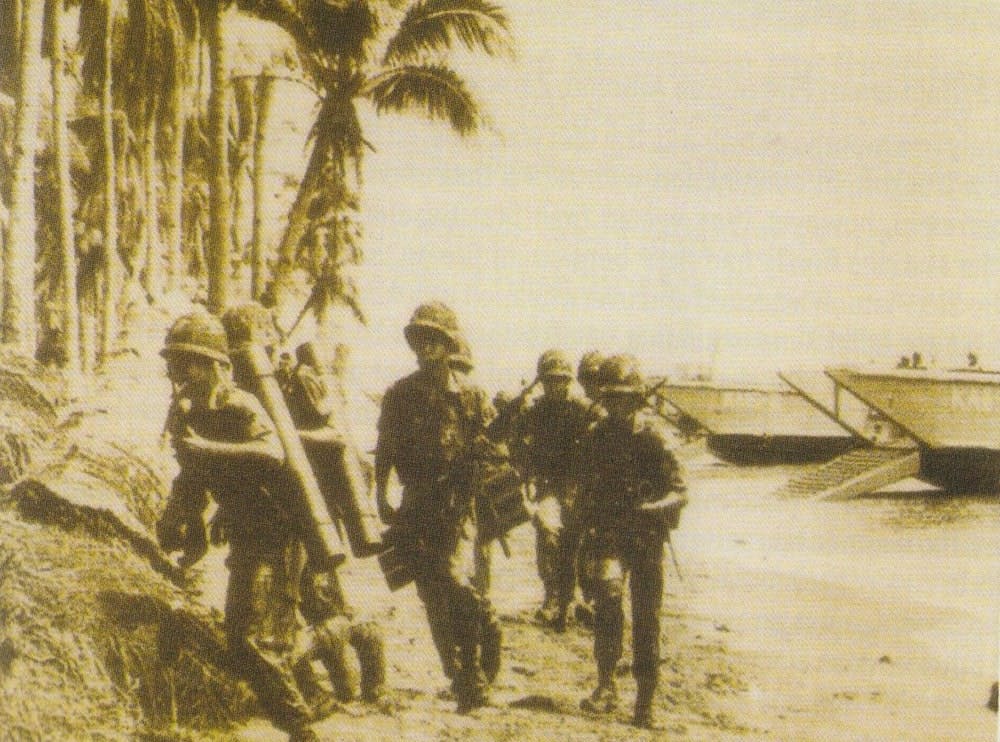 First Squad-First Landing Team in Bongao, Tawi-Tawi
First Squad-First Landing Team in Bongao, Tawi-Tawi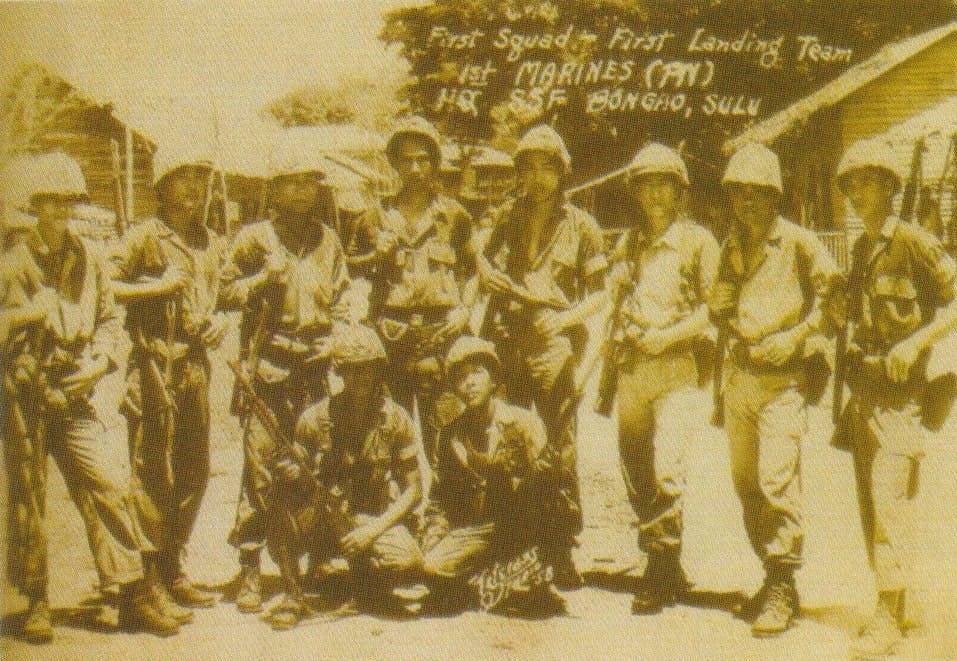 Pres Magsaysay talks to Hajji Kamlon after he surrender. He also conducts an inspection of the turned-over firearms
Pres Magsaysay talks to Hajji Kamlon after he surrender. He also conducts an inspection of the turned-over firearms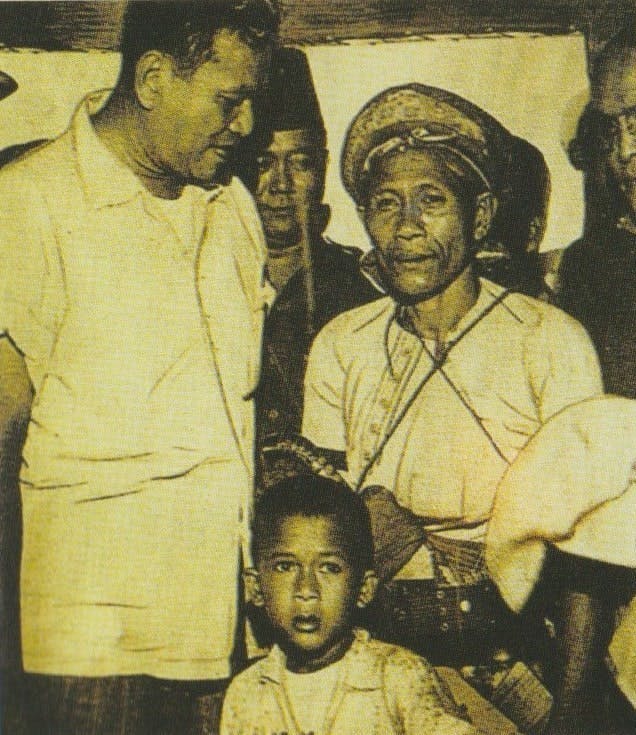 Turtle Island Detachment, Bongao, Tawi-Tawi.jpeg
Turtle Island Detachment, Bongao, Tawi-Tawi.jpeg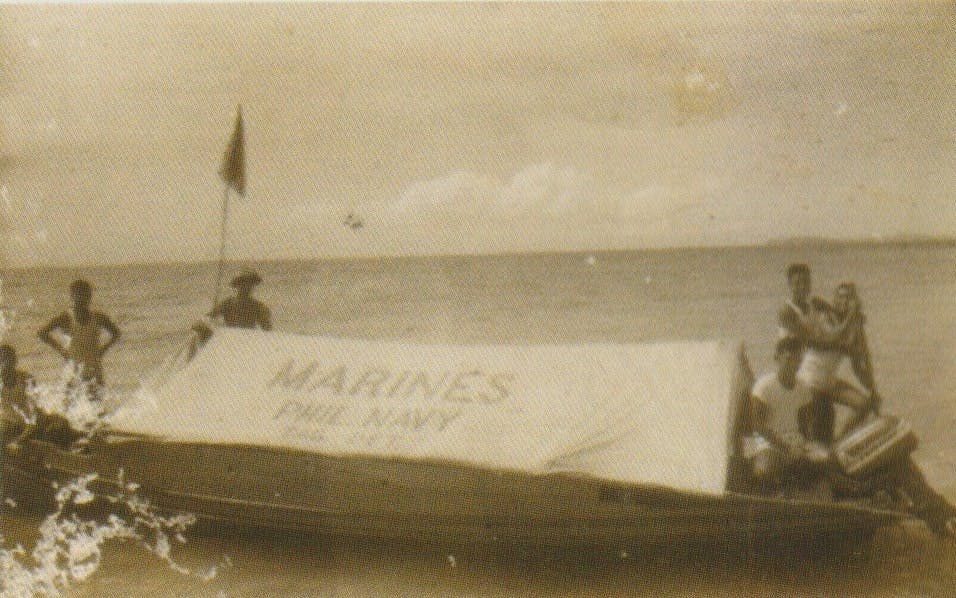
The Alpha Company lands on Tawi-Tawi Island to establish a detachment to protect the island from piracy and other threats during the height of the Sulu Sea Frontier Campaign. The Marines took down the banditry and smuggling activities in Sulu. Thus, 'Operation Durian" was launched to capture a known pirate named Hadji Kamlon and his followers in Jolo.
APRIL 1952
Operation Four Roses
On April 26, 1951, the Marines launched operation 'Four Roses" aimed at capturing the four top Huk Leaders - Taruk, Lava, Sanlo and Dimasalang whose operation areas covered provinces of Central Luzon bordering the Sierra Madre Mountains, Quezon, Nueva Ecija and Bulacan.
AUGUST 1952
New Commanding Officer
On August 1, 1951, Lt Cdr Gregorio Lim took over the command of the company from LCDR Manuel Gomez for the second time.
1954
March 1954
Rat Infestations in Cotabato
The Marines were tasked by then-President Ramon Magsaysay to help farmers in Cotabato with rat infestation in March 1954. The Marines sent a platoon headed by Lieutenant Caesar Alzona to the area and accomplished the task well. The Marines undertook civil action projects which endeared them more to the community.
Civic Action Projects
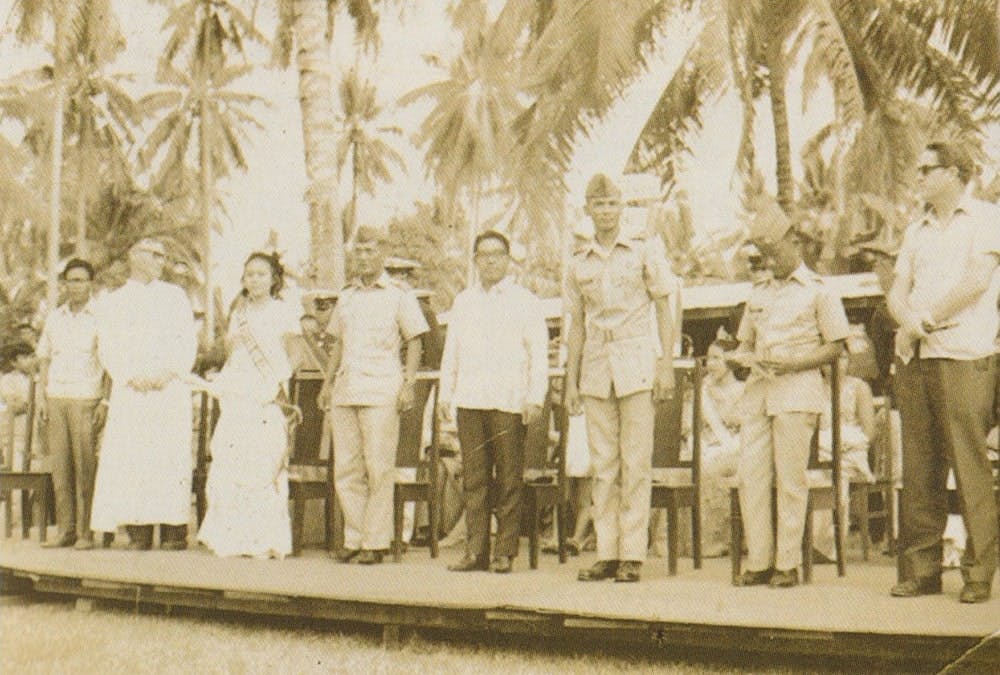 The Marines together with social workers and children at the Department of Social Welfare Region XII
The Marines together with social workers and children at the Department of Social Welfare Region XII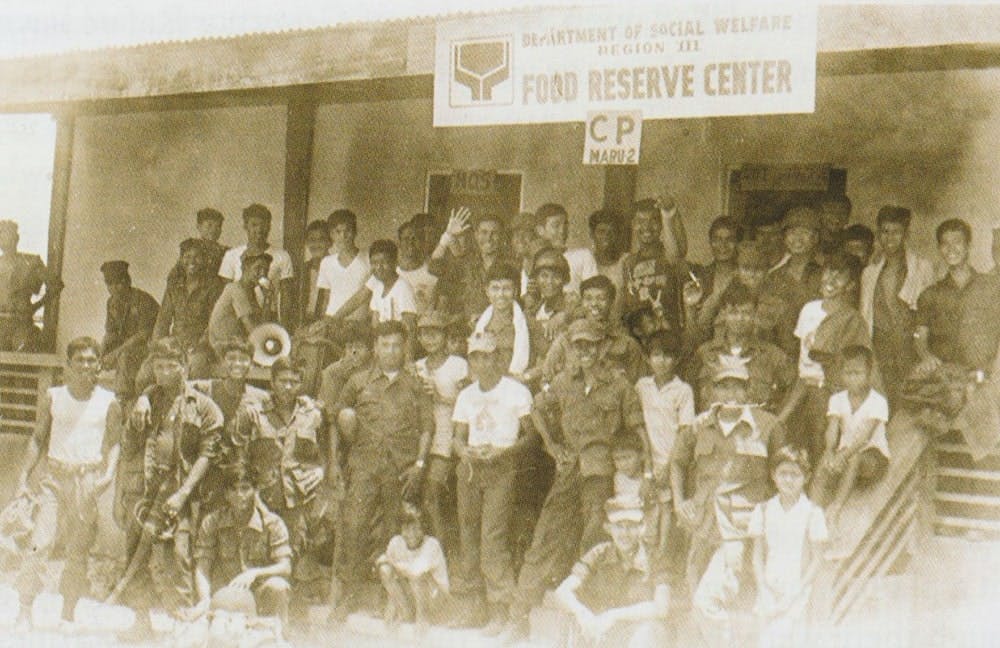
While in Cotabato, the Marines undertook Civic Action Projects, such as construction of an additional school classroom, which endeared them more in the community.
1955
October 1955
Expanding Alpha Company
On October 3, 1955, the Marine troops discovered and captured Datu Tagaran, another leader terrorizing Sulu.
NOVEMBER 1955
No Title
- The desire to expand the Alpha Company was progressively recognized. On November 7, 1955, the unit finally became a Battalion with the organization of a Headquarters and Service Company and the 2nd Marine Company. It was expanded to a Battalion of two rifle companies, Headquarters and a Service Company with the then LCDR Gregorio L. Lim PN served as the First Battalion Commander at that time.
- Soon after, the 2nd Marine Company was created and deployed as a striking force in Sulu involved in operations against piracy and smuggling.
1959
Unknown Date
First Appearance of Light Vehicle Tracked
In the middle of 1959, A Light Vehicle Tracked (LVT) section was first introduced into the organization to strengthen its combat support capability.
1960
August 1960
Marine Battalion Becoming Major Unit of Naval Operating Force
The Marine Battalion became a major unit of the Naval Operating Force (now the Philippine Fleet) in August 1960.
Drum and Bugle Team
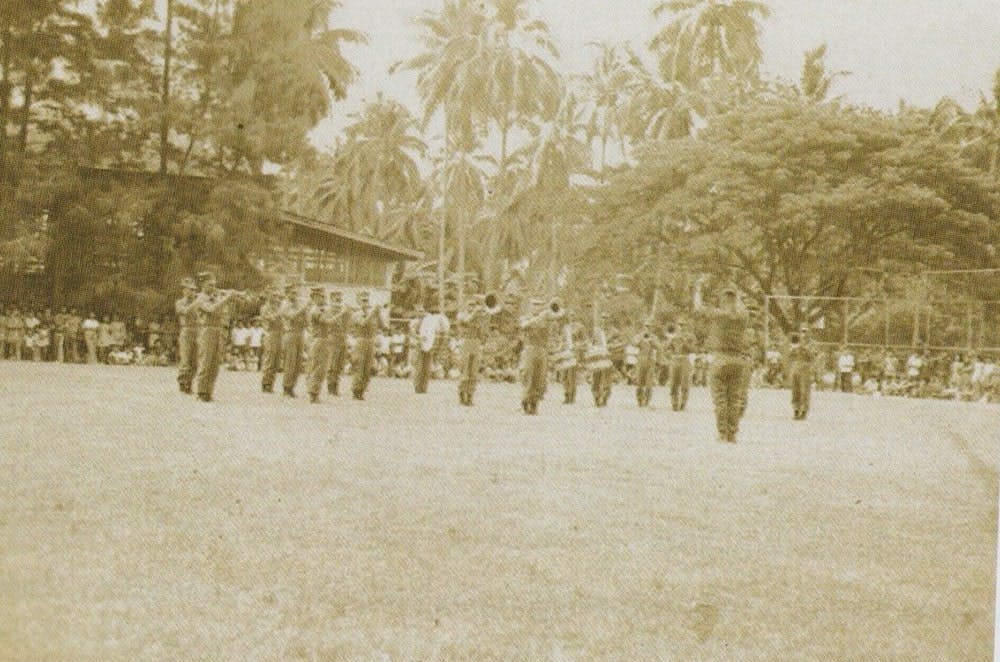 Drum and Bugle Team performing one of its routines
Drum and Bugle Team performing one of its routines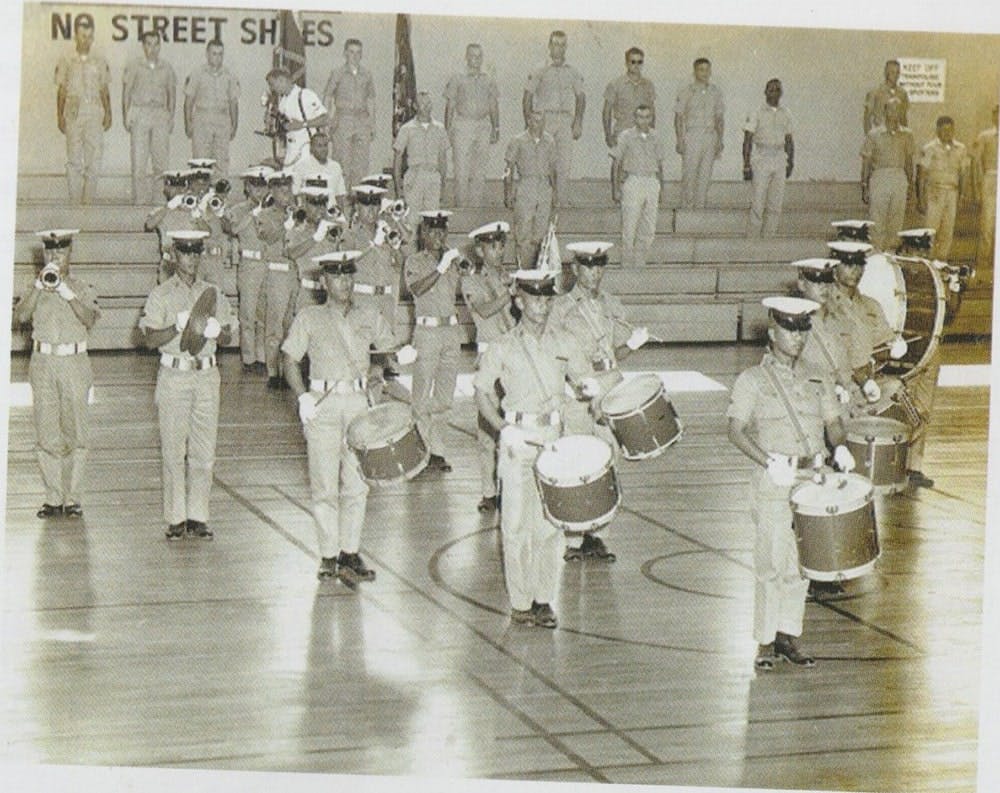
The Philippine Marine Drum and Bugle Team were originally organized in the year of 1960. The Marines initiated the formation of the team which was composed of seventeen (17) enlisted personnel. The original seventeen-man were all personnel of weapons Company who are former band members. These various commitments strengthen the good relationship between the military and civilian populace.
1961
NOVEMBER 1961
Creation of 3rd Marine Company
When the Philippine Marines celebrated its tenth anniversary on November 7, 1961, the 3rd Marine Company was formed and deployed to Corregidor to go after looters of military equipment found on the island fortress. They also provided escorts for visitors in the island.
Unknown Date
No Title
To further enhance their capability as a sea-borne striking force, the Philippine Marines participated in amphibious exercises under the auspices of the United States and the Southeast Asian Treaty Organization (SEATO), of which the Philippines was a treaty member.
1962
Unknown Date
Strike of South Harbor
The Marines were called to maintain peace and order during the strike of South Harbor at the time of President Arroyo's regime. They helped curb smuggling and other custom violations.
1966
APRIL 1966
Activation of Weapons Company
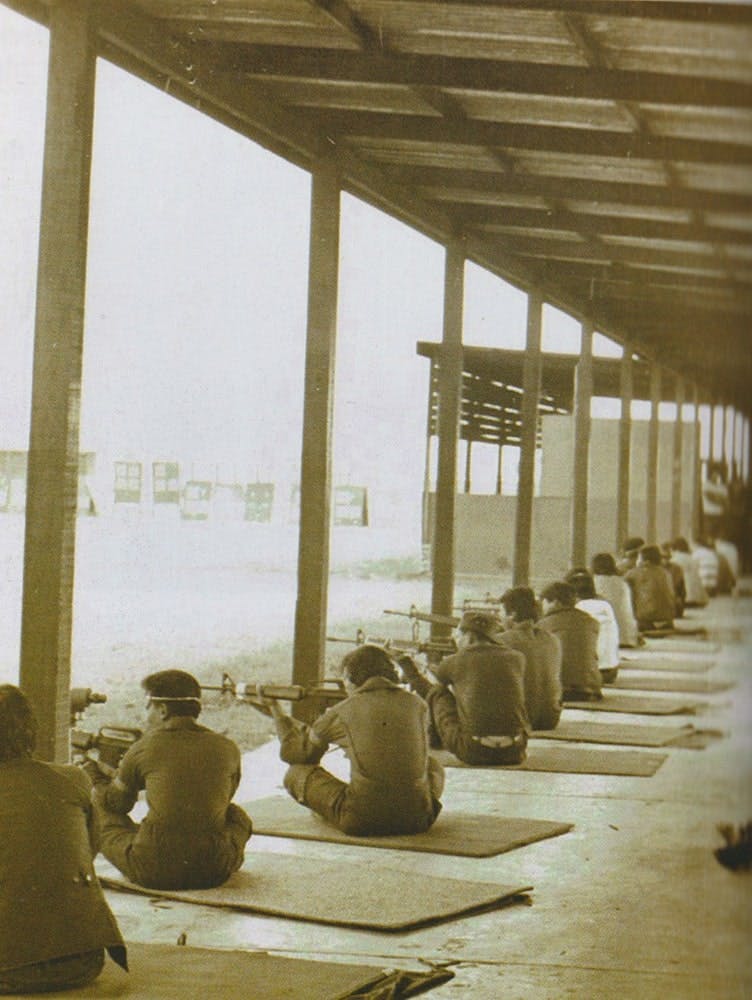 Members of the Alpha Com conducts a marksman training (1)
Members of the Alpha Com conducts a marksman training (1)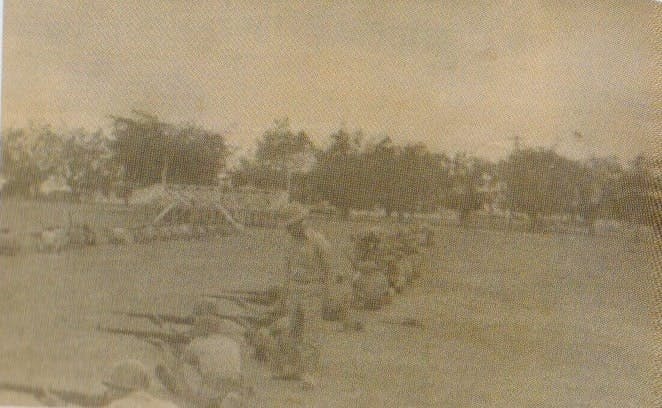 Members of the Alpha Com conducts a marksman training (2)
Members of the Alpha Com conducts a marksman training (2)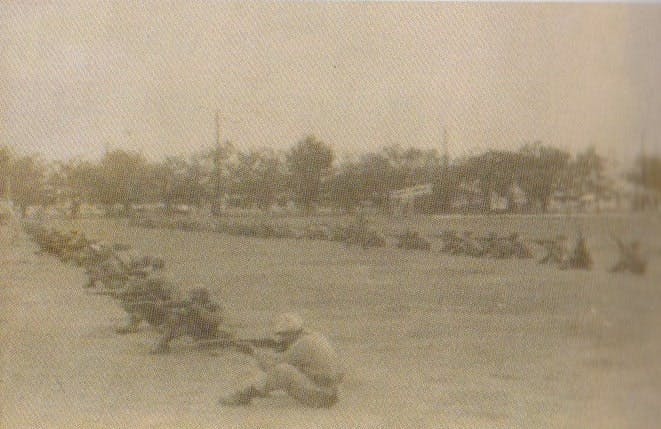 Record Firing
Record Firing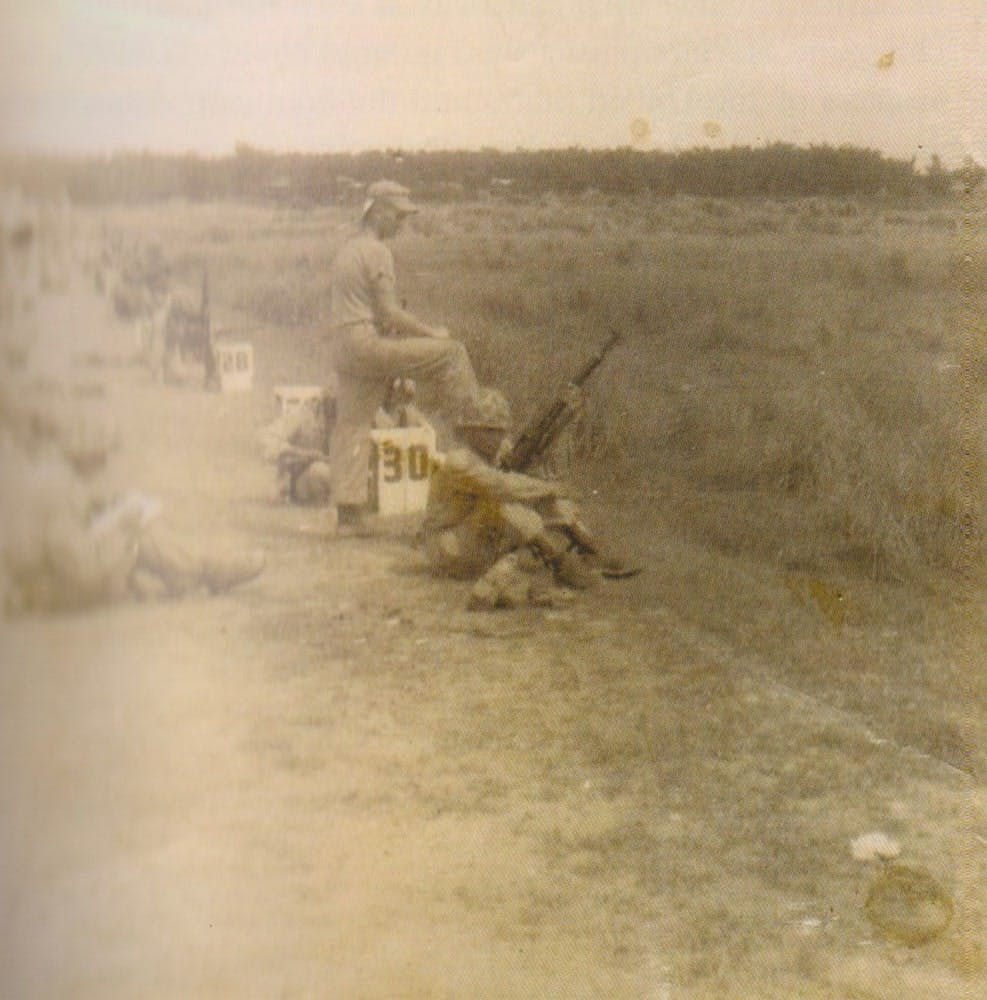
- On April 10, 1966, a Weapons Company was activated to provide the necessary fire and anti-tank support for the Philippine Marine Battalion as well as to provide ceremonial guard and security to VIPs.
- The Philippine Marines were mobilized to oversee the holding of peaceful and orderly elections in provinces considered 'hotspots" such as Ilocos Sur and Batanes.
1968
Unknown Date
Addition of Rifle Companies
Two years later, the Philippine Marine Battalion had increased to nine rifle companies.
1969
Unknown Date
Reserve Marksmanship and Sniper Detachment
- Marines activated additional units such as Reserve Marksmanship and Sniper Detachment (RMSD), which is the first marine reserve unit. The RMSD laid the foundation for the scout sniper capability of the Philippine Marines.
- This year, the Marines also subdued the notorious Suzuki Gang in Batanes.
1970
APRIL 1970
Establishment of 4th Marine Company
On April 10, 1970, the 4th Marine Company was organized and dispatched for duty to the Armed Forces of the Philippines Southwest Command (SOWESCOM).
1971
JUNE AND OCTOBER 1971
Kalayaan Island Group
The 5th, 6th, and 7th Marine Company were activated in June and October 1971, respectively. By this time, the Philippine Marines were ready to face the tumultuous Martial Law period in the Philippines.
Unknown Date
No Title
The Marines were sent to and occupied 8 islands of Kalayaan Island Group (KIG) to protect the country's sovereignty over the KIG. The highly top secret operation was the first time Marines had been used in a strategic nature. The Marines endured the isolation, psychological strain, and routine of protecting the isolated islets, like the largest Pag-Asa Island.
1972
FEBRUARY 1972
Rechristening of Philippine Marine Brigade
On February 15, 1972, the unit was officially renamed the Philippine Marine Brigade with the activation of two infantry battalions, a Headquarters, a Service Company, and a combat support group on February 21, 1972. 12 rifle companies were fielded for the 2nd Marine Battalion Landing Team.
APRIL 1972
Activation of 1st Marine Battalion Landing Team
In response to the growing secessionist problem in Mindanao, The 1st Battalion Landing Team, initially called the 1st Provisional Battalion, was activated on 21 April 1972.
JULY 1972
Recognized as Major Unit
The Philippine Marine Brigade was officially recognized as a major unit of the Navy on July 1, 1972, its first Commandant was Commodore Rudiardo A. Brown, AFP, followed by Brigadier General Rodolfo M. Punsalang, AFP.
SEPTEMBER 1972
Seizing of Firearms
When Martial Law was declared on September 21, 1972, the unit was tasked to confiscate firearms from the different private armed groups in the country.
OCTOBER 1972
Battle of Pantar Bridge
- On October 21, 1972, the Battle of Pantar Bridge and Marawi occurred. The Moro National Liberation Front (MNLF) attacked both Camp Amai-Pakpak in Marawi City and held hostages at Mindanao State University. From its headquarters in Lanao del Norte, MBLT-1 led by LTSG Daranciang and his troops rushed to the area and were able to retake Pantar Bridge from the rebels together with PC soldiers. They took control of the campus and freed about 200 civilian hostages, including the Japanese Ambassador Toshio Urabe who was visiting the university.
- After this incident, Lieutenant Daranciang was awarded the Gold Cross Medal while the rest of his men were given the Military Merit Medal and the Wounded Personnel Medal.
NOVEMBER 1972
Siege of Camp Seit
On November 14, 1972, 700 rebels with mortars, grenade launchers, and heavy machine guns attacked the camp defended by the 7th and 8th Marine Companies. The Marines held their ground despite overwhelming odds. By sundown, the enemy withdrew. However, due to the proximity of the MNLF, the 81 mm mortars and 105 mm howitzers the Marines had didn't work. An improvised wheeled armored vehicle called "Lakas Loob" helped the soldiers as it went around the perimeter and resupplied the troops with food and ammunition.
Punai Encounter
On November 23, 1972, the 4th Marine Company received a report that the 11th Infantry Battalion of the Philippine Army and armed groups had an encounter near Mt. Sinumaan. Lieutenant Commander Edgardo Espinosa was put in charge of the 2nd Marine Battalion Landing Team (MBLT-2), and was sent out southwest of Mt. Sinumaan to stop enemy reinforcements from the Kambing and Karundung area. The unit came under intense machine-gun fire from the rebels.
Battle of Sibalo Hill
- Soon after, on November 26, 1972, the Marines faced the MNLF again at Sibalo Hill where more than 500 MNLF rebels holed in. During this battle, Private First Class Nestor T. Acero gave his life to save his wounded batchmate Private First Class Vicente C. Buaya, showing the legendary marine esprit de corps and loyalty to comrade-at-arms.
- For this selfless work, Private First Class Acero was posthumously awarded the Medal for Valor, the highest award the Armed Forces of the Philippines gives to acts of gallantry beyond the call of duty.
- This battle claimed the lives of 43 Marines, making its first drawback in 20 years.
1973
July 1973
Operation Pamukpok
- Operation Pamukpok is considered the first successful amphibious operation in the history of the Philippine Navy.
- It was launched on July 7, 1973, at the barrio of Tuburan, which is a smuggler's haven in Basilan. MBLT-2 of the Philippine Marine Brigade headed by Lieutenant Commander Arturo Asuncion led the force together with the 4th, 5th, and 9th Marine Companies. Private Benito Reluya was injured by sniper fire in both legs. The three marine companies linked up and attacked the rebels in the schoolhouse and the Tuburan mosque that opened fire on disembarking marine forces with 81mm mortars and naval guns.
- After 36 hours, the mosque was taken and the area was secured. 31 rebels were killed, ammunition seized, while the 9th Marine Company's commander Lieutenant Junior Grade Renato Naco, and radioman Corporal Reynaldo Dumrique unfortunately passed away.
AUGUST 1973
Operation Batikus
- On August 16, 1973, Marines from Basilan were tasked to restore peace and order in Siasi Island. Calling it 'Operation Batikus". The MBLT-2, led by Lieutenant Commander Arturo T. Asuncion got on the Republic of the Philippine Ship (RPS) Narra and RPS Oriental Mindoro to refuel and prepare in Zamboanga.
- The 5th Marine Company boarded Landing Craft Mechanized (LCM) 249 and the Landing Craft Vehicle Personnel, while 4th Marine Company troops boarded Landing Craft Tank (LCT) Lupasug and were sniped by enemies while pushing on Hill 45. Nonetheless, The Marines seized Hill 45 after a firefight. RPS Rizal and RPS Narra destroyed the bancas and pump boats of the enemies, ending Operation Batikus.
Oplan Kahil
- Not leaving Siasi Island in Sulu, the Marines started 'Oplan Kahil' on August 20, 1973. Navy Captain Arturo T. Asuncion led MBLT-2 against the rebel stronghold Hill 113. During a month-long operation, both the 24th Infantry Battalion and the Constabulary's 47th Company captured Hill 113.
- On this operation, the Pambansang Awit was played and boosted the morale of wounded Marines who were treated by Private Ildefonso Agbigay.
1974
Unknown Date
Establishment of Marine Base Ternate
The strategic location of Ternate in Cavite has been seen as a Naval Reservation way back in 1904. It was exclusively for the Philippine Navy and Philippine Marines. During the year of 1974, the Philippine Marines used Ternate, Cavite for field training exercises and jungle training.
JULY 1974
Miss Universe in the Philippines
On July 4, 1974, the Philippines hosted the Miss Universe and the Marines were tasked to protect the contestants during the pageant.
AUGUST 1974
Oplan Walis
- This amphibious operation aimed to neutralize Sacol Island where the smugglers hid their swift watercraft and rebels used it as a refueling station for their speedboats. A naval blockade on the island was imposed from August 2 to August 14, 1974.
- On August 14, the first and second waves of Marines went and landed on Red Beach without any trouble. The marine battalion jumped off to Landang Gua and recovered several ammunition, explosives, and vital documents. Two Naval Special Warfare Group (NASWAG) teams and one marine company jumped off swamp areas and mopping operations were conducted, they were also able to confiscate speed boats with nearby ammunition.
- For 13 days, the MBLT-2 guarded Sacol Island supported by RPS Datu Kalantiaw and three Philippine Craft Fast (PCF). During this time, the rebels tried to avoid the government. Eventually, the marines successfully secured Zamboanga city from enemy presence.
NOVEMBER 1974
Battle of Karundung
- The Marines saw action in Karundung, Tawi-tawi, which was also the stronghold of MNLF. The 3rd Marine Battalion fought 'one of its fiercest battles in the annals of the history of the Philippine Marines". On November 19, 1974, a 35-man Marine platoon met rebels who wanted to trap them. The Marines held their ground and fought back. The platoon leader, Ensign Richard Luague, ordered a retreat due to running out of ammunition but the rebels rushed forward and engaged more in close combat. Unable to call reinforcements, the troops were outnumbered.
- The wounded Ensign Luague and Staff Sergeant Marcial Pilar led 11 members of the platoon to safety. The 10th Marine Company rescued the remaining platoons and it claimed the lives of 19 Marines, 14 members were wounded. The gallantry of the Marines were awarded the Distinguished Conduct Star, the second highest decoration.
1975
Unknown Date
Recognition during 25th Aniversary
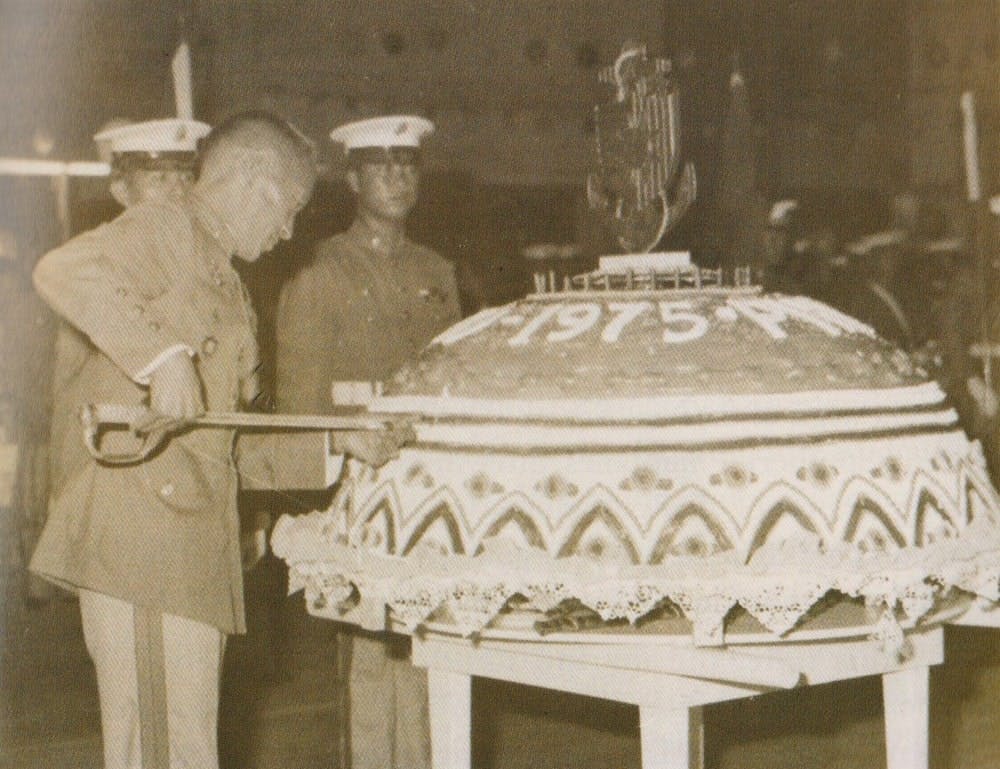 Awarding of anti-dissidence streamer campaign
Awarding of anti-dissidence streamer campaign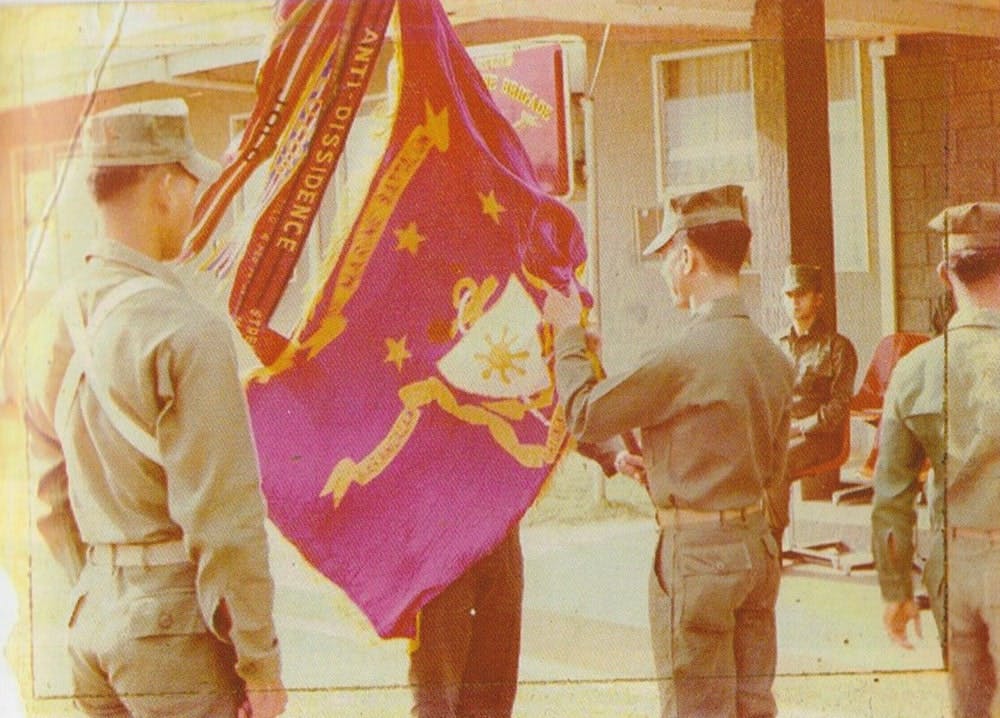 President Marcos during one of his visits to the PMC HQ
President Marcos during one of his visits to the PMC HQ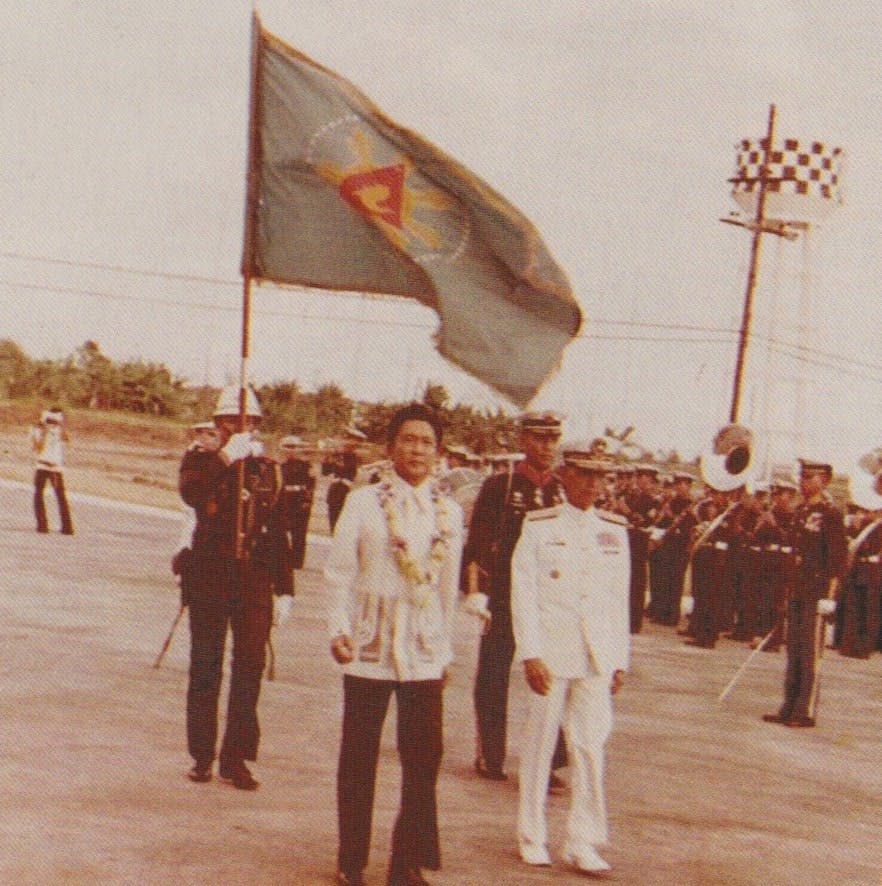 Special guests on stage during the Marines 25th Anniversary
Special guests on stage during the Marines 25th Anniversary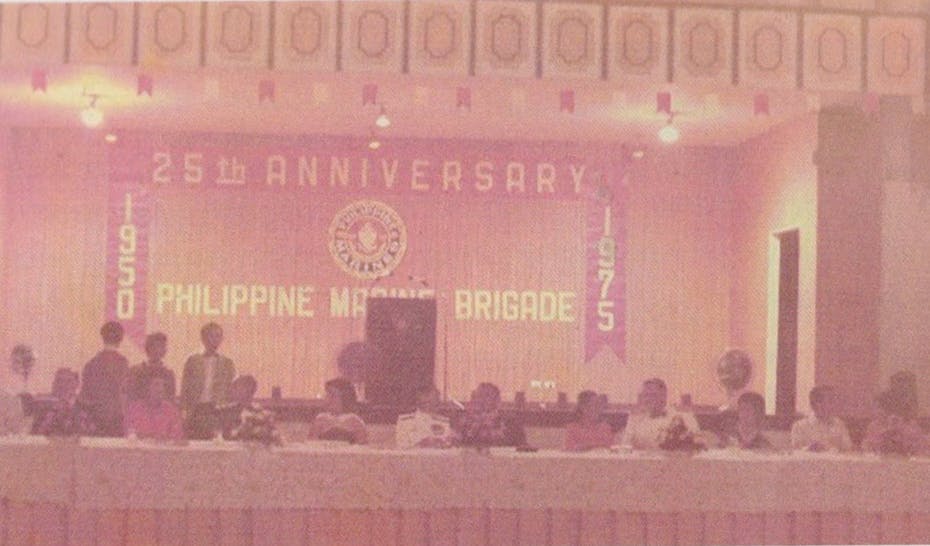
The 5th, 6th, and 7th Marine Company were activated in June and October 1971, respectively. By this time, the Philippine Marines were ready to face the tumultuous Martial Law period in the Philippines.
APRIL 1975
No Title
Due to the demands of keeping the peace in Southern Philippines, three more battalions were organized, totaling five battalions by April 15, 1975. Four marine battalion landing teams were organized to conduct amphibious and ground operations in the Southwest Command Area.
1976
JUNE 1976
No Title
The 1972 Philippine Marine Brigade was designated as Philippine Marines and the Philippine Marine Training Center was renamed as the Marine Training Group on the same day, June 1, 1976.
1978
APRIL 1978
No Title
On April 29, 2978, the 2nd Marine Brigade was activated for deployment in Palawan and the Kalayaan Group Islands to join other units in safeguarding and protecting our country’s sovereignty.
JULY 1978
No Title
On July 28, 1978, 14th Marine Company was also activated.
Unknown Date
No Title
The first Marine Advance Noncommissioned Officer Leadership Course was conducted in 1978 to enhance the ideological motivations and commitment of the noncommissioned officers on their role in socio-economic development and the maintenance of national stability.
1980
Unknown Date
Rise of Communism
Communism rose to prominence again in the 1980s. This fresh information prompted the deployment of more Marine battalions to communist strongholds.
1982
Unknown Date
Creation of 3rd Marine Brigade
The 3rd Marine Brigade was organized in 1982.
1983
June 1983
Crushing of Local Communist Movement
The Main Regular Guerrilla Unit (MRGU) of the New People's Army (NPA) was crushed by the 5th Marine Battalion on June 20, 1983, during a three-month combat campaign spanning seven provinces and seven hundred kilometers from Davao del Norte to Surigao Del Sur. The Local Communist Movement suffered a huge blow after 32 rebels were murdered and 21 different high-powered weaponry were discovered.
1984
July 1984
Wiping NPA Insurgents in Davao
Another big event occurred on July 3, 1984, when MBLT-2 under the 3rd Marine Brigade nearly annihilated a platoon of NPA insurgents in the Tugbok District, Davao City. Communists in Mindanao ended during 1983–1987.
Unknown Date
Start of Civil-Military Operations
Also in 1984, the 3rd Marine Brigade changed the unit's approach 'from combat offensive operations to Civil Military Operations (CMO) ." starting in the form of pulong-pulong. Because of this, PMC has gradually become well-loved by the locals.
1986
Unknown Date
People Power I and the Marines
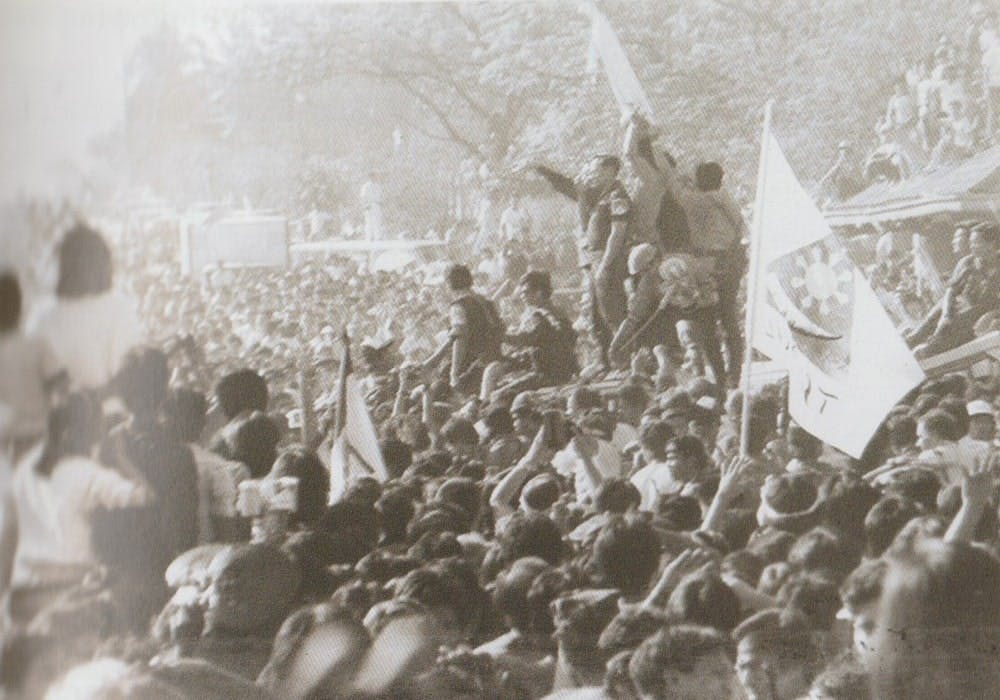 People celebrated upon hearing news that President Marcos left the country
People celebrated upon hearing news that President Marcos left the country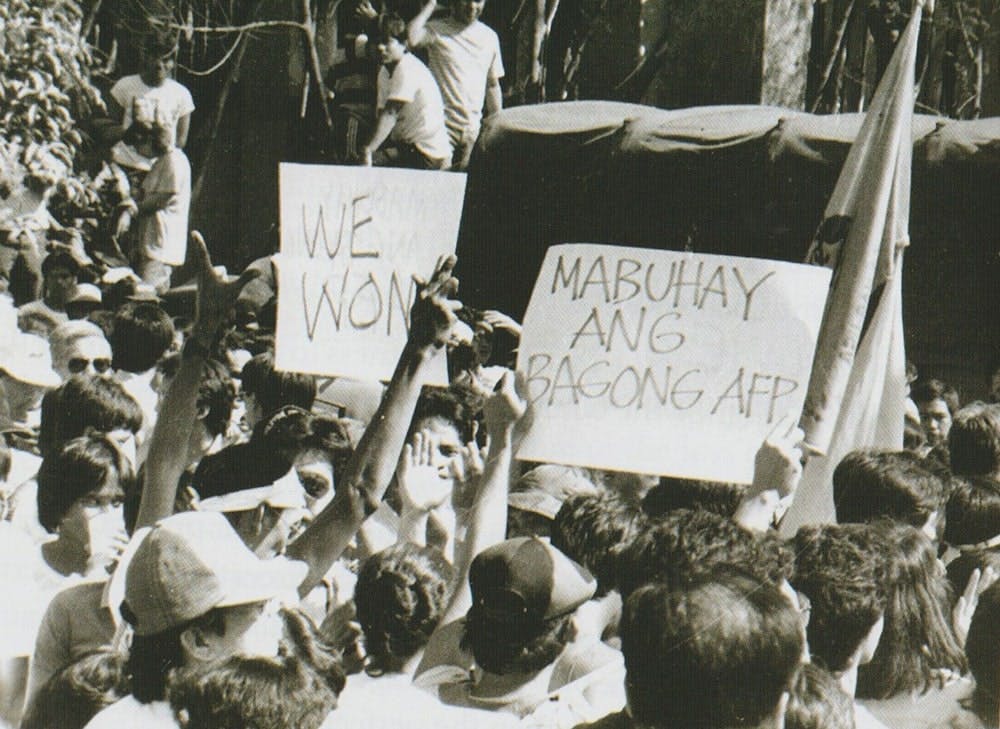 Philippine Marines and EDSA Revolution 1986
Philippine Marines and EDSA Revolution 1986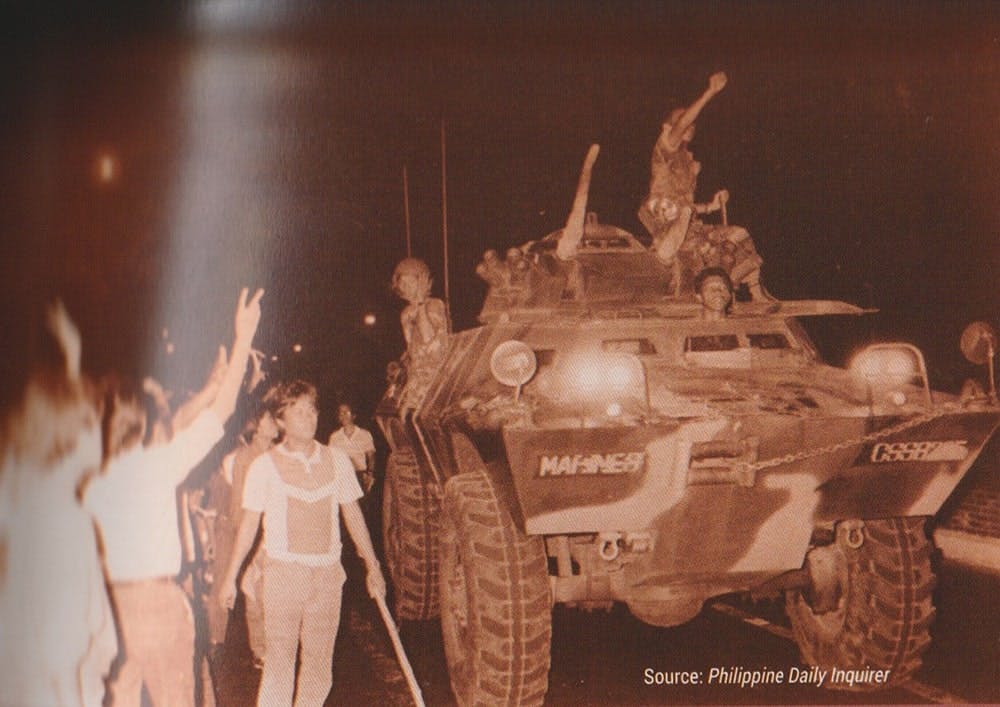 Displaying PH Security Forces marches at EDSA for crowd management mission but later on joined the masses during the People Power
Displaying PH Security Forces marches at EDSA for crowd management mission but later on joined the masses during the People Power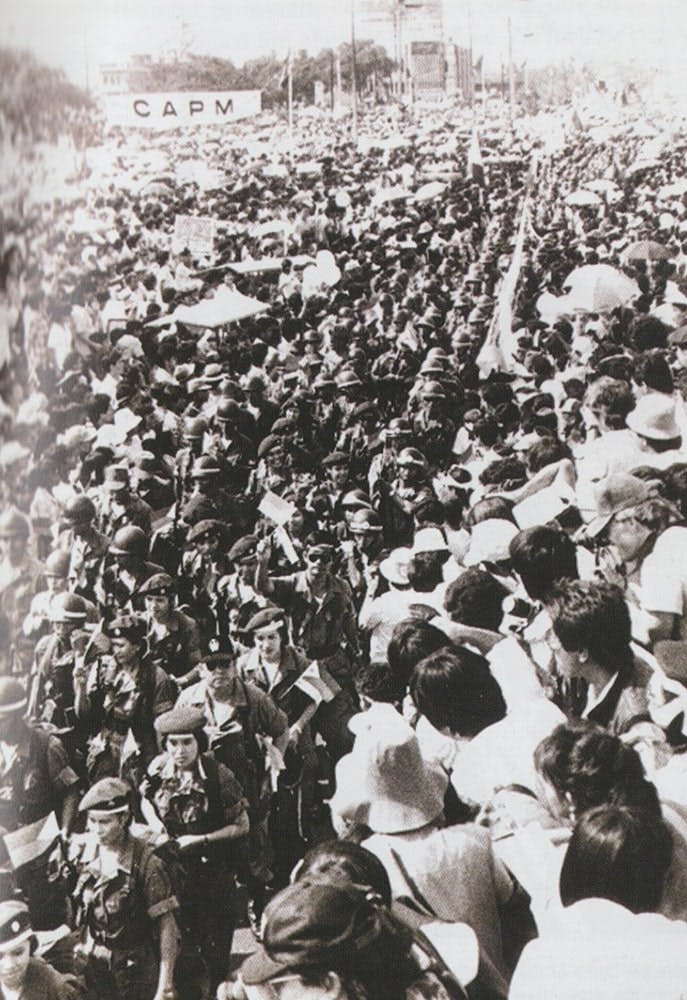 Series of street protests to mass action in People Power 1
Series of street protests to mass action in People Power 1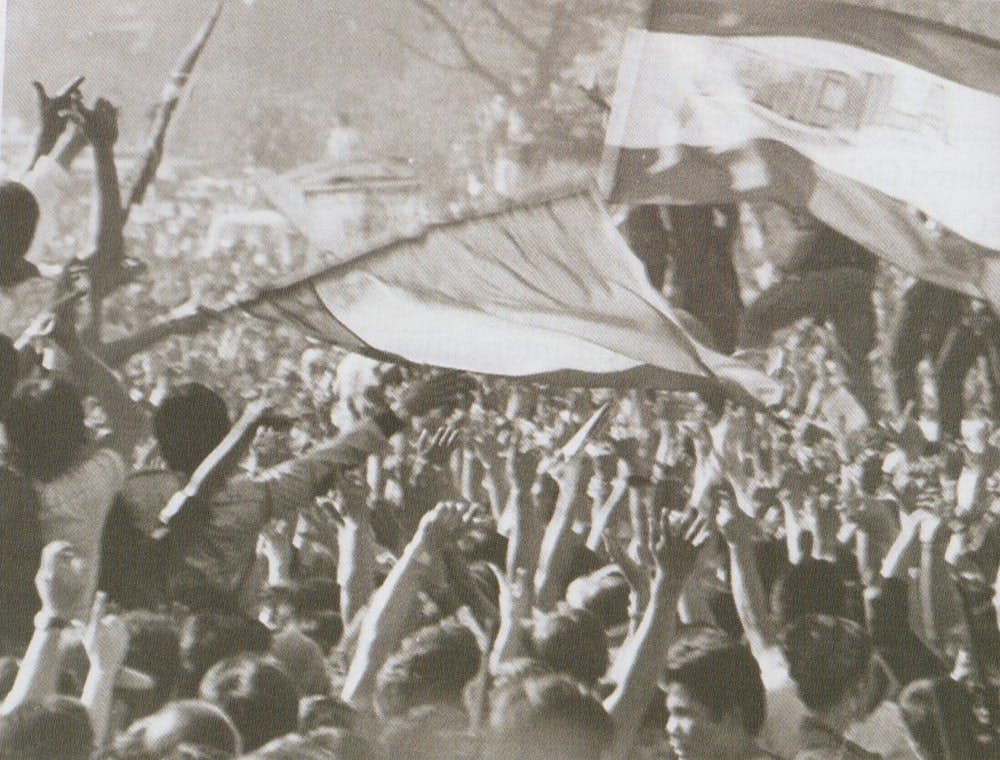 Displaying Some of the security forces together with the members of the media tried to capture the event in PH history
Displaying Some of the security forces together with the members of the media tried to capture the event in PH history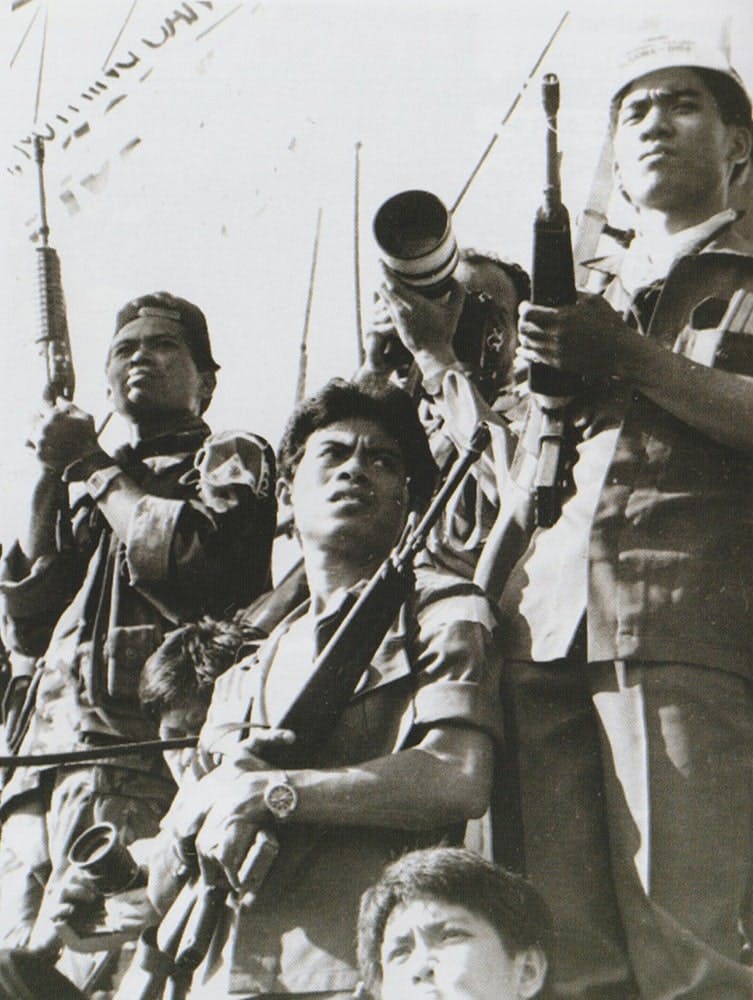 The Marines served as a barrier during the People Power
The Marines served as a barrier during the People Power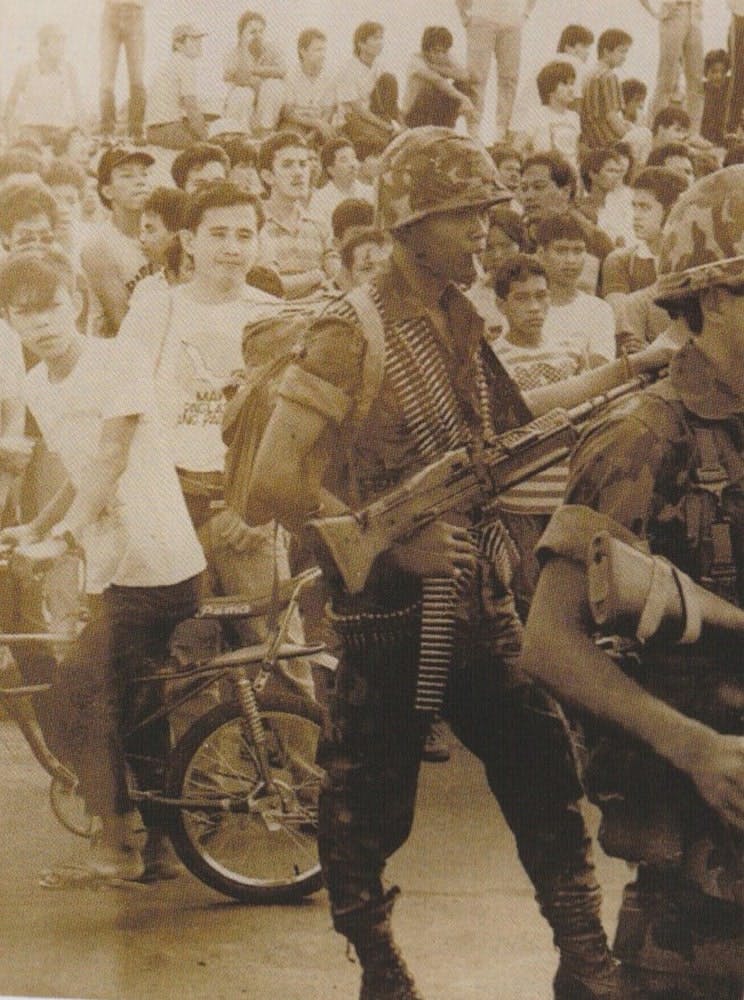
- During the People Power I in 1986, the crowd amassed at EDSA to show support for the uprising led by Enrile and Ramos, the Marines were sent to attack Camp Aquinaldo and Camp Crame but were stopped by a human barricade composed of ordinary folks, nuns and priests.
- Despite the cursing of Marine officers and sergeants, no soldier fired at the citizens. General Tadiar ordered the Marines to return to Fort Bonifacio. It was during this time that the Marines upheld and portrayed loyalty to the Filipino people.
1987
August 1987
Marines Quell a Coup
- On August 28, 1987, Reformed the Armed Forces Movement (RAM) officer Colonel Gregorio Honasan staged simultaneous attacks to show dissatisfaction with the Aquino Administration, The 1st Marine Battalion was ordered to proceed to Camp Aguinaldo. The Marines ambushed the mutinous soldiers but were met by firepower when they breached Gate 3.
- Some of the rebel soldiers conceded and were held in custody. The troops then evacuated 50 military officers and personnel at the General Headquarters. Colonel Honasan escaped from Camp Aguinaldo while 125 armed rebel soldiers surrendered to the Marines.
1989
December 1989
The Military Coup Attempt
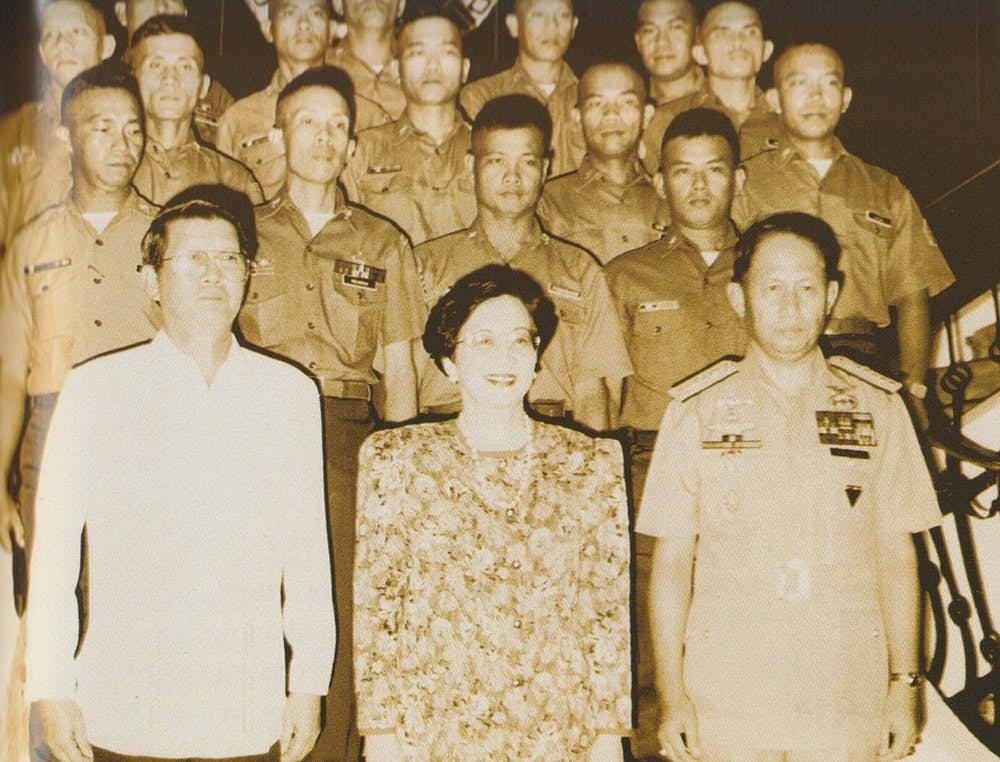 Marines sitting outside the perimeter of Camp Aguinaldo
Marines sitting outside the perimeter of Camp Aguinaldo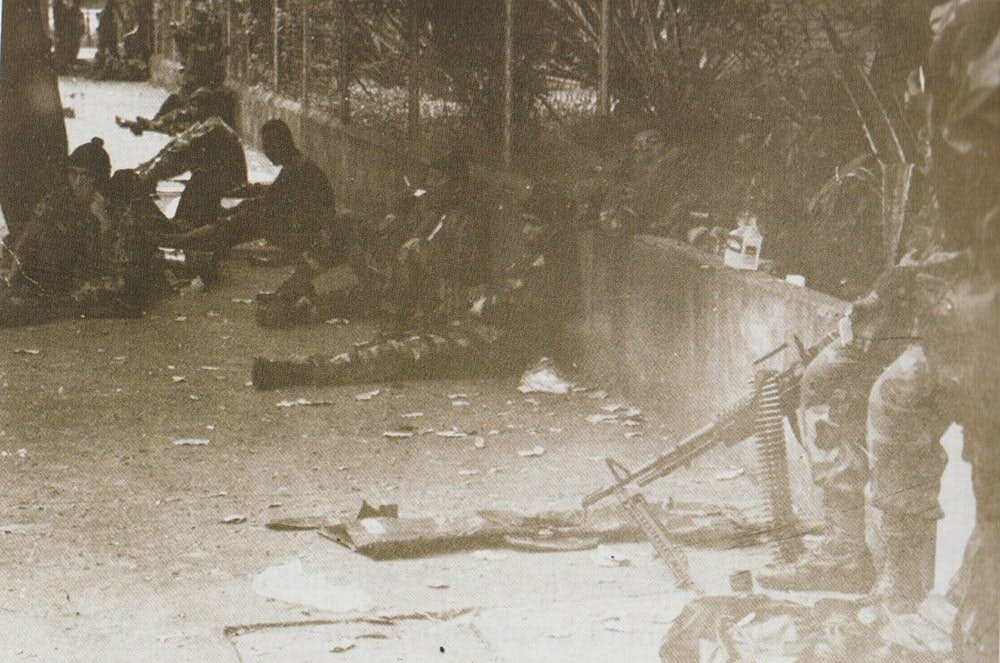
- On December 1, 1989, a small group of Marines led by LtCol Romelino Gojo, an operations chief of the Philippine Marines and a cousin of Honasan, sided with rebel soldiers of RAM and was backed by Major Cesar de la Pena who was a commanding officer of MBLT-4. The rebel troops took over several airbases, channels, and airports. The rebels bombed the Malacanang Palace and fired shots at Camp Crame and Camp Aguinaldo.
- US Ambassador Platt assisted the Philippine government and President Cory requested persuasion flights over Manila to stop rebel aircraft from operating. The rebel troops attempted to overrun the two camps but were met against loyal troops from the Marines. The rebels soon forfeited and the government had a mopping operation to negotiate with the military rebels.
- After the failed coup, the 4th Marine Battalion dissolved, and the 11th Marine Battalion was activated.
1990
Unknown Date
Rise of Abu Sayaff Group
The Marines saw the rise of the Abu Sayaff Group (ASG), a new terrorist organization on the island of Mindanao.
1991
April 1991
Anti-Kidnapping Efforts
Due to the spike of kidnapping incidents in Cotabato, MBLT-2 flew to Awang Airport in April 1991 upon orders of then-President Corazon Aquino to support the anti-kidnapping efforts of Task Force Kutawato of the 6th Infantry Division of the Philippine Army. The unit earned the respect of the people as it helped reduce the threat of kidnapping in the city.
1992 - Nearing the term of President Fidel Ramos
MARCH 1992
Kidnapping and Rescue of Foreign Nationals
On March 20, 1992, MNLF Lost Command kidnapped five foreign nationals, and the 2nd Marine Brigade under Brigadier General Antonio M. Villamor successfully negotiated the release of the hostages.
AUGUST 1992
Petition for Retention in Cotabato City
On August 7, 1992, various stakeholders of Cotabato City and its surrounding areas petitioned President Fidel to keep the Marines to protect the city. This was highlighted in two major newspapers.
DECEMBER 1992
Capturing of Notorious Leader
The Marines were able to neutralize the notorious kidnapping leader Abogado Bago (a.k.a. Kumander Mubarak) in Davao de Oro on December 7, 1992.
1993
Unknown Date
No Title
The General Headquarters of AFP approved the procurement of a Marine-accepted version of Light Armor Vehicle (LAV) 300 to improve its amphibious capabilities.
FEBRUARY 1993
Notoriety of ASG
The Abu Sayyaf Group attracted widespread media coverage in February 1993 after it carried out a string of kidnappings in Basilan Province. The ASG kidnapped a claretian priest Fr. Blanco and a 5-year-old boy named Anthony Biel III. Brigadier General Guillermo R. Ruiz from the 2nd Marine Brigade launched 14 operations which made Fr. Blanco escape, Biel was released and Abu Sayyaf stronghold was captured at Camp Al-Madinah.
1994
JUNE 1994
Basilan Operation
In June 1994, Abu Sayyaf kidnapped a catholic priest named Cirilo Nacorda, and 20 teachers in Isabela, Basilan. Military operations were led by the 3rd Marine Brigade under Colonel Edgardo V. Espinosa. Fifteen Christian teachers were massacred by Abu Sayyaf.
JULY 1994
CMO Activities Continue
Meanwhile, the 6th Marine Battalion returned to Palawan Island on July 5, 1994. The unit was given the additional task of sustaining the government's development program. The Marines were deputized by the DENR to implement Presidential Decrees 704 and 705, both aimed at protecting the environment.
SEPTEMBER 1994
End of Basilan Operation
A 3-month massive military operation ensued and in September 1994, the leader of ASG kidnapping Barahama Sali was finally killed and Fr. Nacorda was rescued.
1995
November 1995
Further Strengthening of the Corps
- The Philippine Marine was officially rechristened as the Philippine Marine Corps, Philippine Navy on November 7, 1995. From a small group of volunteers, the Corps has grown to include three Marine Brigades, one Marine Reserve Brigade, and ten Battalion Landing Teams, one Combat Support Brigade, one Reconnaissance Battalion, a Training Center, a Headquarters Battalion, and a Marine Security Escort Group.
- RA 7898 known as 'Armed Forces of the Philippines Modernization Law" was passed for further strengthening the PMC in the Program Re-prioritized List (PRL), the Marines were allotted funds to purchase their Amphibious Assault Vehicles (AAVs) which would make it the legitimate Amphibious Force of the AFP.
1996
Unknown Date
Palarong Pambasa
In 1996, the 2nd Marine Brigade was sent to Cotabato to provide security for the Palarong Pambasa. The brigade was initially part of Task Force Tabang which was an anti-kidnapping force.
October 1996
Activation of 4th Marine Brigade
The 4th Marine Brigade (Res) is a reserve unit of the Marine Corps which was activated on October 22 and was put under the operational control of the Marine Corps. Colonel Danilo L Gamboa, PN is the Commanding Officer of the 4Mbde (Res).
1997
MARCH 1997
Adoption of Schools in Cotabato City
In March 1997, the 2nd Marine Brigade arrived in Cotabato City from its home base in Tawi-Tawi. The Marines initiated various projects in the city and 'adopted" schools to help students familiarize themselves with their economic situations, Islamic heritage, and environmental preservations of the area.
DECEMBER 1997
Christmas Party in Central Mindanao
In December 1997, the 5th Marine Battalion and 2nd Marine Brigade led by Colonel Librado S. Ladia invited underprivileged children to a Christmas party and made good impressions on the families of Central Mindanao.
2000
MARCH 2000
Kauswagan Siege
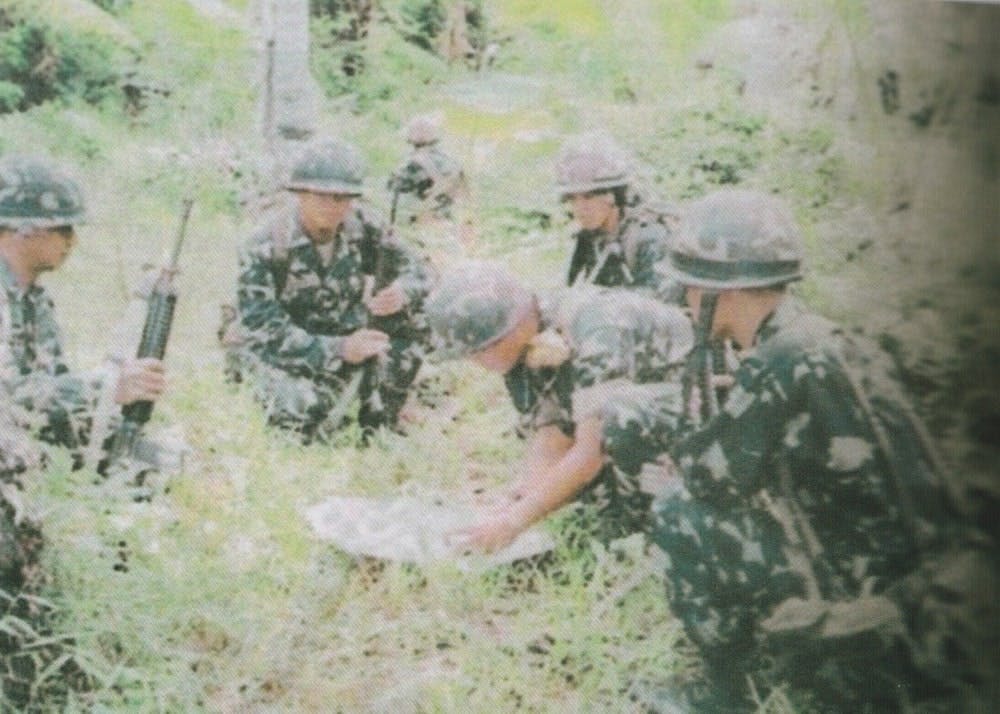 Marines deployed to Central Mindanao for the campaign against the MILF
Marines deployed to Central Mindanao for the campaign against the MILF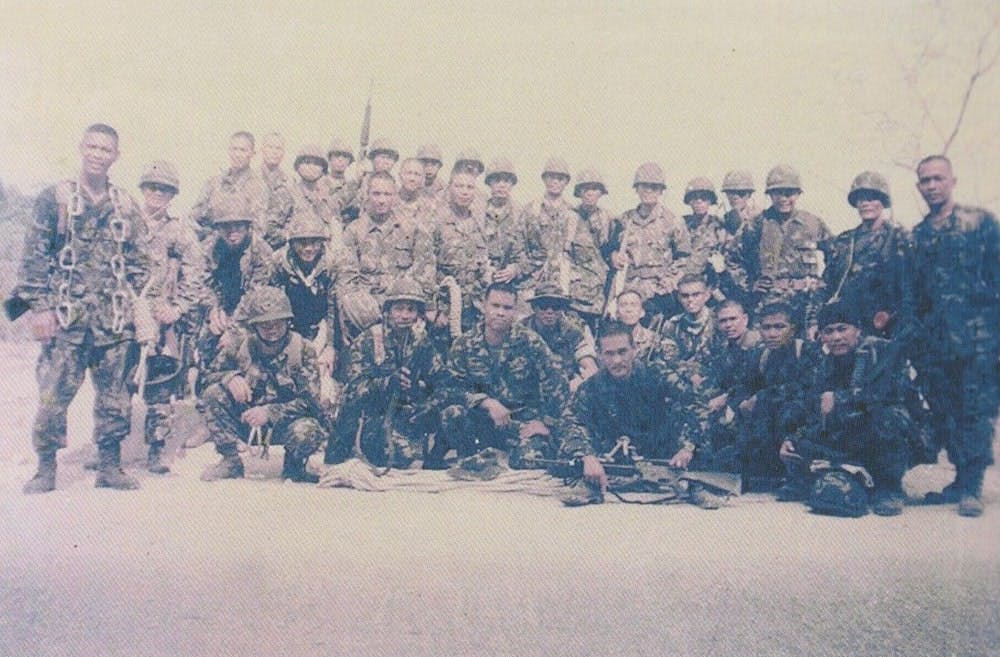 Marines pray prior the start of military operations during Central Mindanao campaign
Marines pray prior the start of military operations during Central Mindanao campaign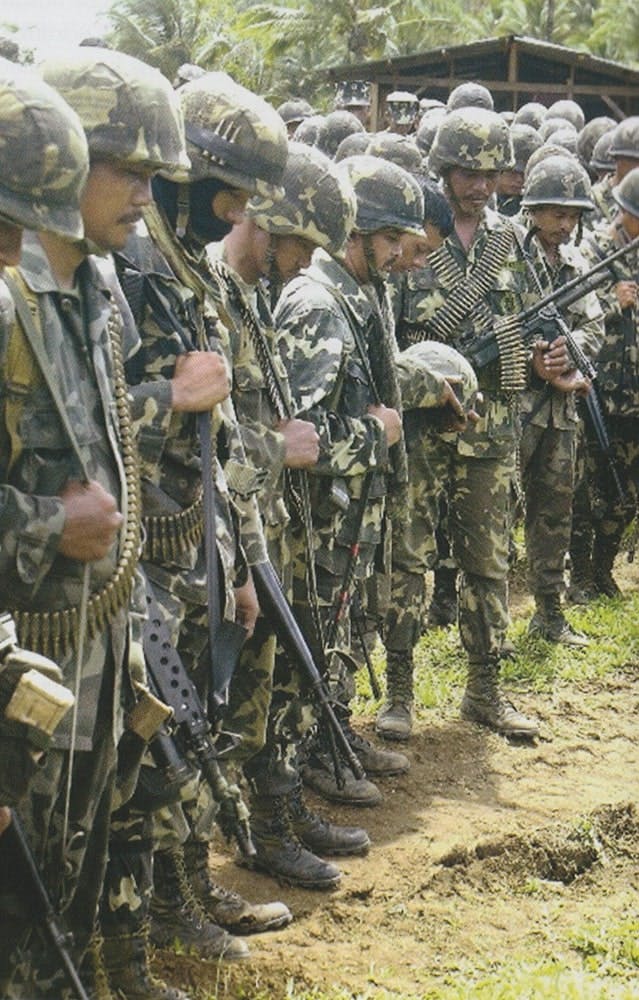 Marines take a photo after pursuit operations
Marines take a photo after pursuit operations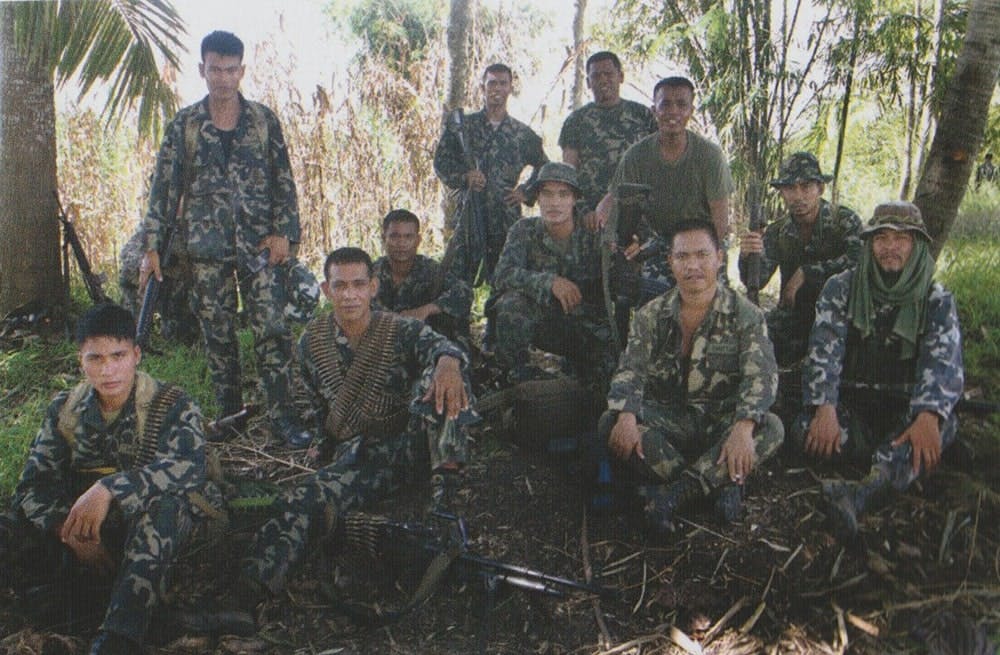
- The 303rd Brigade of the MILF led by Abdullah Macapaar (a.k.a. Commander Bravo) was responsible for the renewed violence in the town of Kauswagan. On March 16, 2000, the MILF seized the Kauswagan Town Hall and held over 300 resident prisoners. The 1st Marine Brigade along with two accounts from the 34th Marine Company and MBLT-4 had liberated Kauswagan after a 24-hour firefight against the MILF. The Marines rescued the hostages and Commander Bravo retreated together with his followers.
- After the Kauswagan incident, then-President Joseph Estrada declared a military campaign against the MILF.
Occupying Camp Bilal
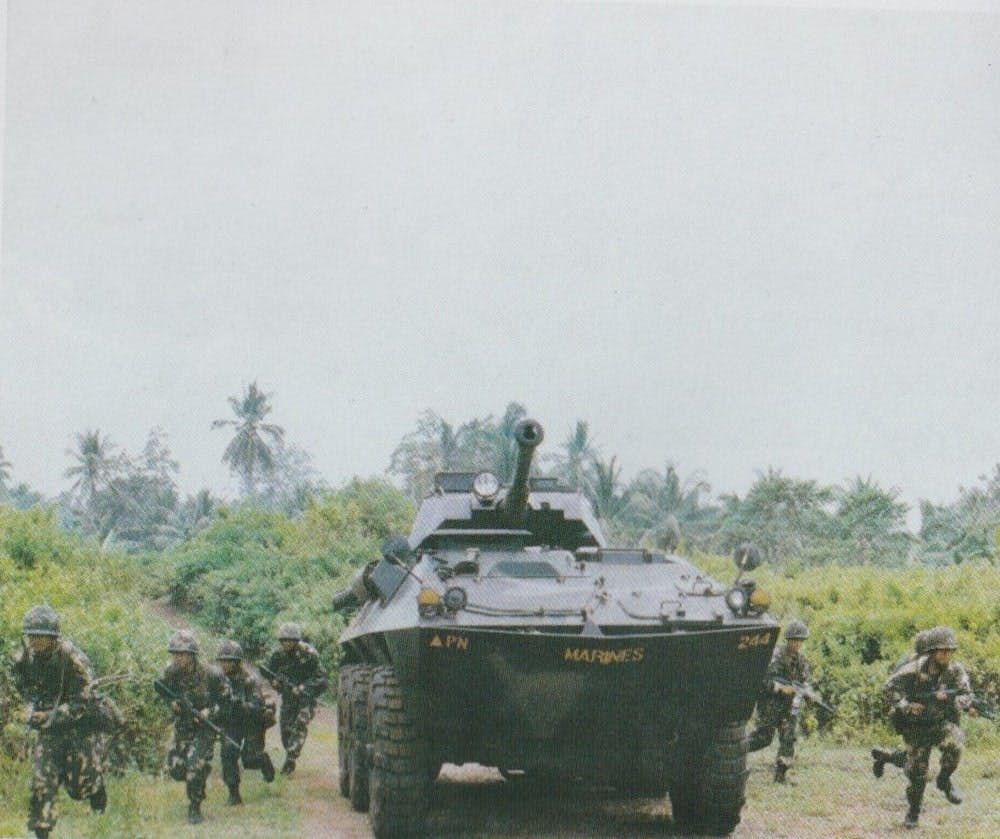 PMC marches off during their deployment in Central Mindanao to respond the campaign against MILF
PMC marches off during their deployment in Central Mindanao to respond the campaign against MILF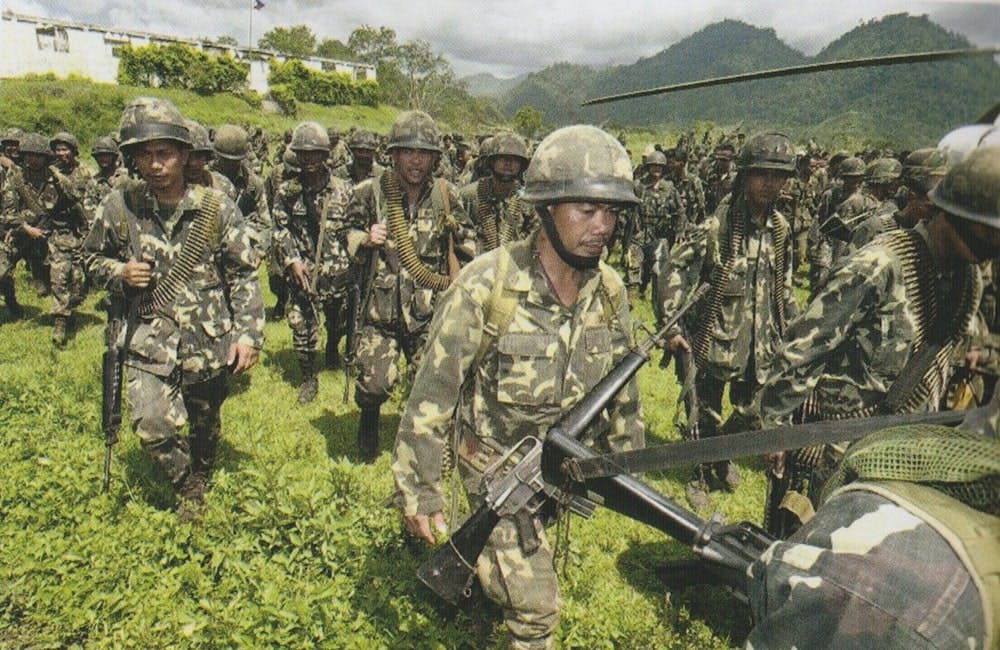 V300 utilized during the Central Mindanao Campaign
V300 utilized during the Central Mindanao Campaign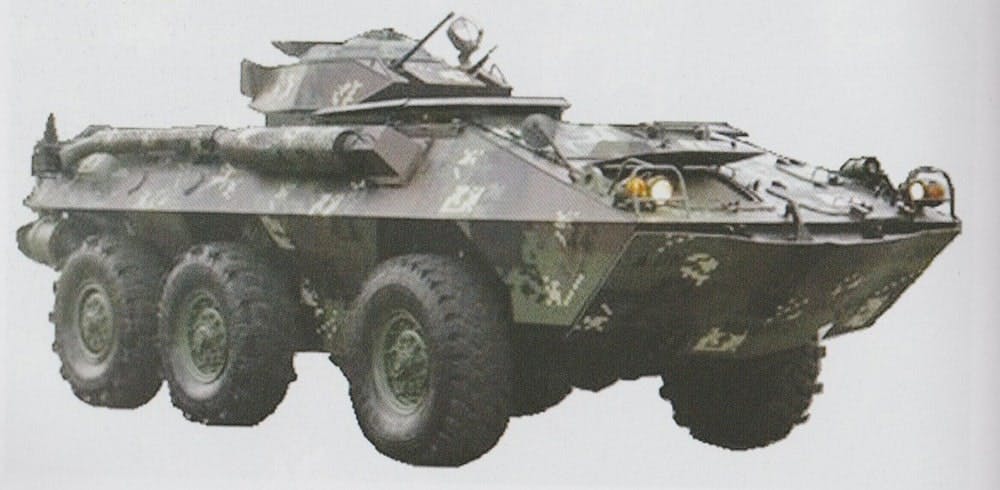
In order to degrade the military strength of MILF, the 4th Infantry Division launched 'Operation Sovereign" on March 21, 2000, to occupy Camp Bilal in Lanao Del Norte, the third largest MILF camp. The 1st Marine Brigade moved towards Camp Bilal. Five days later, the troops could not dislodge the enemies nor destroy their defenses.
APRIL 2000
Liberation of Camp Bilal
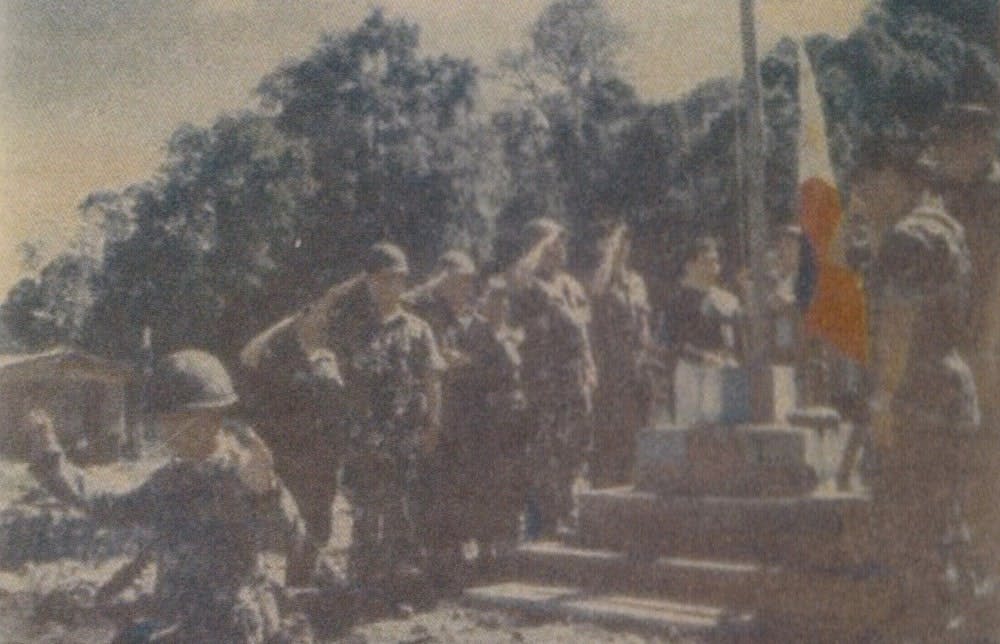 Bandits were arrested after the MILF campaign
Bandits were arrested after the MILF campaign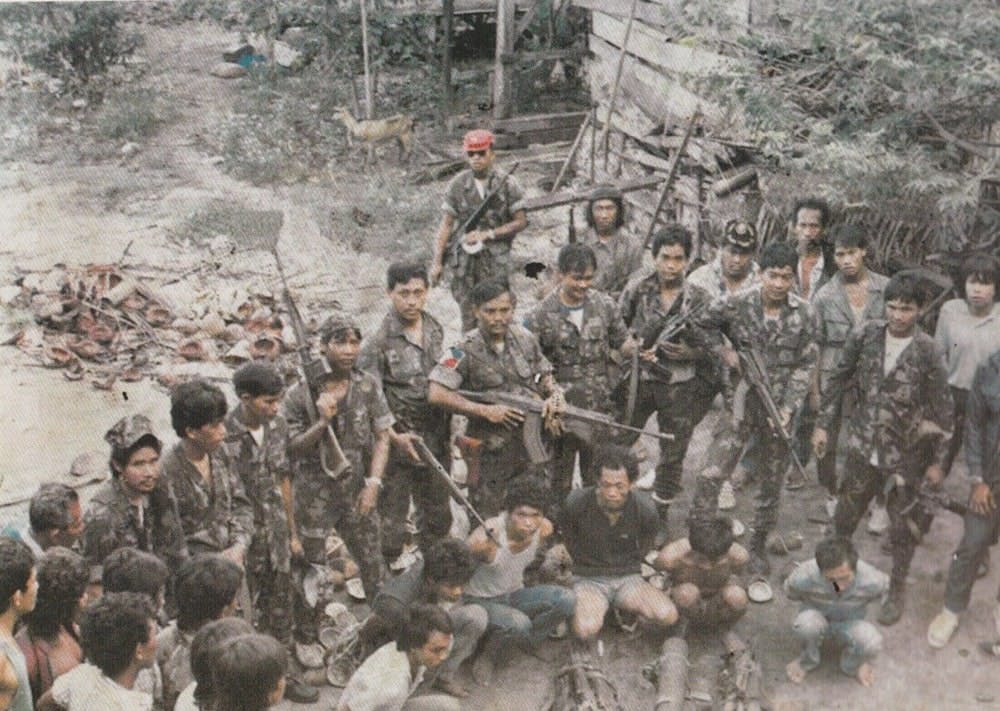
The Marines redirected their plans. On April 13, the 1st Marine Battalion led the assault from the main road while the 10th and MBLT-4 took the side ridges. Major Alexander F. Balutan hatched a strategy called 'Mandirigma" which proved effective against enemy snipers. As the fight ensued, a corpsman named Corporal Campos sacrificed his life to save nine wounded marines. Corporal Campos posthumously received the Medal for Valor. The following day, Camp Bilal was declared liberated.
Attack on Camp Busrah
The 4th and 10th Marine Battalion under the 1st Marine Brigade deployed to Barangay Butig where Camp Busrah is located, its entrance was Hill 963 and the troops swiftly reached the top of Hill 963. A short exchange of fire landed between the Marines and 20 MILF fighters. Afterward, Camp Busrah was taken without any resistance due to the abandonment of MILF after a previous aerial ambush of Philippine Air Force (PAF) to Camp Busrah.
JULY 2000
Fall of Camp Abubakar
- As MILF ignored the final call of then-President Estrada to surrender, 'Operation Terminal Velocity" was launched on July 1, 2000, to target Camp Abubakar, the largest MILF camp. Despite aerial bombings and artillery assaults, the MILF stood its ground. MBLT-2 of the 3rd Marine Brigade was tasked to weaken Camp Sarmiento, which is the last bastion of defense before the main MILF camp.
- The brutal fight from Camp Sarmiento lasted for 5 days, PAF assisted the Marines by deploying aircraft on the battlefield. Finally, Camp Abubakar was overrun on July 9, 2000. This is the direct result of the persistent military operations led by the 1st and 3rd Marine Brigades in Central Mindanao. Seven Marines received the Medal for Valor.
NOVEMBER 2000
Philippine Marine Corps Act
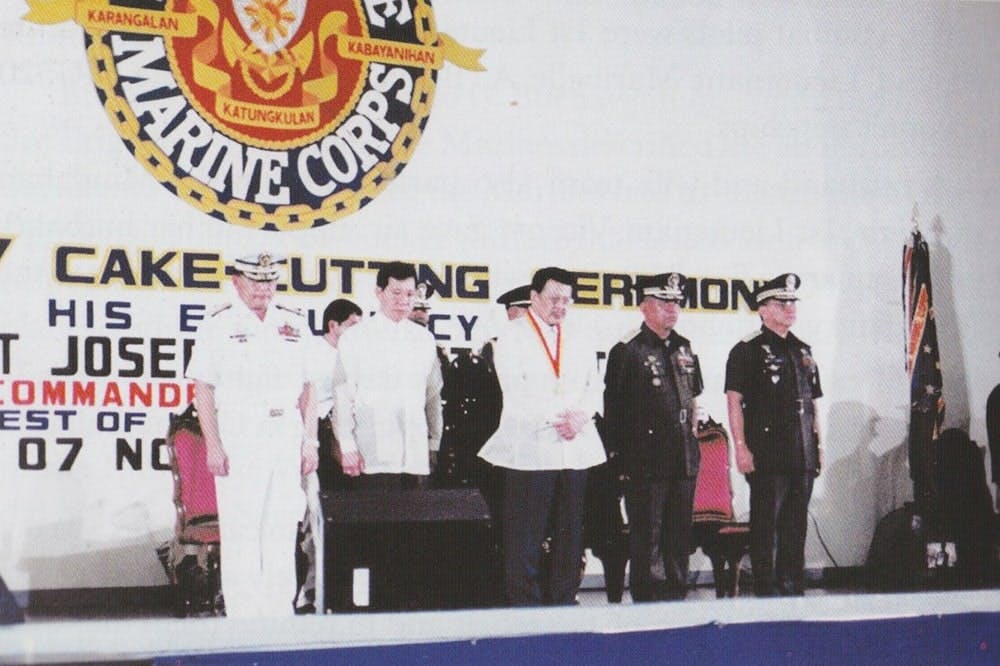 General Rodolfo Biazon, Commandant of PMC 1987-1989
General Rodolfo Biazon, Commandant of PMC 1987-1989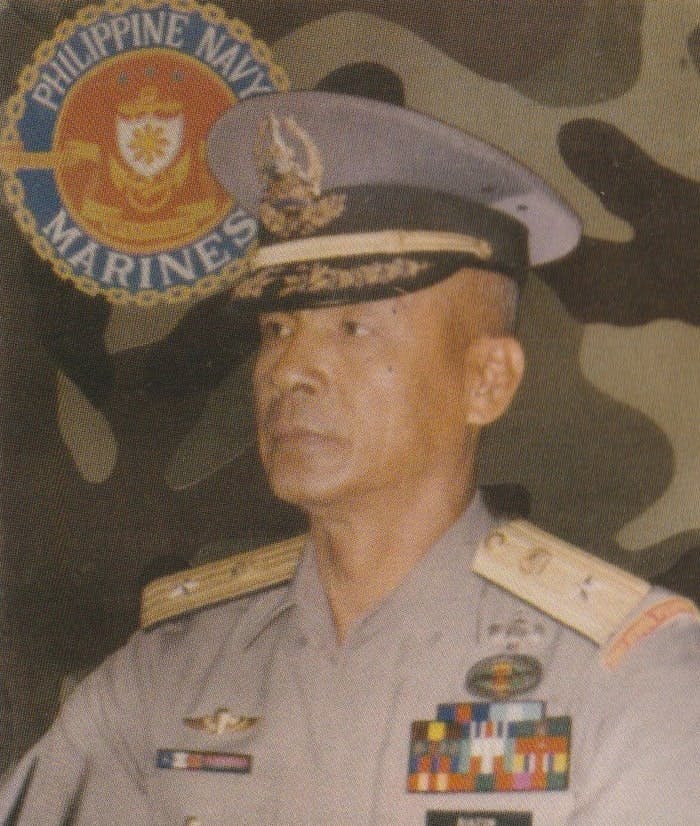
- The PMC 50th-anniversary celebration was also the month when the 11th H.B. no. 9402 entitled 'Philippine Marine Corps Act'' was introduced by Congressman Antonio Nachura to ensure that the PMC had sufficient resources and support to continuously perform its mission efficiently and be a separate major unit of the Philippine Navy.
- Another bill was sponsored by Former General and Senator Rodolfo Biazon which was the S.B. no. 1866 namely 'National Defense and Security Act of 2000" serving as the legal basis for the creation of PMC.
2001 - GMA Administration
SEPTEMBER 2001
Visitation of the President
As then-President Arroyo took over the office in June 2001, the Philippine Marines Corps showed support to the administration which made President Arroyo visit the Marine Headquarters on September 3, 2001.
NOVEMBER 2001
No Title
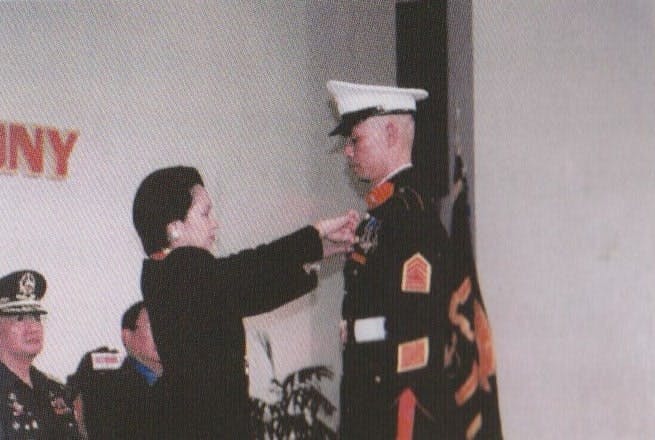 President Gloria Arroyo awards the distinguished Marines and the wife of a Marine who died in a combat ops
President Gloria Arroyo awards the distinguished Marines and the wife of a Marine who died in a combat ops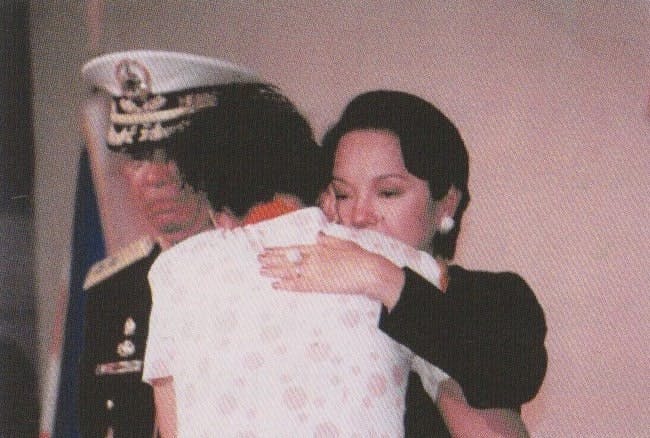
President Arroyo graced the PMC anniversary celebration on November 7, 2001.
2002
Unknown Date
Recognition for CMO Activities
The 8th Marine Battalion was recognized as the Best Marine Battalion of 2002 for its numerous civil-military operations conducted in the Southern part of the Philippines.
JUNE 2002
The capture of Abu Sabaya
The ASG continues to wreak havoc, the 40 PMC intelligence officers strategized an elaborate plan led by Colonel Juancho Sabban to neutralize the ASG for 11 months which resulted in the death of the ASG leader Abu Sabaya on June 21, 2002.
SEPTEMBER 2002
AFP-Ready Reserve Unit
On September 21, 2002, the 4th Marine Brigade Reserve was declared as the AFP-Ready Reserve Unit of the Year in the Ceremony held at Camp Aguinaldo.
2003
JULY 2003
Magdalo Arises
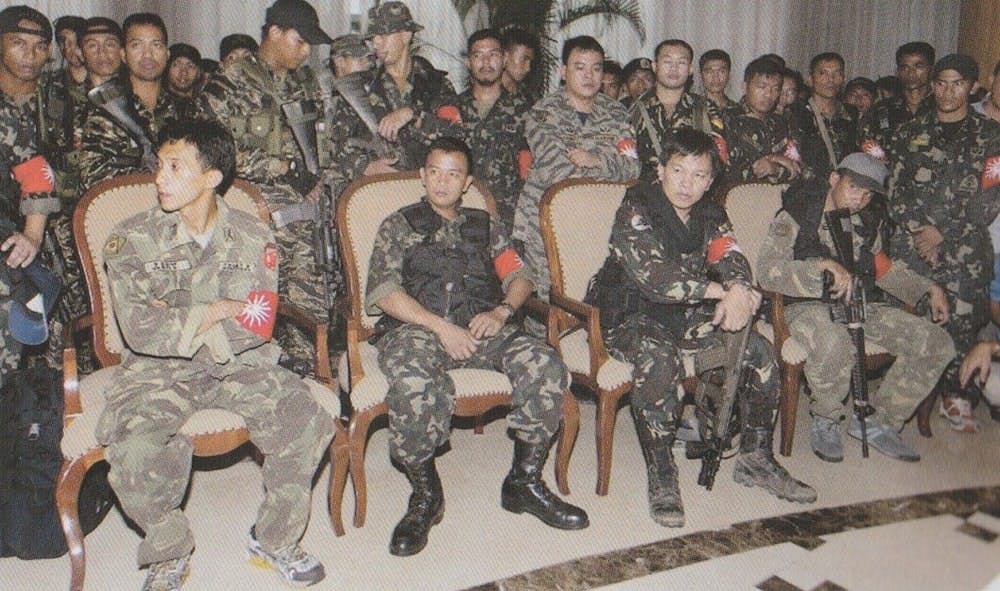 The Marines discuss their plan of attack during the Oakwood Mutiny in 2003
The Marines discuss their plan of attack during the Oakwood Mutiny in 2003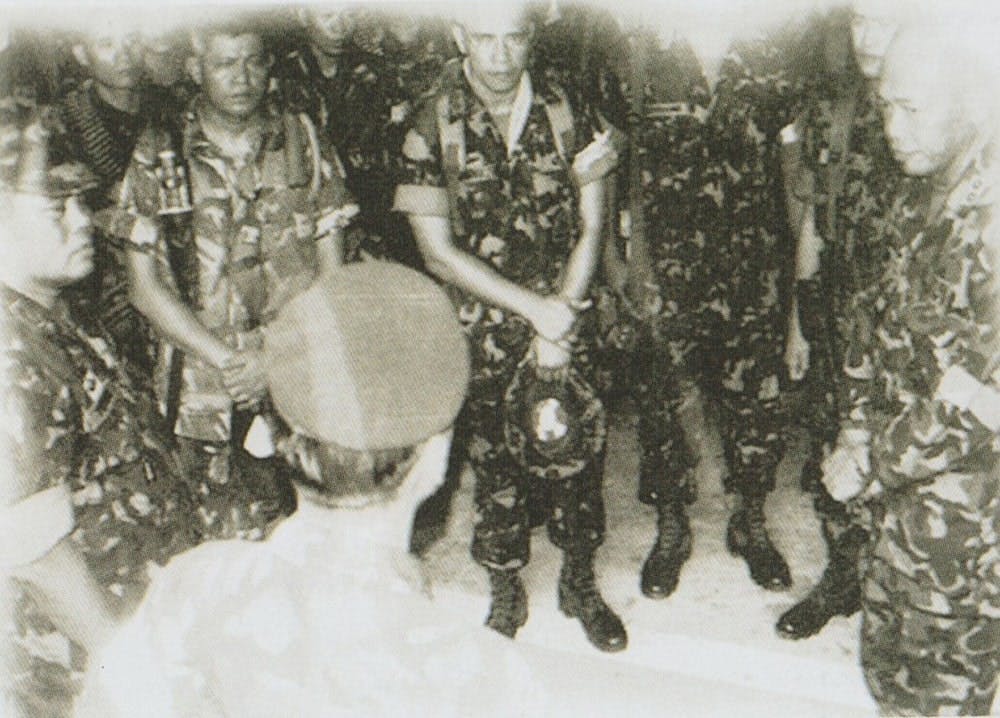
On July 23, 2003, a rebel soldier group named 'Magdalo" led by Capt Gerardo Gambala and Lieutenant Senior Grade Antonio Trillanes IV staged a coup at Oakwood Premier, Ayala in distress of the Arroyo Administration. The Marines poised to stop the Magdalo and wore white armbands to spot themselves from the rebels. After the talk with the government negotiating panels, the rebels forfeited and returned to their posts. Thus, having a bloodless mutiny in Oakwood.
2006
Unknown Date
Composition of PMC Roadmap 2024
The Philippine Marine Corps first started writing the PMC Roadmap 2024, Book I during this year; It lays the foundation for the development of the organization structure, human resources, capabilities, and other support systems to achieve the goal in obtaining capabilities for internal security operations, to support nation building and long term territorial defense.
FEBRUARY 2006
Relieved From Duty
On February 27, 2006, PMC Commandant Major General Renato Miranda was relieved of his duty due to allegations of a coup attempt against the government. Colonel Ariel Querubin had the marine camp barricaded in protest of the relief. Confusion extended the fight but the tension died down when Brigadier General Nelson Allaga had intimate talks with Querubin and the other Marines.
2007
Unknown Date
Lakad Tanim Para Sa Bata
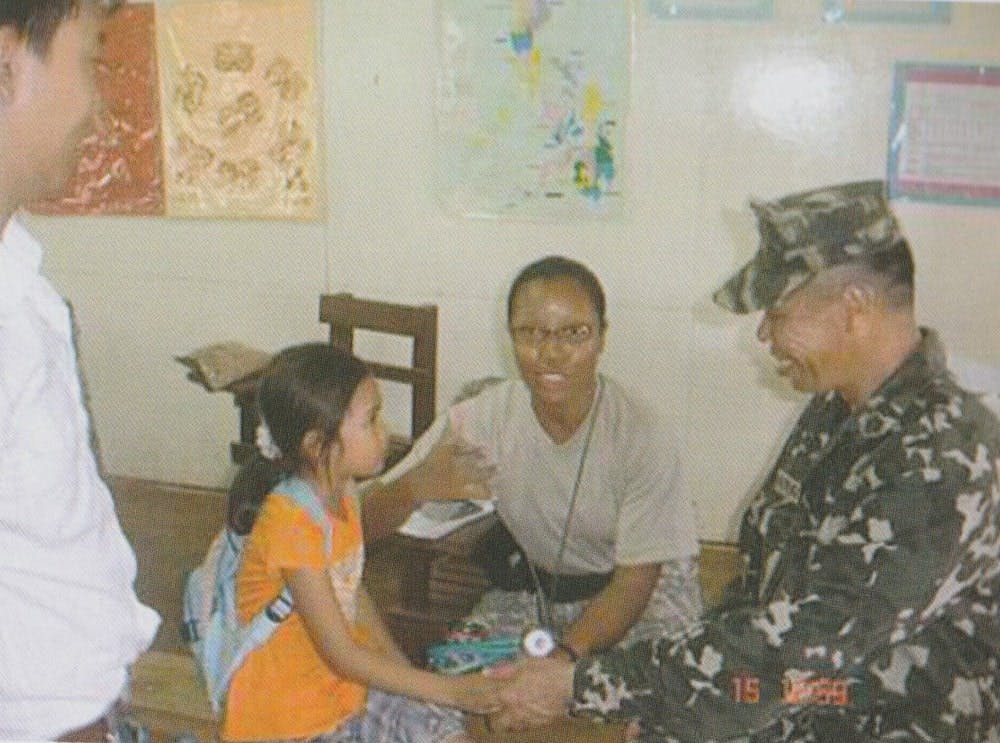 Marines conducting a DENCAP in Basilan
Marines conducting a DENCAP in Basilan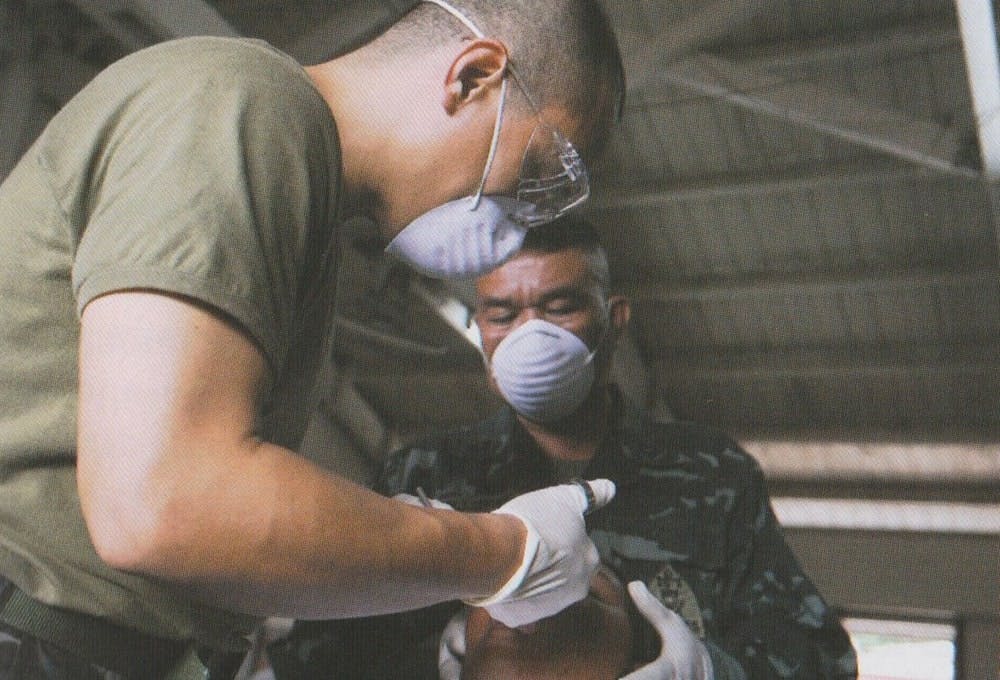
The 1st Marine Brigade continued with its CMO activities and sponsored a 'Lakad Tanim Para sa Bata" walkathon in Mt. Cobung, it is intended to restore the deforested Mt. Cobung. They were able to plant and grow narra samplings, gmelina, and mangrove swamps in the area.
JULY 2007
Tree Planting in Basilan
On July 3, 2007, the 1st Marine Brigade continued its CMO activities and planted trees in Basilan while also celebrating the Marine Brigade's foundation day.
NOVEMBER 2007
Return of the Magdalo Group
On November 29, 2007, the Magdalo group from the 2003 Oakwood Mutiny returned and started a siege in Makati heeding a call for then-President Arroyo's resignation. The Philippine Marines and Philippine Military both had a fiery assault on the Magdalo groups, with the latter surrendering to protect the civilians and journalists trapped in the event.
2008
OCTOBER 2008
Civic Action in Basilan
On Oct 15, 2008, The 3rd Marine Brigade provided Medical and Dental Civic Action to (This needs further research)
2009
APRIL 2009
Abduction of Members from Red Cross
On January 15, 2009, the ASG led by Albader Parad abducted 3 members of the International Committee of the Red Cross. The group members were rescued one by one by General Sabban in April 2009.
Unknown Date
Welcoming of Female Marines
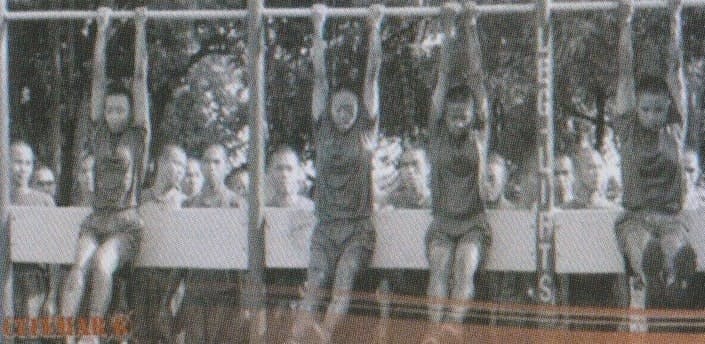 The first female recruits of the PMC entered in 2009 (2)
The first female recruits of the PMC entered in 2009 (2)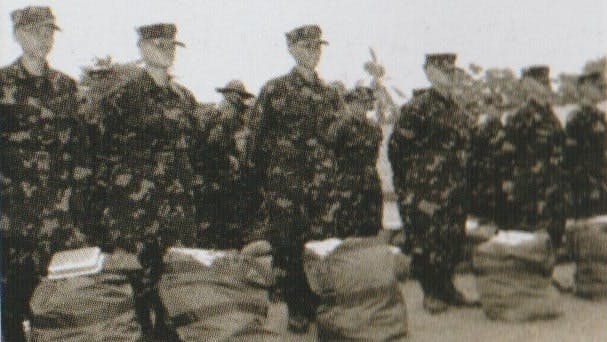 The first female recruits of the PMC entered in 2009 (3)
The first female recruits of the PMC entered in 2009 (3)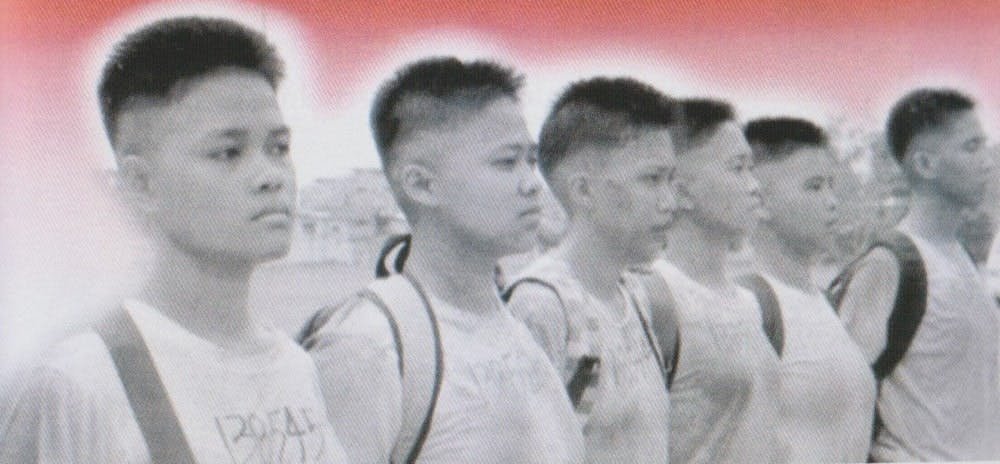
The Philippine Marine Corps welcomed its first female candidate soldiers.
Unknown Date
More Civil-Military Operations
Major General Sabban became the commandant of PMC in 2009 and declared that the Corps will conduct its operations at a ratio of 80% Civil Military Operations and 20% combat operations or direct military.
2010
FEBRUARY 2010
Encounters with ASG Continue
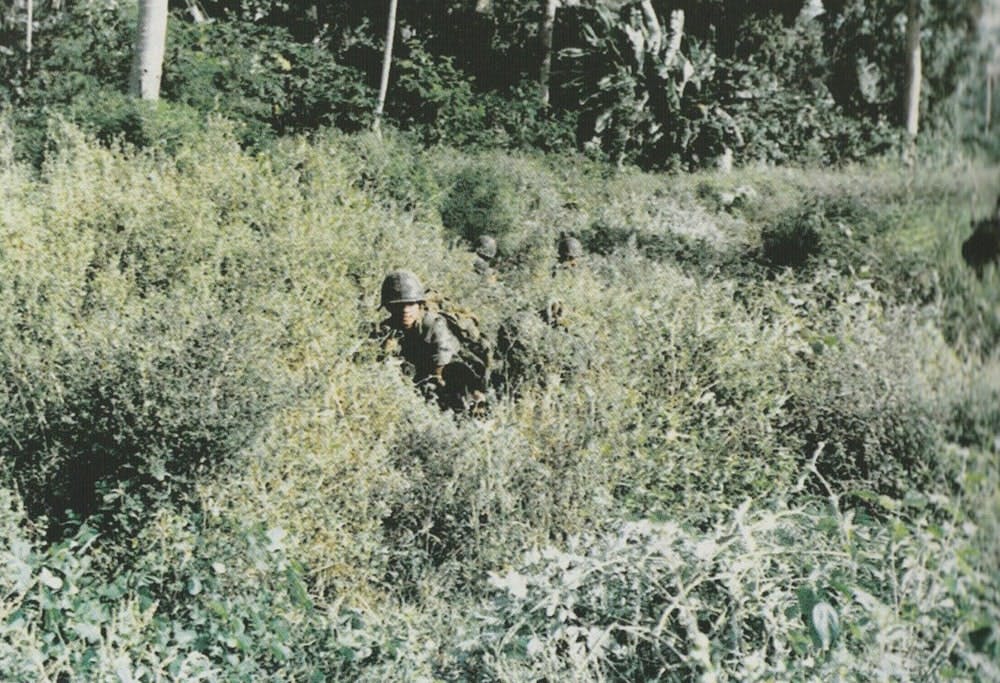 Marines carry the cadaver of Albader Parad after the encounter
Marines carry the cadaver of Albader Parad after the encounter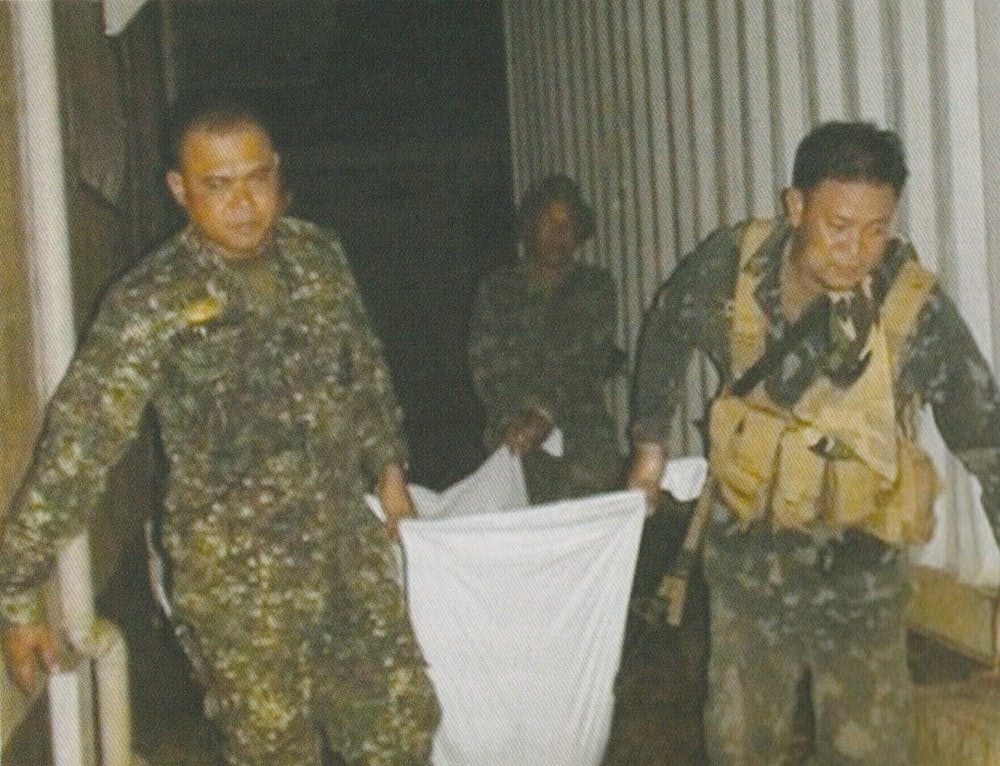
On February 21, 2010, the 4th Marine Company together with Special Operations Platoons of Headquarters and Service Company encountered around 40 ASG members led by Albader Parad in Sulu. The ASG withdrew and Parad was killed.
Unknown Date
Introduction of Football for Peace Festival
In 2010, The PMC introduced the 'Football for Peace Festival" in Mindanao for children to engage in football sports with the goal to bridge peace among the locals but has not yet launched until 2012.
Unknown Date
Growth of Female Marines
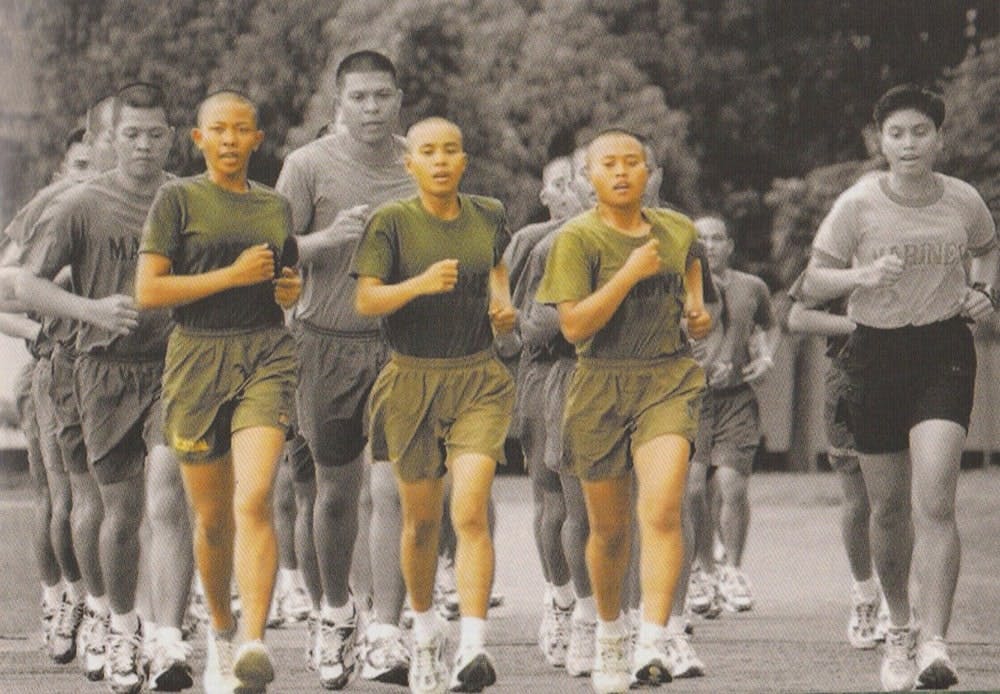 Female Marines undergo training together with their male counterparts (2)
Female Marines undergo training together with their male counterparts (2)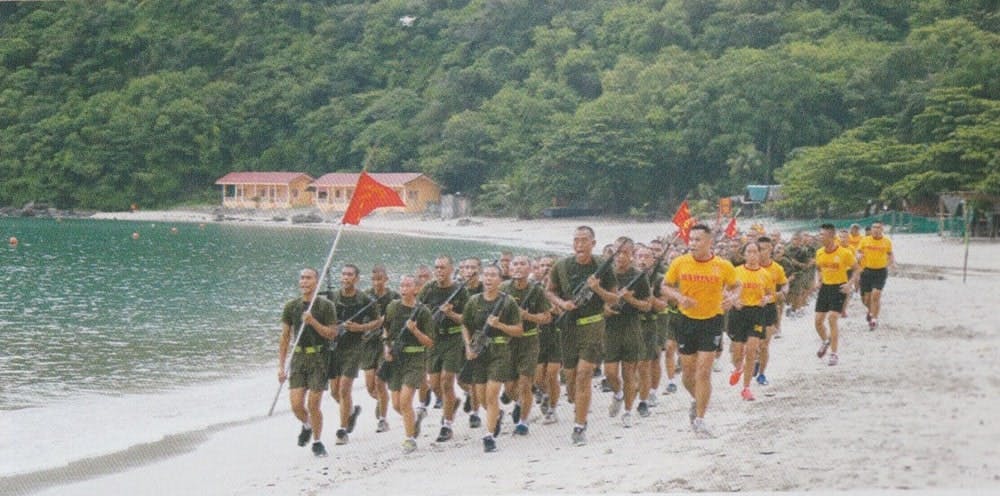 Female Marines in full combat gear
Female Marines in full combat gear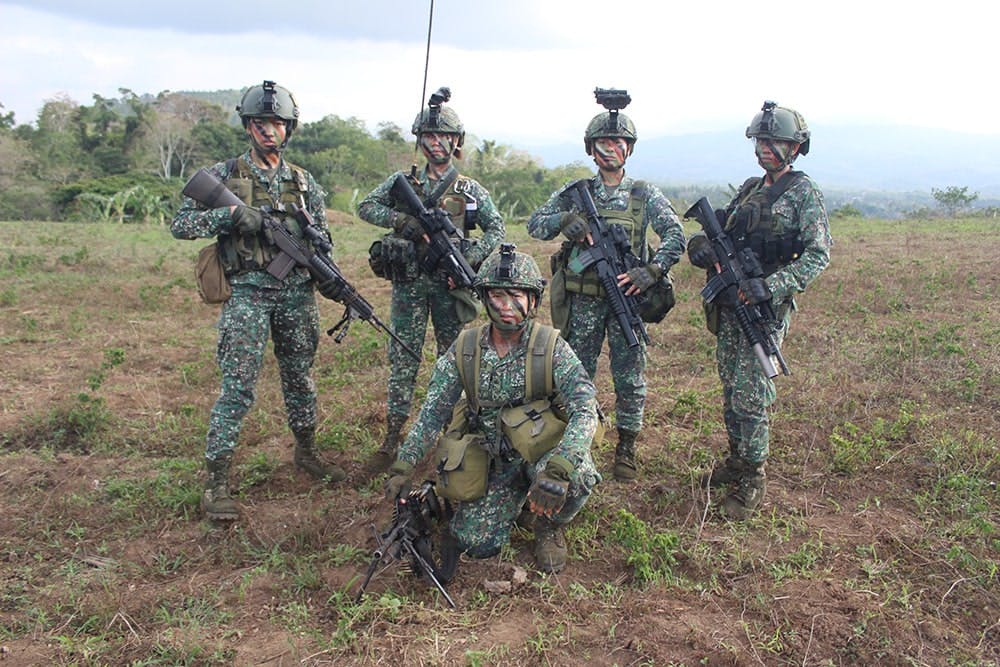 Female Marines in full combat gear
Female Marines in full combat gear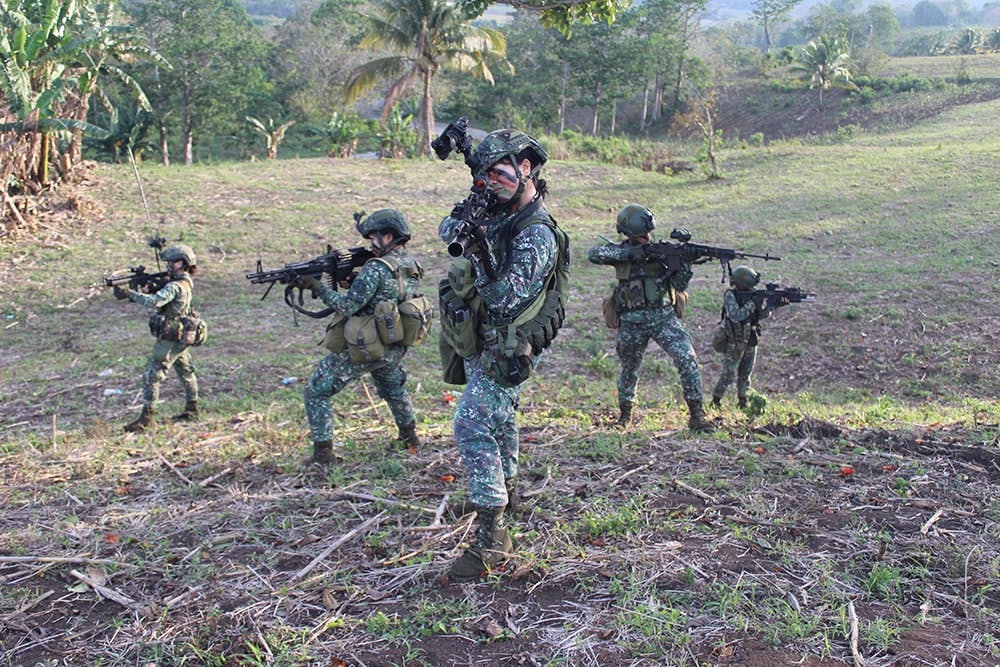
The PMC grew a total of 215 female enlisted personnel in a year since its acceptance of female soldiers last 2009. The female marines were deployed to different units and had the same rigorous training as their male counterparts.
Unknown Date
Implementation of IPSP
The AFP and PMC introduced the Internal Peace and Security Plan (IPSP) which changed the ways of Civil-Military Operation activities. Instead of purely military solutions in the past, it's now people-centered security with the involvement of government agencies, LGUs, NGOs, and also the community.
Unknown Date
Deactivation of the 4th Marine Brigade
The 4th Marine Brigade (reserve) was deactivated in light of the creation of another three regular Marine Brigade Headquarters.
2011
JANUARY 2011
Revival of TAVEMCO
MBLT-8 helped in the revival of Tagburos Aqua Venture Multipurpose Cooperatives (TAVEMCO) created for the community-based forest management of DENR. MBLT-8 assisted in the documentation process and tapped the BFAR to conduct workshops on Seaweed farming for people from Tagburos from January 19 to 22, 2011.
JULY 2011
Activation of the Three Marine Brigade
- The 7th Marine Brigade (Reserve) for Luzon was activated on July 9, 2011, and the acting commander assigned was Colonel Benjamin I. Espiritu.
- Meanwhile, the 8th Marine Brigade (Reserve) for the Visayas was activated on July 23, 2011, with Lieutenant Colonel Tomas R. Osmeña as its acting commander.
- Consequently, the 9th Marine Brigade (Reserve) for Mindanao was also activated, and the acting commander was Lieutenant Colonel Marciano M. Guinilac. These marine reserve units are intended to integrate regular PMC unit war-fighting and assist in rescue operations during disasters.
2012
APRIL 2012
Celebration of Football for Peace
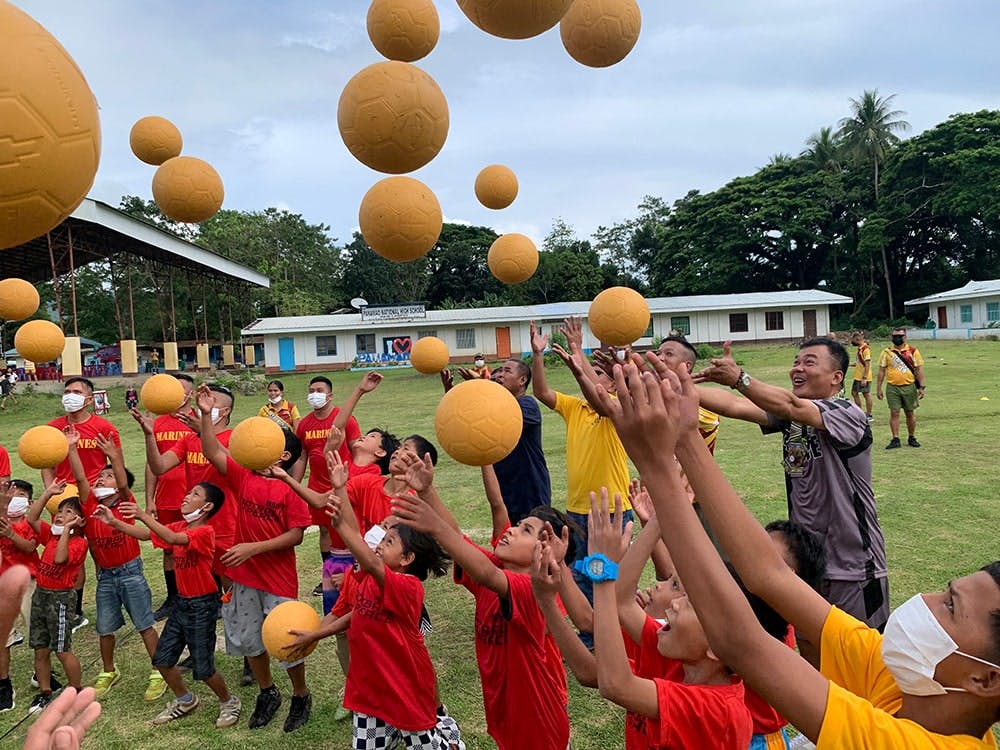 Kids throwing yellow balls during the Football for Peace Festival
Kids throwing yellow balls during the Football for Peace Festival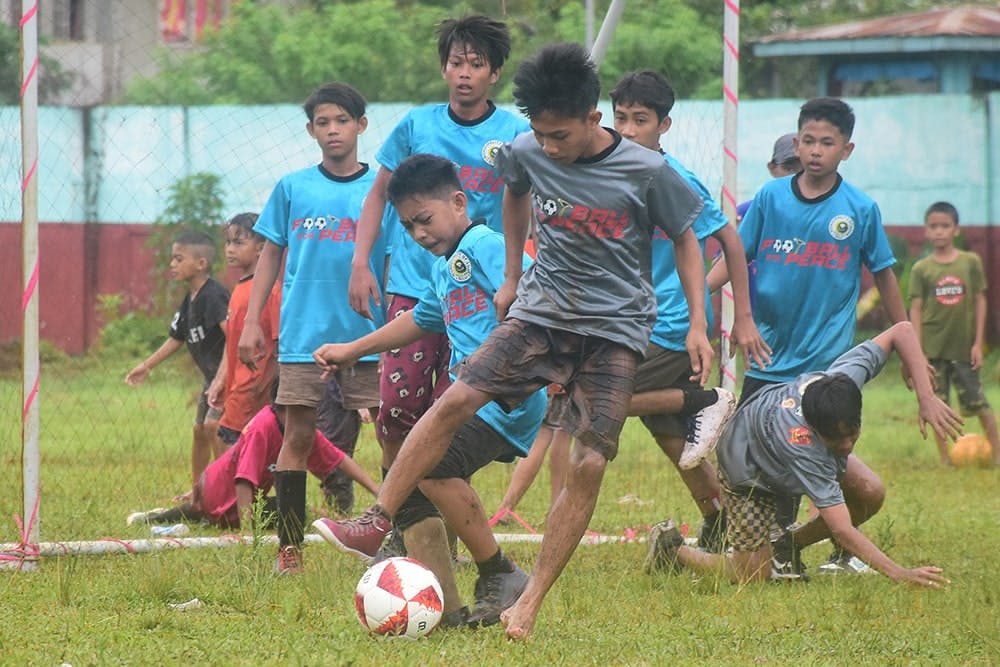 A grade schooler kicks the ball during the Football for Peace Festival
A grade schooler kicks the ball during the Football for Peace Festival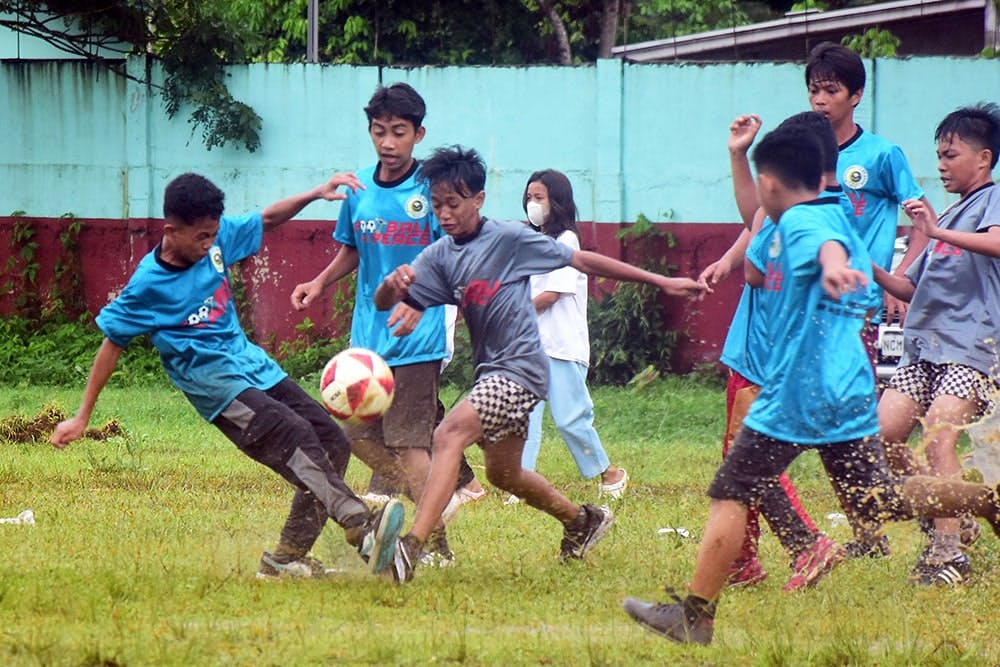
The Football for Peace Festival introduced by PMC was first celebrated in Manila on April 12, 2012. The event took place for the first time at Fort Bonifacio where 77 kids participated in the festival. They were given soccer shoes and real jerseys.
Unknown Date
Literacy for Peace and Development
MBLT-5 initiated the "Literacy for Peace and Development" or LIPAD in Tawi-Tawi with Senator Rasul and her daughter, Amina. The local residents were taught to read, write and learn basic arithmetic for three months.
Unknown Date
Assistance during Typhoon Pablo
The 7th Marine Brigade deployed to various areas in Luzon and assisted victims of Habagat and Typhoon Pablo. Later, the marines were able to secure 5 million pesos from the Latter-Day Saints Charities to help fund the Philippine Navy's project to construct 3 evacuation and multi-purpose centers that have been hit heavily by Typhoon Pablo in Davao Oriental.
Unknown Date
Ready Reserve Unit Award by Philippine Navy
Under the watch of Brigadier General Espiritu, the 7th Marine Brigade became the most awarded ready reserve unit in the Philippine Navy and was awarded for 6 straight years during 2012-2017.
Unknown Date
HADR in Hagonoy
Marine reservists conducted Humanitarian Assistance Disaster and Relief (HADR) for the people in Hagonoy, Bulacan and led by Brigadier General Espiritu.
2013
Unknown Date
Distribution of School Supplies
The marine reserve conducted CMO activities and gave school kits in Cotabato, Maguindanao, and Sultan Kudarat.
Unknown Date
Ready Reserve Unit Award by AFP
Also under the watch of Brigadier General Espiritu, the 7th Marine Brigade became the most awarded ready reserve unit in the Armed Forces of the Philippines for 3 straight years during 2013-2015.
APRIL 2013
2nd Football for Peace Festival
After the success of the first Football for Peace in 2012, the 2nd PMC Football for Peace Festival took place and around 150 kids participated in the festival.
SEPTEMBER 2013
The emergence of Zamboanga Siege
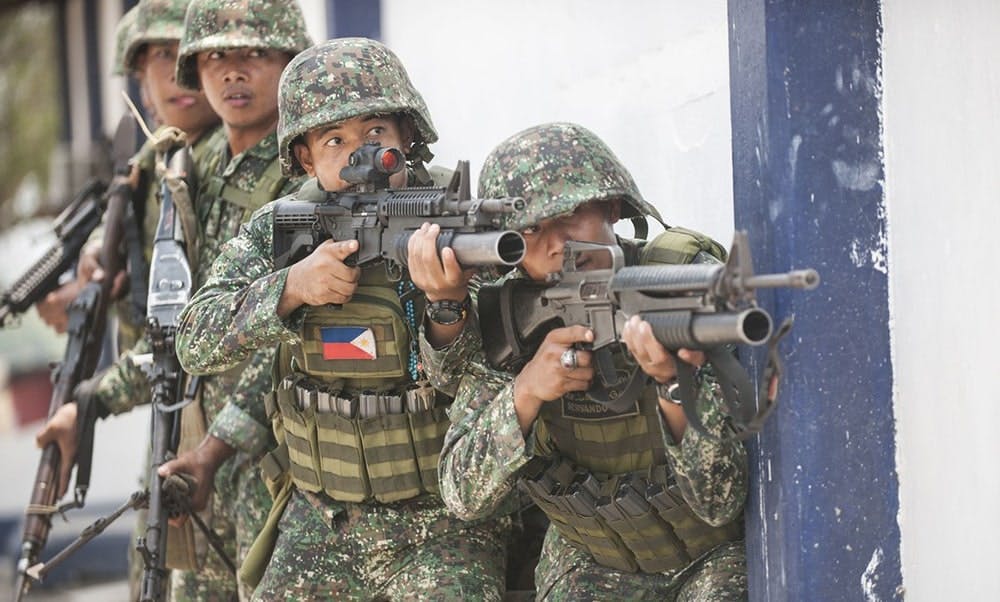 Marines conduct clearing ops in Zamboanga City
Marines conduct clearing ops in Zamboanga City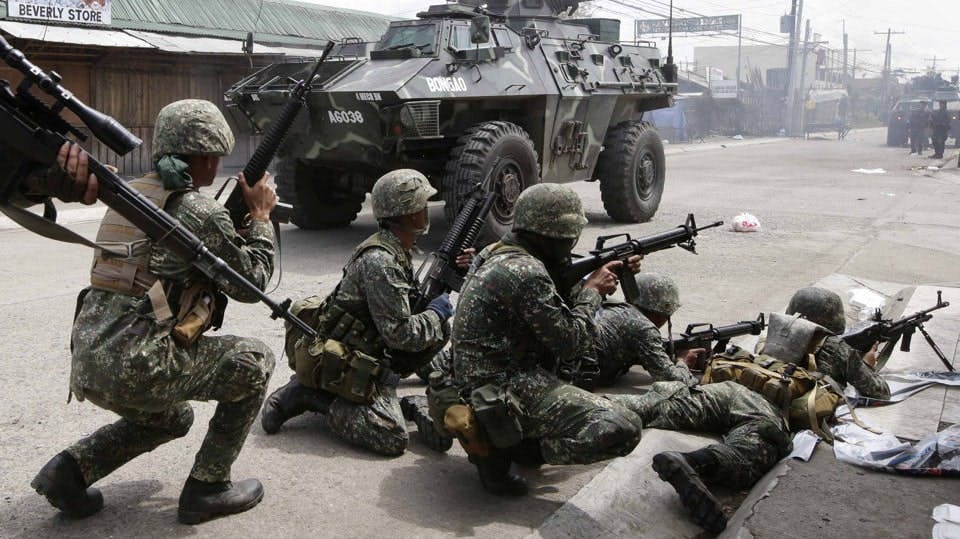 A Marine sniper positions himself to get the best shot against rogue MNLF
A Marine sniper positions himself to get the best shot against rogue MNLF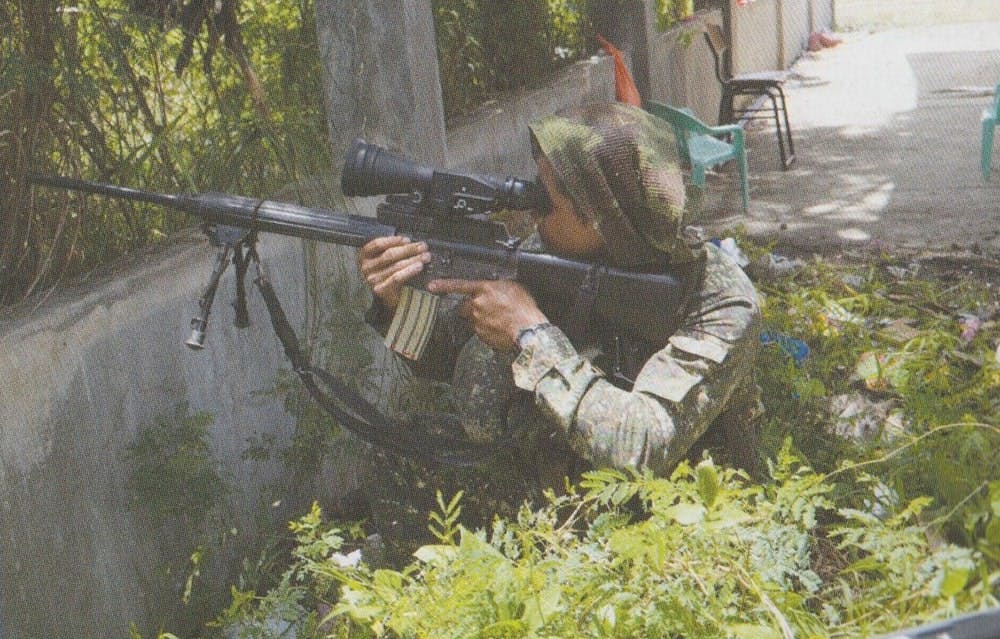 Marine convoy in Zamboanga City
Marine convoy in Zamboanga City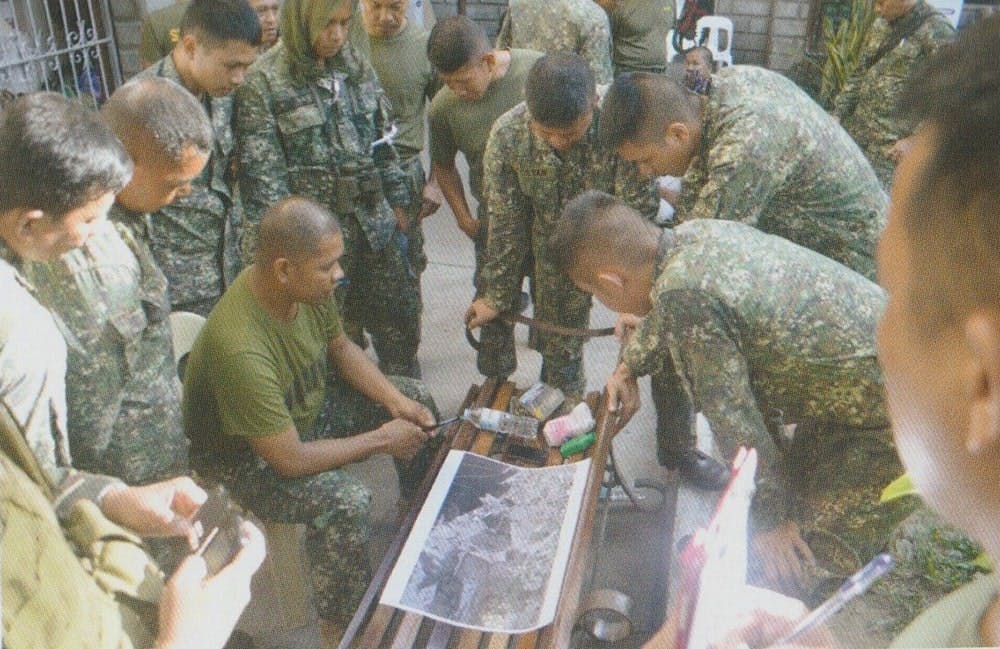 Marine marching in the Battle of Zamboanga
Marine marching in the Battle of Zamboanga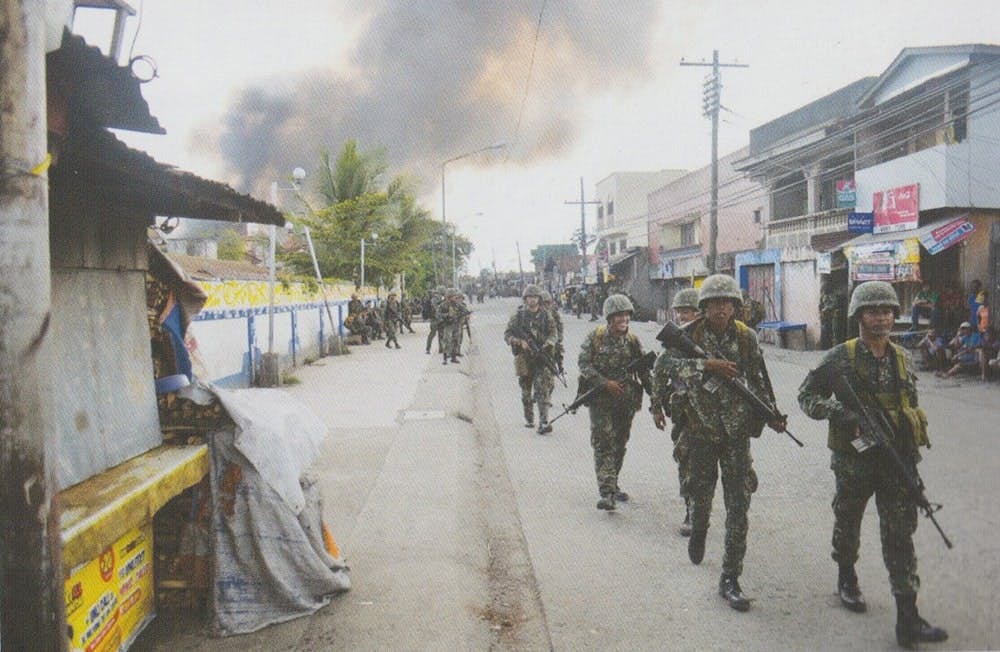 Marines take cover to hide from direct fire
Marines take cover to hide from direct fire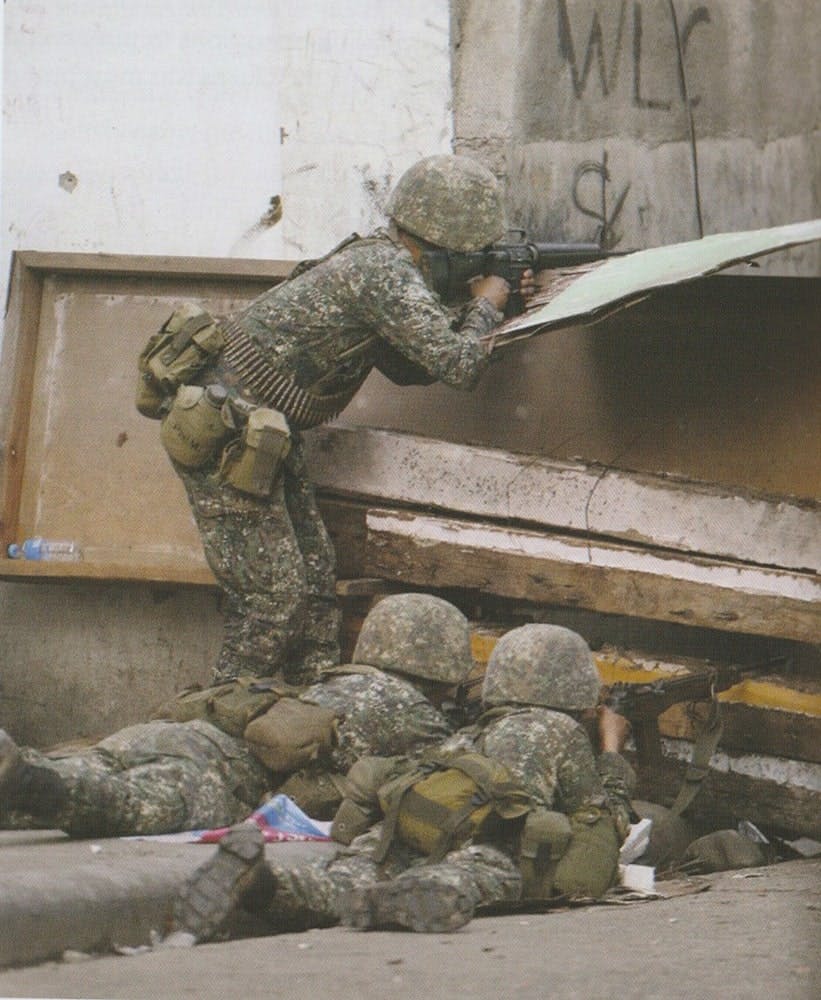 Planning during the Zamboanga Siege
Planning during the Zamboanga Siege Snipers scrutinizing the area to assure that the enemy has nowhere to go
Snipers scrutinizing the area to assure that the enemy has nowhere to go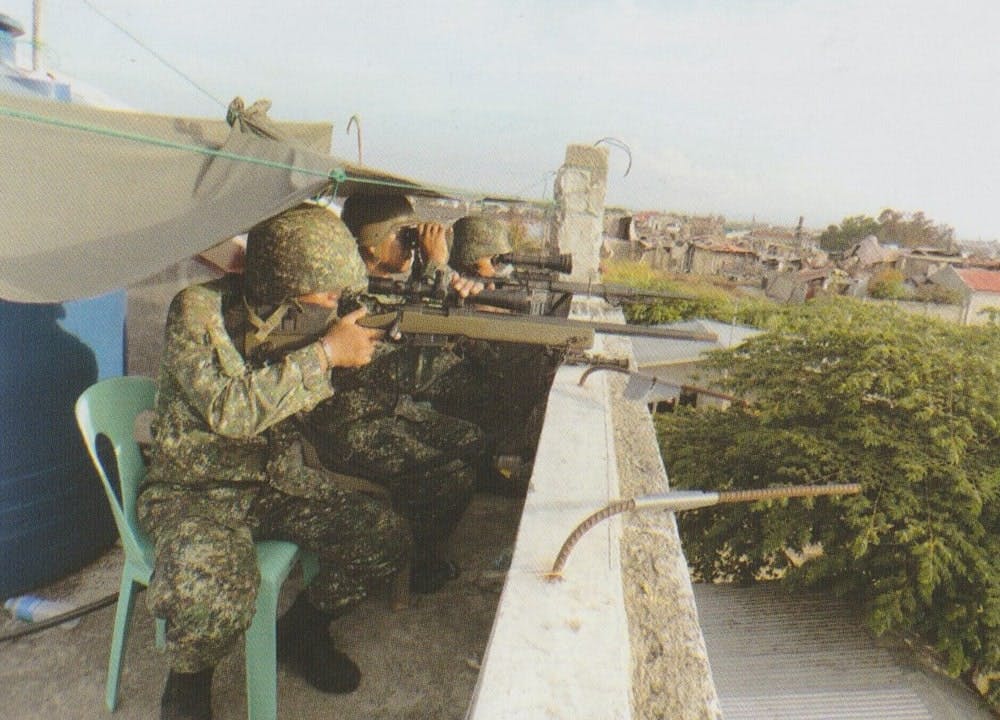
- The Zamboanga Siege started on September 9, 2013, due to the armed conflicts between the government forces and the rogue MNFL members from the Misuari team. They took over 5 barangays and held hostages. The government quickly redeployed the MBLT-3 to rescue Zamboanga.
- On September 30, 2013, the crisis was declared resolved, but the MBLT-3 continued to patrol 3 barangays and conducted internal peace and security plans in Zamboanga city.
NOVEMBER 2013
Intervention on Super Typhoon Yolanda
When Super typhoon Yolanda hit the city on November 6, the 7th Marine Brigade and 11th Marine Brigade deployed to various areas in the country and assisted in the relief and rescue operations.
DECEMBER 2013
Christmas Caroling in Zamboanga City
The 3rd Marine Battalion went Christmas caroling to generate funds to host a Christmas party for children in evacuation centers in Zamboanga City. It was attended by 200 kids who enjoyed food, and games and took home Christmas gifts.
2014
Unknown Date
Assistance during Typhoon Mario
When typhoon Mario struck the country, The 7th Marine Brigade deployed to various areas in Luzon and assisted the victims.
2015
Unknown Date
Assistance during Typhoon Nona
The 7th Marine Brigade positioned itself in various areas in Luzon and assisted the affected victims during Typhoon Nona.
Unknown Date
Balikatan and PHIBLEX
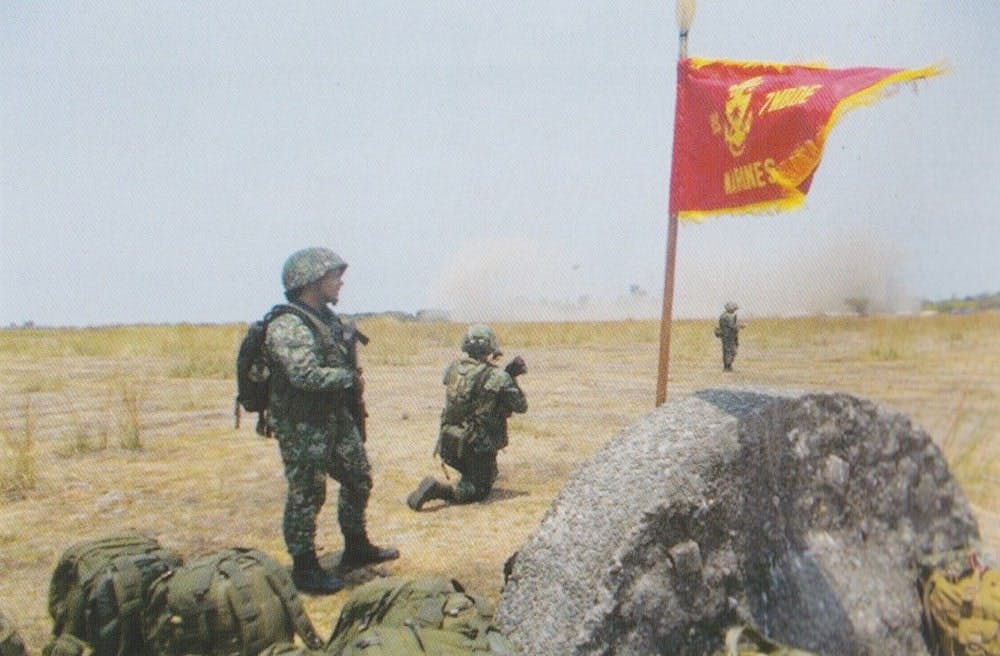 Members of the PMC and USMC conduct a storytelling activity during the execution of PHIBLEX Exercises
Members of the PMC and USMC conduct a storytelling activity during the execution of PHIBLEX Exercises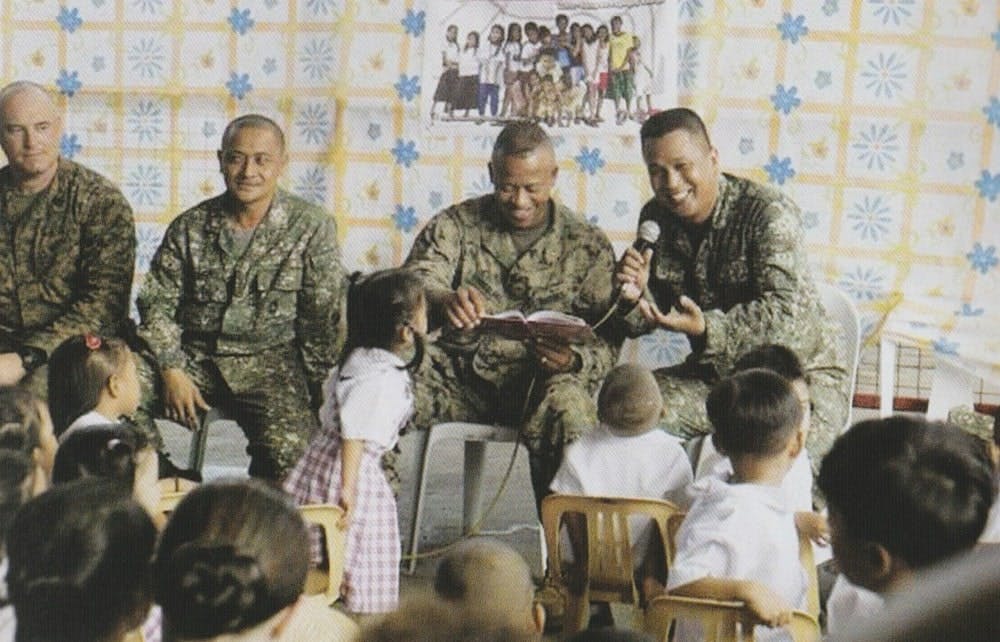
The 7th Marine Brigade also participated in major exercises such as the Balikatan and PHIBLEX.
2016
Unknown Date
Participation in Brigada Eskwela
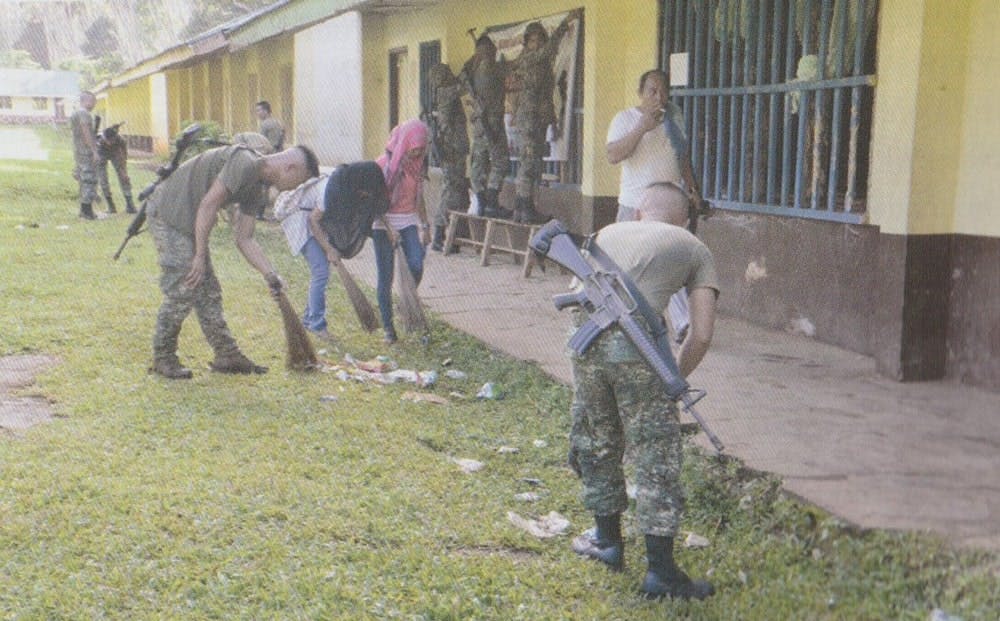 MBLT-1 participates in Brigada Eskwela 2016
MBLT-1 participates in Brigada Eskwela 2016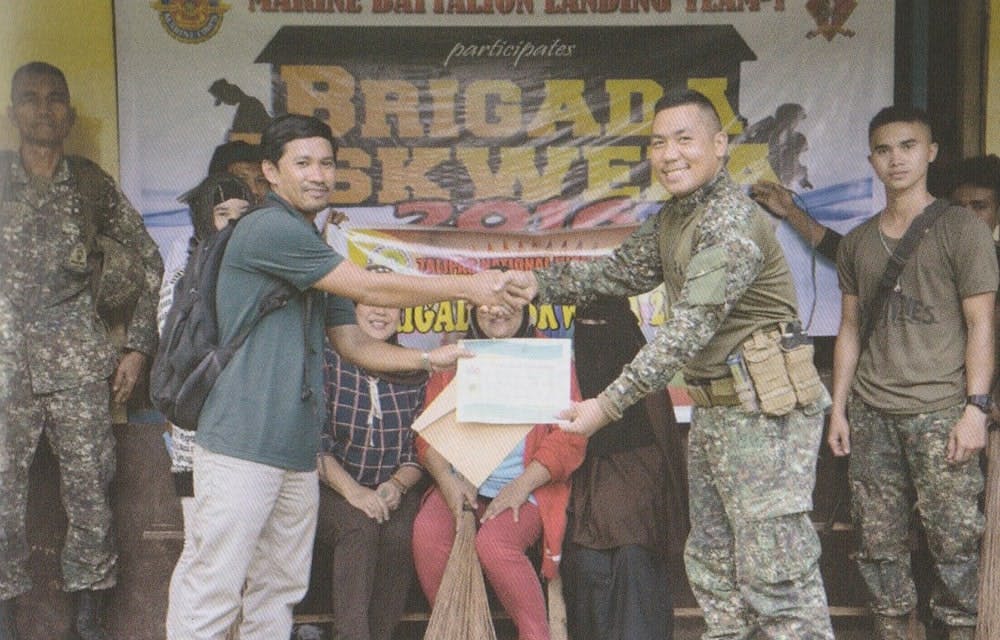
The Internal Peace and Security Plan further continues with MBLT-1 participating in various CMO activities such as attending Brigada Eskwela in 2016 to help clean school premises in the community.
2017
MAY 2017
Long Turmoil of Marawi Siege
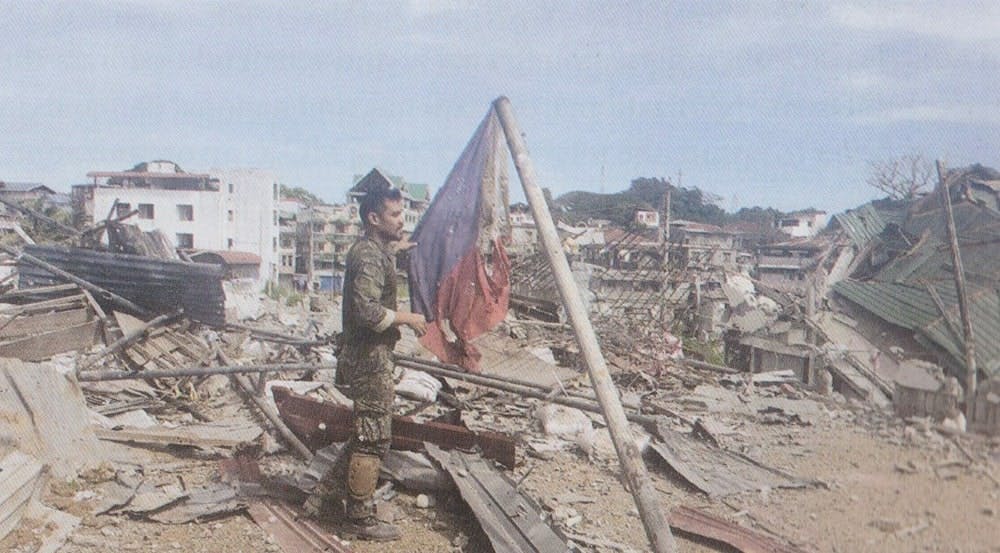 Marine corpsmen give first aid to the wounded warriors during the Marawi Siege
Marine corpsmen give first aid to the wounded warriors during the Marawi Siege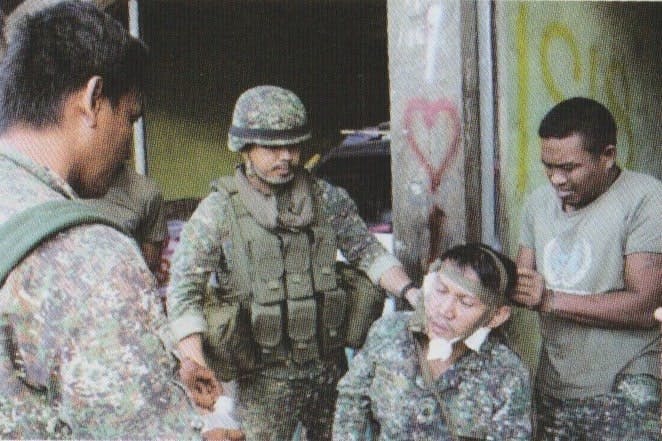 Marine corpsmen give first aid to the wounded warriors during the Marawi Siege
Marine corpsmen give first aid to the wounded warriors during the Marawi Siege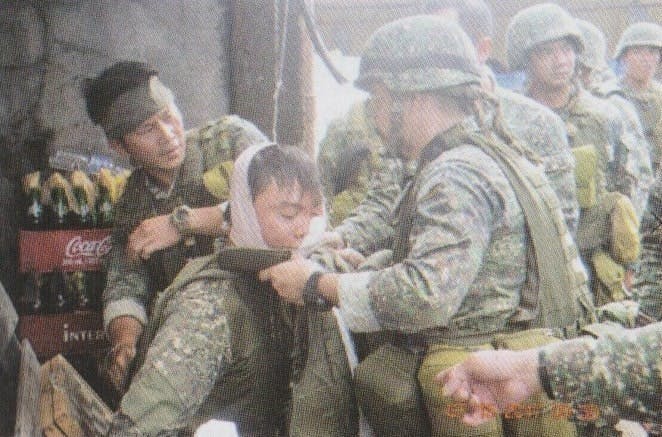
On May 23, 2017, the Marawi Siege emerged and was headed by the Maute group with the alliance from ASG emir Isnilon Hapilon during the presidency of Rodrigo Duterte. After unsuccessful operations to capture Hapilon and the counterattacks of the Maute-ISIS Group in the city, the Marines sent one marine brigade with three marine battalions led by Brigadier General Melquiades Ordiales and deployed the Marine Special Operations Group to end the siege.
JUNE 2017
Recovery of Mapandi Bridge
- The Marines were tasked to recover the Mapandi Bridge (which spans the Agus River and leads to Marawi City) from the Maute-ISIS group. On June 4, 2017, MBLT-7 was able to cross the bridge but was forced to pull back due to fierce enemy fire.
- On June 5, 2017, Marines led by 1st Lieutenant John Savellano recovered cash and checks worth millions, 29 hostages, 29 high-powered firearms, and various ammunition and explosives in a three-story concrete house used as a sniper-and-machine-gun nest by the enemies.
- On June 6-7, 2017, the Marines made a 2nd attempt to retake Mapandi Bridge and nearby areas of Lilod Madaya. The Marines crossed the bridge and secured a foothold in spite of the heavy enemy fire.
- On June 8, Marines increased the troops to cross Mapandi Bridge. They seized high-rise buildings on both sides of the street up to the third intersection.
- At the dawn of June 9, the Marines sustained heavy casualties: 13 were killed, 48 were wounded, and 1 was missing then declared killed in action. There were damages and losses to individual firearms, weapon components, tactical radios, and other CEIs.
AUGUST 2017
Clearing Operations in Marawi City
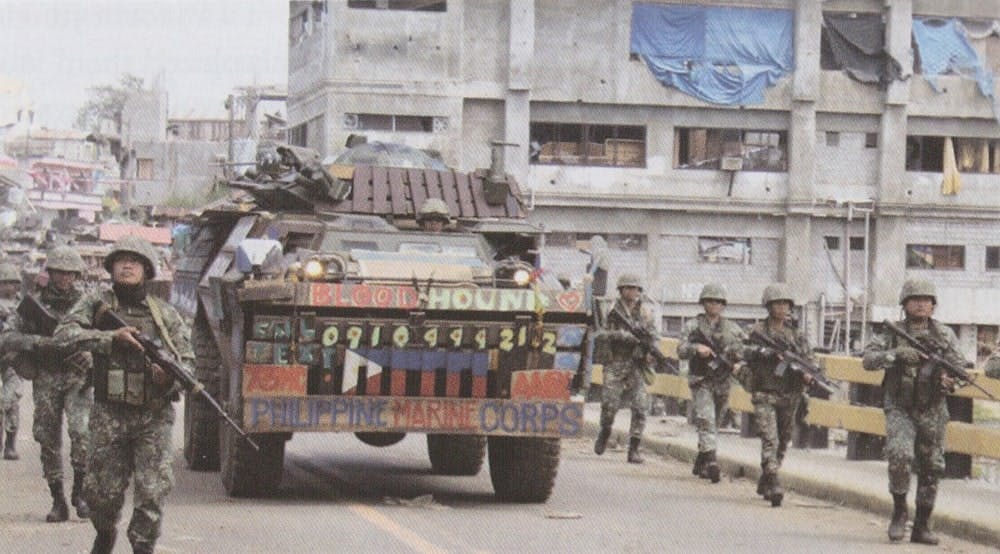 Marine in-combat during the Marawi Siege
Marine in-combat during the Marawi Siege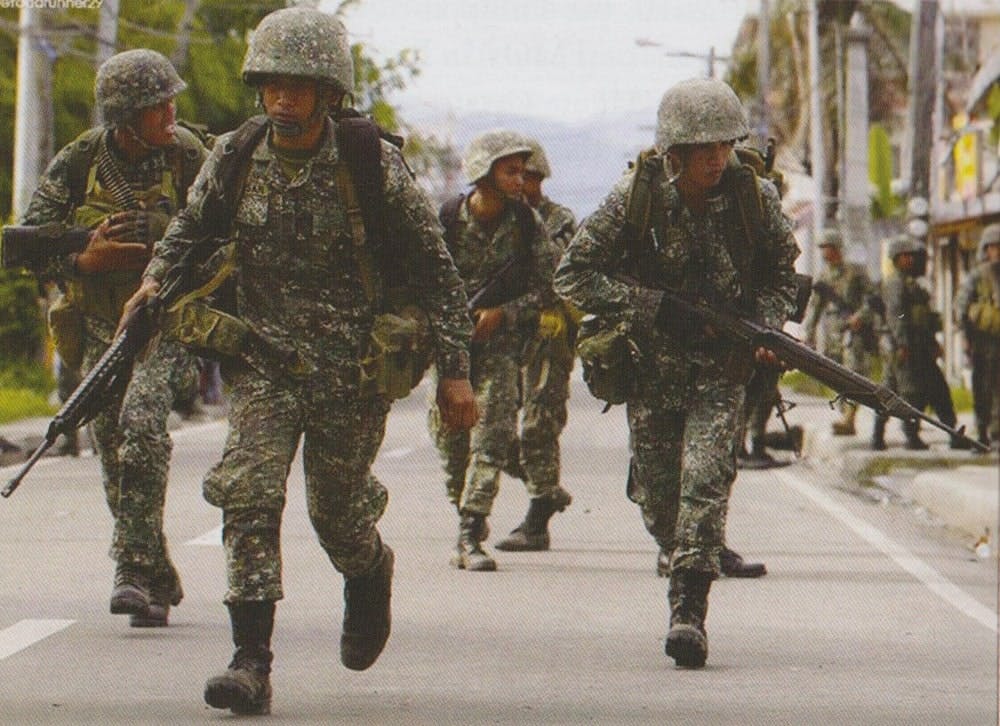
After the Mapandi Bridge was successfully retaken by the Marines, clearing operations were conducted but more engagements with the Maute-ISIS group intensified in the commercial centers of Marawi City during the third week of August.
Creation of PMC Board of Advisers
On August 31, the PMC Board of Advisers was created at the height of the ongoing Marawi battle. According to a letter sent by Major General Emmanuel Salamat, he recognized the wisdom of having advisers outside the institution to assist the Corps in achieving their amphibious missions.
SEPTEMBER 2017
Security of Masiu Bridge
- By the third week of September, the Maute-ISIS Group continued with firearms encounters with the Marines, resulting in heavy casualties mostly from the MBLT-7.
- On September 24, the Marines secured Masiu Bridge along with enemy strongholds along Gomisa Avenue and Abubakar As-Sedique Street.
OCTOBER 2017
Conclusion of the Marawi Siege
The Battle of Marawi finally ended after a 5-long month siege. Isnilon Hapilon and Omar Maute were killed on October 16. The following day, then-president Duterte declared that Marawi City was finally liberated. The Marine forces' decision to retake the 3 bridges leading into Marawi City enabled fellow forces to re-enter the city and defeat the enemy.
2018
MARCH 2018
Philippine Marine Corps Act
On March 6, Senator Sonny Angara authored SB no. 1731 entitled 'The Philippine Marine Corps Act", it supported the transformation of the PMC as an independent service branch of the AFP. Angara also highlights the crucial role of PMC during the Marawi Siege and deserves to be the fourth branch of the AFP.
2019
JANUARY 2019
Reactivation of 4th Marine Brigade
The 4th Marine Brigade (provisional) reactivated on January 2, 2019, replacing the Philippine Marine Force-Sulu which served as the command and control of the marine battalion in Sulu.
MARCH 2019
Launching of PMC Foundation Inc.
On March 7, 2019, the Philippine Marine Corps Foundation Inc. was formally launched as part of the PMC Board of Advisers projects. Its president is Lieutenant General Rustico Guerrero, AFP.
OCTOBER 2019
PMC Given Key Budgetary Unit
Instead of separating the PMC from the Philippine Navy, the Marines were given direct control of their finances by becoming a Key Budgetary Unit (KBU) status directly under the Department of Budget and Management effective in 2020.
2020
Unknown Date
Roadmap for the following years
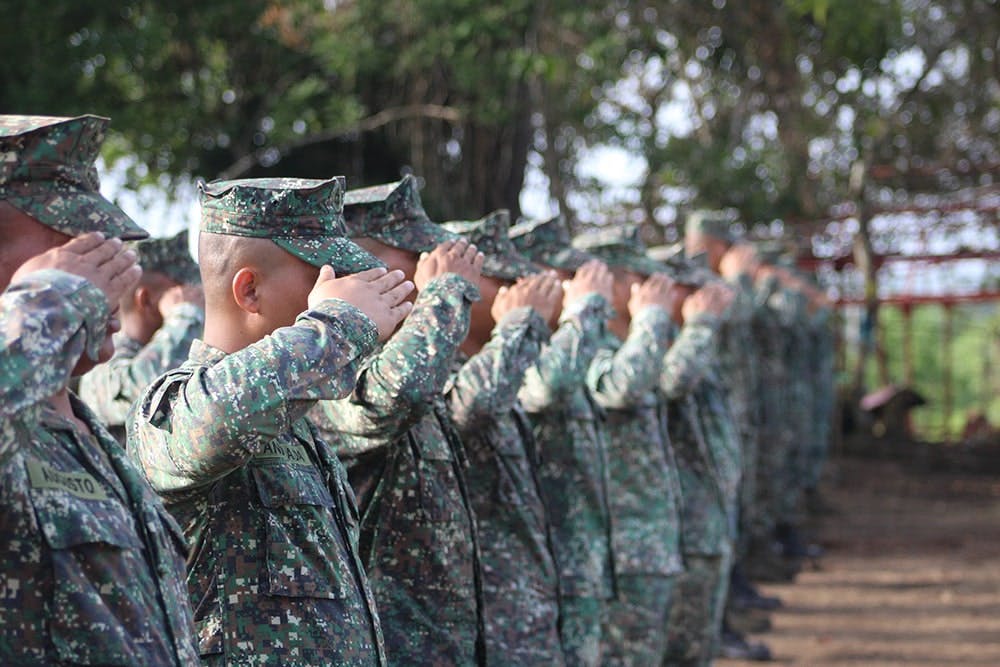 Marine salutes during formation, different angle
Marine salutes during formation, different angle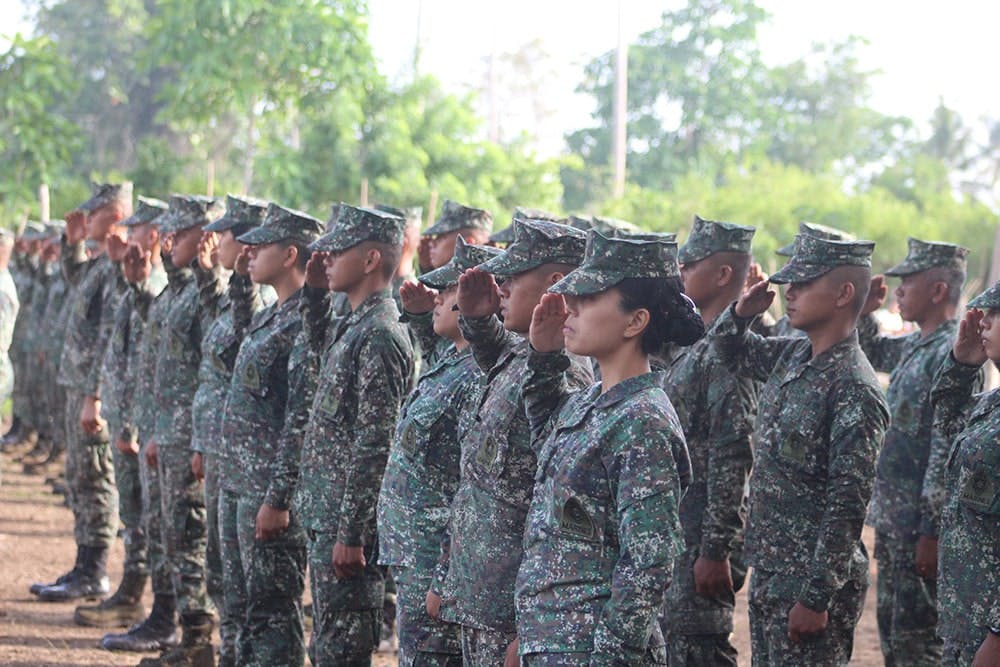 Marine raising right hand during formation
Marine raising right hand during formation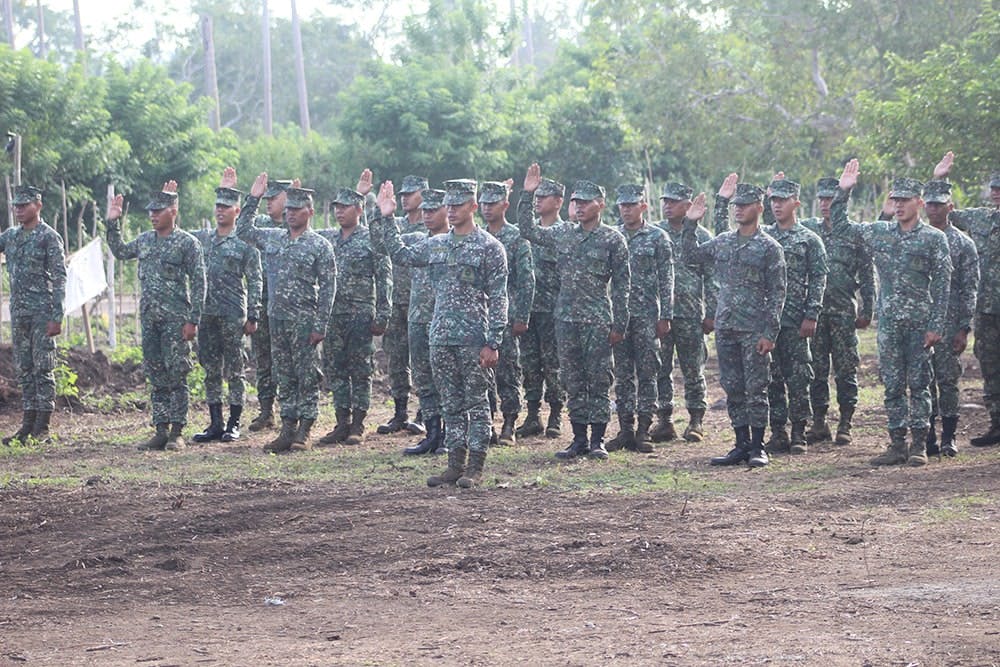 Marine battalion formation, in front of the HPMC
Marine battalion formation, in front of the HPMC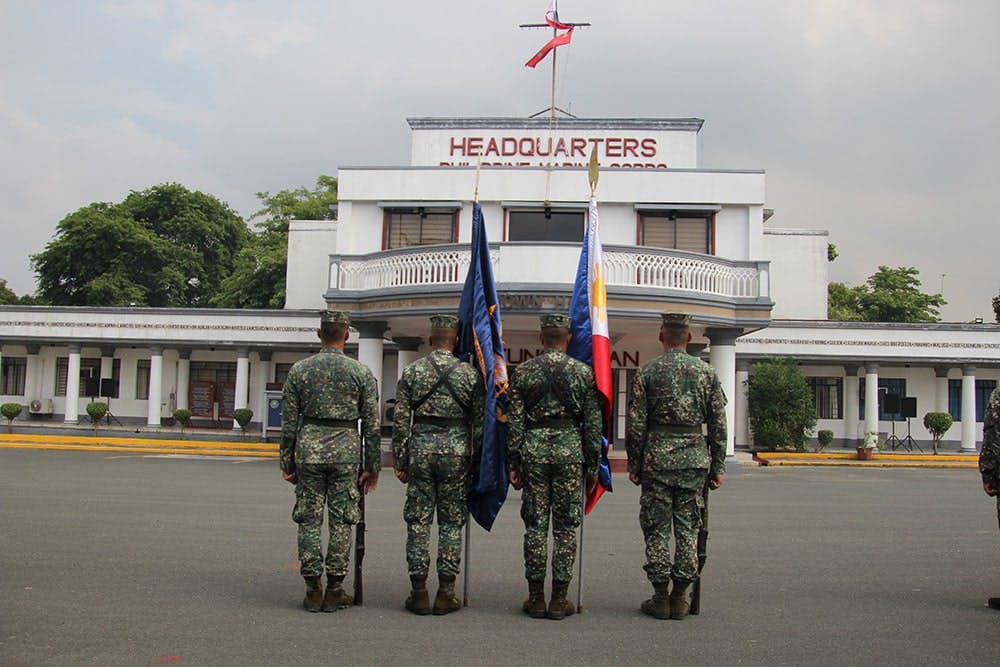
- The Philippine Marine Corps published the PMC Roadmap 2020, 2nd Edition. It is a stand-alone document that summarizes the PMC Roadmap 2024 written last 2006. It was necessary to realign the PMC's thrusts with the Philippine Navy Strategic Sail Plan 2020.
- The Philippine Marine Corps is currently writing and reviewing its PMC Roadmap 2028, aligning it with the Transformational Roadmap 2028.
To this day, The Philippine Marine Corps has journeyed through more than seven decades of duty to the country. The Corps has always believed that there is wisdom in winning the peace rather than going to war to defeat the enemy. It has been very effective in the conduct of Civil-Military Operations since then and communities have shown appreciation from the Corps' sincere efforts.
The PMC continues to embody their motto: Karangalan, Katungkulan and Kabayanihan (Honor, Duty and Valor) in every service they render. Finally, with the goal set in stone, the Philippine Marine Corps is ready to become the AFP's Premiere Force in Readiness and the Nation's Force of Choice.
Today
Current
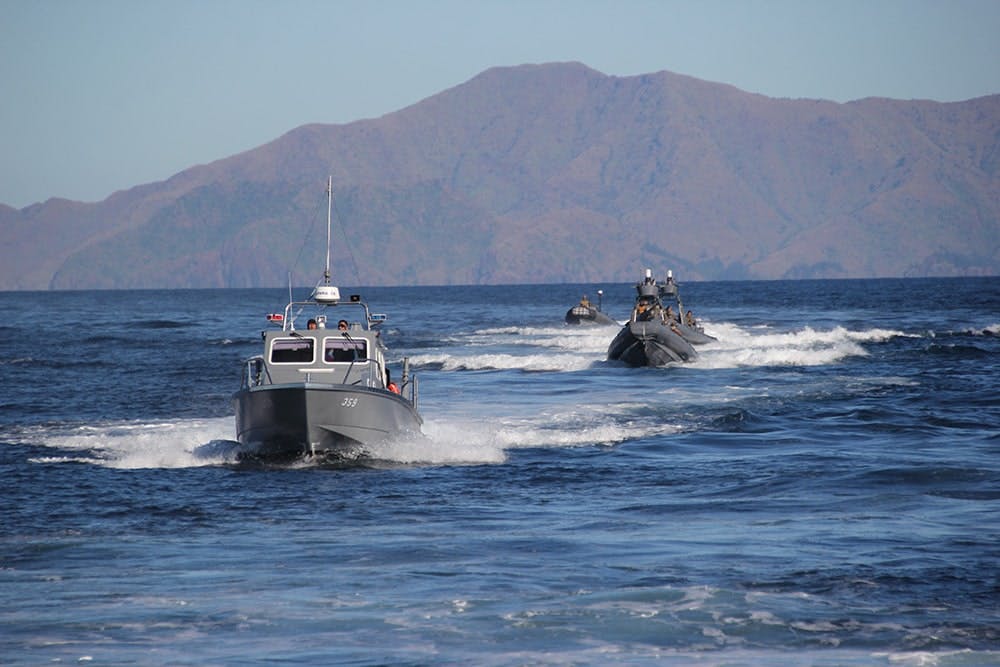 Philfleet during 85th AFP Anniversary
Philfleet during 85th AFP Anniversary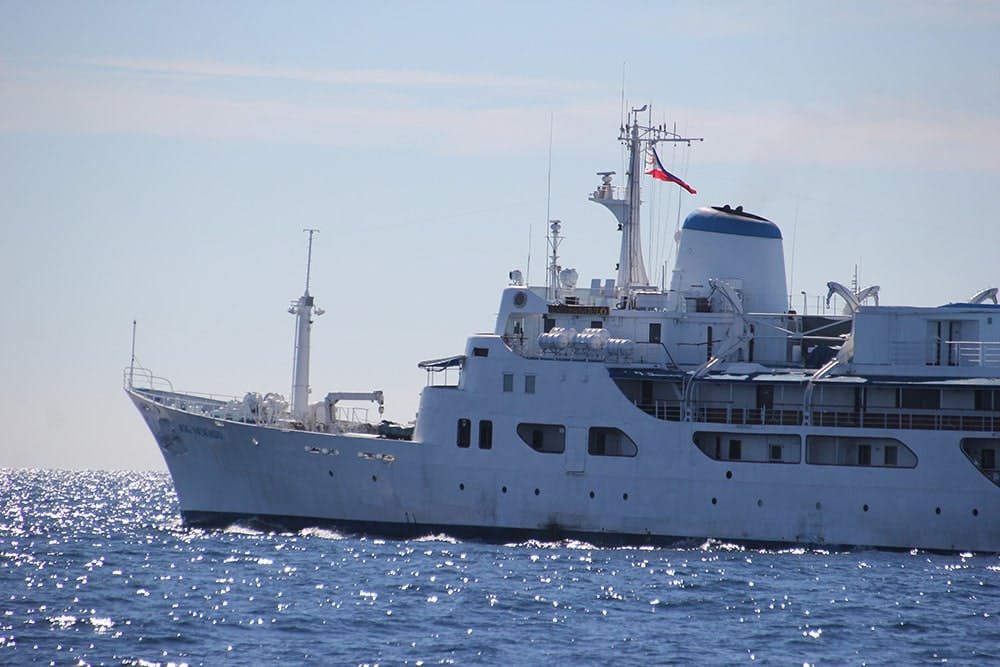 Marines and Philippine Navy ship Rehersal during 85th AFP Anniversary
Marines and Philippine Navy ship Rehersal during 85th AFP Anniversary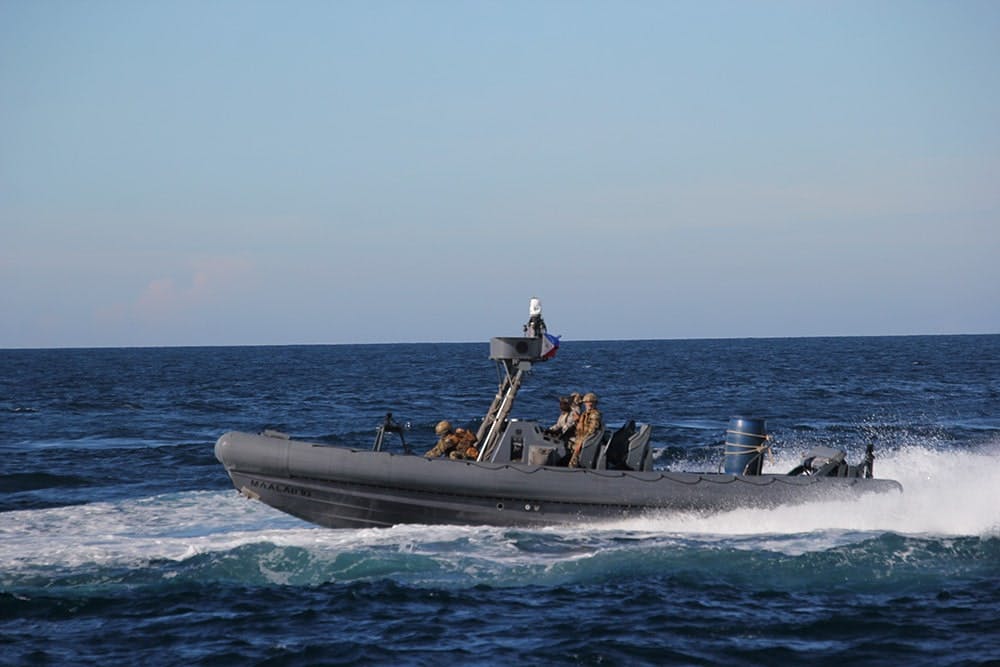
Philippine Marines Corps continues to do historical moments for the Philippines.
MOST READY
Maritime Soul, Occupational Health and Safety, Specialized Forces, Training as a routine grind. Relevant and Reliable, Ethos and Enthusiasm, Adaptive, Duty to God Country and People, Yield to the interest of the Corps.
Join the force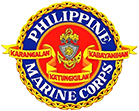
Philippine Marine Corps
© 2023 Official Philippine Marine Corps Website
